01/31/12
Filed under:
General
Posted by:
site admin @ 12:47 am
Enter your password to view comments
01/30/12
Filed under:
General
Posted by:
site admin @ 5:25 am
30 01 2012 LESSON 509Dhammapada Dhammapada Verses 51
and 52 Chattapani upasaka Vatthu
FREE ONLINE eNālandā Research & Practice
UNIVERSITY &
BUDDHIST GOOD NEWS LETTER through Through http://sarvajan.ambedkar.org
THE BUDDHIST ON LINE
GOOD NEWS LETTER
COURSE PROGRAM
LESSON 509
Practice a Sutta a Day
Keeps Dukkha Away
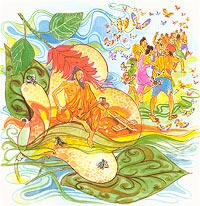
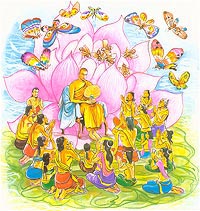
Verse 52. Good Words Profit Only Those Who Practise
Just as a gorgeous
blossom
brilliant and sweet-scented,
so fruitful the well-spoken words
of one who acts as well.
Explanation: A flower
may be quite attractive, alluring and possessing a brilliant hue. In addition,
it may be also full of fragrance. So is the person who is well spoken and
practises what he preaches. His words are effective and they are honoured.
Verse 51. Good Words Attract Only Those Who Practice
Just as a gorgeous
blossom
brilliant but unscented,
so fruitless the well-spoken words
of one who does not act.
Explanation: A flower
may be quite attractive, alluring. It may possess a brilliant hue. But, if it
is devoid of fragrance, and has no scent, it is of no use. So is the well
spoken word of him who does not practice it. It turns out to be useless.
Dhammapada Verses 51 and 52
Chattapani upasaka Vatthu
Yathapi ruciram
puppham
vannavantam agandhakam
evam subhasita vaca
aphala hoti akubbato.
Yathapi ruciram
puppham
vannavantam sagandhakam
evam subhasita vaca
saphala hoti kubbato.
Verse 51: Just as a
beautiful flower, lacking in scent, cannot give the wearer the benefit of its
scent, so also, the well-preached words of the Buddha cannot benefit one who
does not practise the Dhamma.
Verse 52: Just as a
flower, beautiful as well as fragrant, will give the wearer the benefit of its
scent, so also, the well-preached words of the Buddha will benefit one who
practises the Dhamma.
The Story of
Chattapani, a Lay Disciple
While residing at the
Jetavana monastery, the Buddha uttered Verses (51) and (52) of this book, with
reference to the lay disciple Chattapani and the two queens of King Pasenadi of
Kosala.
A lay disciple named
Chattapani who was an anagami* lived in Savatthi. On one occasion, Chattapani
was with the Buddha at the Jetavana monastery respectfully and attentively
listening to a religious discourse, when King Pasenadi also came to the Buddha.
Chattapani did not stand up because he thought that by standing up, it might
mean that he was paying respect to the king, but not paying due respect to the
Buddha. The king took that as an insult and was very much offended. The Buddha
knew exactly how the king was feeling; so he spoke in praise of Chattapani, who
was well-versed in the Dhamma and had also attained the Anagami Fruition. On
hearing this, the king was impressed and favourably inclined towards Chattapani.
When the king next met
Chattapani he said, “You are so learned; could you please come to the
palace and give lessons of the Dhamma to my two queens?” Chattapani
declined but he suggested that the king should request the Buddha to assign a
bhikkhu for this purpose. So, the king approached the Buddha in connection with
this, and the Buddha directed the Venerable Ananda to go regularly to the
palace and teach the Dhamma to Queen Mallika and Queen Vasabhakhattiya. After
some time, the Buddha asked the Venerable Ananda about the progress of the two
queens. The Venerable Ananda answered that although Mallika was learning the
Dhamma seriously, Vasabhakhattiya was not paying proper attention. On hearing
this the Buddha said that the Dhamma could be of benefit only to those who
learn it seriously with due respect and proper attention and then practise
diligently what was taught.
Then the Buddha spoke
in verse as follows:
|
Verse 51: Just as a
beautiful flower, lacking in scent, cannot give the wearer the benefit of its
scent, so also, the well-preached words of the Buddha cannot benefit one who
does not practise the Dhamma.
|
|
|
|
Verse 52: Just as a
flower, beautiful as well as fragrant, will give the wearer the benefit of
its scent, so also, the well-preached words of the Buddha will benefit one
who practises the Dhamma.
|
*Anagami: one who has attained the
third Magga.
01/29/12
Filed under:
General
Posted by:
site admin @ 12:08 am
29 01 2012 LESSON
508 Dhammapada Verses 50 Look Inwards And Not At
Others
FREE
ONLINE eNālandā Research & Practice UNIVERSITY & BUDDHIST
GOOD NEWS
LETTER through
Through http://sarvajan.ambedkar.org
THE
BUDDHIST ON LINE GOOD NEWS LETTER
COURSE PROGRAM
LESSON 508
Practice
a Sutta a Day Keeps Dukkha Away
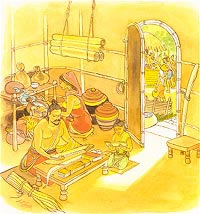
Verse 50. Look Inwards
And Not At Others
Not
others’ opposition
nor what they did or failed to do,
but in oneself should be sought
things done, things left undone.
Explanation:
Do not find fault with others. Do not worry about what others do or not do.
Rather, look within yourself to find out what you yourself have done or left
undone. Stop doing evil; do good.
Dhammapada Verse 50
Paveyya ajivaka Vatthu
Na
paresam vilomani
na paresam katakatam
attanova avekkheyya
katani akatani ca.
Verse
50: One should not consider the faults of others, nor their doing or not doing
good or bad deeds. One should consider only whether one has done or not done
good or bad deeds.
The
Story of the Ascetic Paveyya
While
residing at the Jetavana monastery, the Buddha uttered Verse (50) of this book,
with reference to the ascetic Paveyya and a rich lady.
A rich
lady of Savatthi had adopted Paveyya, an ascetic, as a son and was looking
after his needs. When she heard her neighbours talking in praise of the Buddha,
she wished very much to invite him to her house to offer him alms-food. So, the
Buddha was invited and choice food was offered. As the Buddha was expressing
appreciation (anumodana), Paveyya, who was in the next room, fumed with
rage. He blamed and cursed the lady for venerating the Buddha. The lady heard
him cursing and shouting and felt so ashamed that she could not concentrate on
what the Buddha was saying. The Buddha told her not to be concerned about those
curses and threats, but to concentrate only on her own good and bad deeds.
Then
the Buddha spoke in verse as follows:
|
Verse 50: One should not
consider the faults of others, nor their doing or not doing good or bad
deeds. One should consider only whether one has done or not done good or bad
deeds.
|
01/27/12
Filed under:
General
Posted by:
site admin @ 9:16 pm
01/26/12
Filed under:
General
Posted by:
site admin @ 8:18 pm
27 01
2012 LESSON 506 Dhammapada Verses 48 Attachment
To Senses If Folly
FREE
ONLINE eNālandā Research & Practice UNIVERSITY & BUDDHIST
GOOD NEWS
LETTER through
Through http://sarvajan.ambedkar.org
THE
BUDDHIST ON LINE GOOD NEWS LETTER
COURSE PROGRAM
LESSON 506
Practice
a Sutta a Day Keeps Dukkha Away
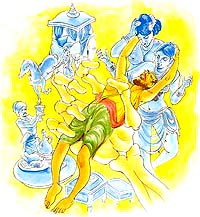
Verse 48. Attachment To
Senses If Folly
For one
of desires insatiate
who gathers only pleasure-flowers,
for one who has a clinging mind
Death the sovereign overpowers.
Explanation:
Those who pursue worldly pleasures are like garland-makers who pick flowers
here and there in the garden according to their preference. Those given to
pleasures of the senses are not satisfied. They seek still more. In consequence
of their endless pleasure-seeking they come under the spell of Antaka, or
‘ender of all’, i.e. death.
Dhammapada Verse 48
Patipujikakumari Vatthu
Pupphani
heva pacinantam
bysssasattamanasam naram
atittanneva kamesu
antako kurute vasam.
Verse
48: Like one who picks and chooses flowers, a man who has his mind attached to
sensual pleasures and is insatiate in them is over powered by Death.
The
Story of Patipujika Kumari
While
residing at the Jetavana monastery, the Buddha uttered Verse (48) of this book,
with reference to Patipujika Kumari.
Patipujika
Kumari was a lady from Savatthi. She married at the age of sixteen and had four
sons. She was a virtuous as well as a generous lady, who loved to make
offerings of food and other requisites to the bhikkhus. She would often go to
the monastery and clean up the premises, fill the pots and jars with water and
perform other services. Patipujika also possessed Jatissara Knowledge
through which she remembered that in her previous existence she was one of the
numerous wives of Malabhari, in the deva world of Tavatimsa. She also
remembered that she had passed away from there when all of them were out in the
garden enjoying themselves, plucking and picking flowers. So, every time she
made offerings to the bhikkhus or performed any other meritorious act, she
would pray that she might be reborn in the Tavatimsa realm as a wife of
Malabhari, her previous husband.
One
day, Patipujika fell ill and passed away that same evening. As she had so
ardently wished, she was reborn in Tavatimsa deva world as a wife of Malabhari.
As one hundred years in the human world is equivalent to just one day in
Tavatimsa world, Malabhari and his other wives were still in the garden
enjoying themselves and Patipujika was barely missed by them. So, when she
rejoined them, Malabhari asked her where she had been the whole morning. She
then told him about her passing away from Tavatimsa, her rebirth in the human
world, her marriage to a man and also about how she had given birth to four
sons, her passing away from there and finally her return to Tavatimsa.
When
the bhikkhus learned about the death of Patipujika, they were stricken with
grief. They went to the Buddha and reported that Patipujika, who was offering
alms-food to them early in the morning, had passed away in the evening. To them
the Buddha replied that the life of beings was very brief; and that before they
could hardly be satiated in their sensual pleasures, they were overpowered by
Death.
Then
the Buddha spoke in verse as follows:
|
Verse 48: Like one who
picks and chooses flowers, a man who has his mind attached to sensual
pleasures and is insatiate in them is over powered by Death.
|
01/25/12
Filed under:
General
Posted by:
site admin @ 10:36 pm
26 01 2012 LESSON 505
Self respect is more
important than the material gains. Our Struggle is for honour, for
self-respect, not only for thr economicprogress alone.-Dr. B.R.AmbedkarJai
Bheem, Republic day Wishes-BAMCEF Chandrasekhar
Dhammapada Verses 47 Pleasure Seeker Is Swept
Away
FREE
ONLINE eNālandā
Research &
Practice UNIVERSITY & BUDDHIST
GOOD NEWS
LETTER through
Through http://sarvajan.ambedkar.org
THE BUDDHIST ON LINE GOOD
NEWS LETTER
COURSE PROGRAM
LESSON 505
Practice a Sutta a Day
Keeps Dukkha Away
Self respect is more
important than the material gains. Our Struggle is for honour, for
self-respect, not only for thr economicprogress alone.-Dr. B.R.AmbedkarJai
Bheem, Republic day Wishes-BAMCEF Chandrasekhar
What Dr. B. R. Ambedkar said about Republic
Day (26th January)
“On 26th January 1950, we
are going to enter into a life of contradictions. In politics, we will have
equality and in social and economic structure, continue to deny the principle
of one man one value. How long shall we continue to live this life of
contradictions? How long shall we continue to deny equality in our social and
economic life? If we continue to deny it for long, we will do so only by
putting our political democracy in peril. We must remove this contradiction at
the earliest possible moment else those who suffer from inequality will blow up
the structure of democracy which this Constituent Assembly has so laboriously
built up.”
“I feel that the
constitution is workable, it is flexible and it is strong enough to hold the
country together both in peacetime and in wartime. Indeed, if I may say so, if
things go wrong under the new Constitution, the reason will not be that we had
a bad Constitution. What we will have to say is that Man was vile.”
“There is no nation of
Indians in the real sense of the world, it is yet to be created. In believing
we are a nation, we are cherishing a great delusion. How can people divided
into thousand of castes be a nation? The sooner we realise that we are not yet
a nation, in a social and psychological sense of the world, the better for us.”
“Independence is no doubt
a matter of joy. But let us not forget that this independence has thrown on us
greater responsibilities. By independence, we have lost the excuse of blaming
the British for anything going wrong. If hereafter things go wrong, we will
have nobody to blame except ourselves. There is a greater danger of things
going wrong. Times are fast changing.”
“Our object in framing
the Constitution is rally two-fold:
(1) To lay down the form
of political democracy, and
(2) To lay down that our
ideal is economic democracy and also to prescribe that every Government
whatever is in power shall strive to bring about economic democracy. The
directive principles have a great value, for they lay down that our ideal is
economic democracy.”
Dr. B.R. Ambedkar, the man behind the drafting and formation of
the Indian Constitution, was not only a learned scholar and an eminent jurist
but also a revolutionary against social evils like untouchability and caste
system.
Childhood and Early Life of B.R. Ambedkar
Born on 14 April 1891 in Mhow, Madhya Pradesh, Bhimrao Ramji Ambedkar was the
fourteenth child of his parents, Bhimabai Sakpal and Ramji. He was the victim
of religious untouchability by birth. He was born in a family, which was a part
of the Hindu Mahar caste. This caste was considered to be untouchables in the
society and have to face immense discriminations, both in the social as well as
in the economic fields. The male members of Dr. Ambedkar’s family were engaged
in the Army. His father was also in army and was promoted to the rank of
Subedar in the Mhow Cantonment, Indian Army.
At birth, “Sakpal” was the surname of Bhimrao and
“Ambavade” was the name of his native village. To avoid the
socio-economic discrimination and the ill-treatment of the higher classes of
the society, Bhimrao changed his surname from “Sakpal” to
“Ambedkar” by the help of a Brahmin teacher, who had great faith in
him. Since then, Bhimrao and his family used the title, Ambavedkar or Ambedkar.
Education of B.R. Ambedkar
Though B.R. Ambedkar was born in a family that was deprived socially as well as
economically, he had great interest in education. There were special schools
run by the Government for educating children of Army personnel and Ambedkar was
lucky to get admission in one of those schools. The standard of education was
good and Ambedkar developed a good grasp over Marathi and English. After his
father retired from the Army, the entire family shifted to Satara, Maharashtra.
Ambedkar was admitted to a local school there and had to face discriminations
from all sectors. He was made to sit on the floor, away from other students.
The teachers also discriminated him. He was a man of patience from his early
childhood and underwent all this agony without a fuss. In 1908, he passed his
Matriculation exam with flying colors from Bombay University. His higher
education continued in Elphinstone College. Political Science and Economics
were the subjects in which he graduated from the Bombay University in 1912.
Just a year after his graduation, Bhimrao Ambedkar lost his father. He acquired
a job in Baroda and it was the Maharaja of Baroda, who awarded him a
scholarship to go for higher education to the United States of America. It was
in New York that he could pursue his studies without any discrimination.
Finally, he acquired a degree and doctorate from Columbia University in the
year 1916. He was a Master of Arts and also attained a Doctorate in Philosophy
on his thesis on “National Dividend for India: A Historical and Analytical
Study”. In 1917, his scholarship was terminated by the Government of
Baroda and Bhimrao Ambedkar had to come back to India.
Social Reforms and Political Life of
B.R. Ambedkar
After his return to India, Bhimrao Ambedkar was made the political secretary of
the Maharaja of Baroda. He became victim of caste discrimination again and was
humiliated greatly by his peers. It was during this time that Ambedkar began
his movement to eradicate caste system and untouchability from society.
Ambedkar again went back to London, completed his law education and became a
barrister.
Untouchability and caste system were the two social evils that had haunted Dr. B.R.
Ambedkar since his childhood days. However, he thought of tackling the problem
himself and began his fight against untouchability. There were several ways by
which he was trying to do this. He started publishing a weekly journal called
‘Mooknayak’, where he criticized the orthodox system that prevailed in the
society. He spoke openly about the discriminations that were made to the lower
castes in the society and the humiliations that they had to undergo and endure.
He had also voted for creating separate electorates for the backward classes in
society. Reservations for “dalits” and other religious communities
were also demanded by Bhimrao Ambedkar.
B.R. Ambedkar also formed the “Bahishkrit Hitakarini Sabha” so that
the deprived and backward classes could get some opportunities to upgrade
themselves. He arranged for spreading education to these classes and tried to
improve their socio-economic conditions. He also became a member of the
Legislative Council in the year 1926. After this, he began an active movement
by bringing out marches and processions for the lower backward classes. In
1928, he was appointed to the Bombay Presidency Committee so that he could work
with the all-European Simon Commission. With this, B.R. Ambedkar made a mark in
the political arena of India.
He had criticized the Indian National Congress as well as the British Raj for
not being able to curb the problem of caste discrimination and untouchability.
His staunch stance against the orthodox authorities in India made him quite unpopular
with the politicians of those times. There were no considerable changes that
were evident in the social system of India. Gandhiji had rather started a fast
unto death campaign when Ambedkar demanded separate electorates for the
backward classes in society. After many upheavals it was decided that
reservations would be provided but there would be no separate electorates.
The Government Law College of Mumbai had Dr. Ambedkar as its Principal for two
years from 1935. He even contemplated of building a new political party that
would work against staunch and orthodox Hinduism. He named this new political
party as “Independent Labour Party (India)”, which can only managed
around 15 seats in the Central Legislative Assembly Elections in 1937. He also
occupied important positions in the government of the country. He had been
appointed to the Viceroy’s Executive Council as the Minister of Labor. Ambedkar
had also served in the Defence Advisory Committee.
Most Respected Chief Election Commissioner of India,
(Could not find his email ID, may he doesn’t like to be in front and cant lead by example.
Following email ids of some of his senapati’s, could be found. We may send our mails to them.)
feedback@eci.gov.in
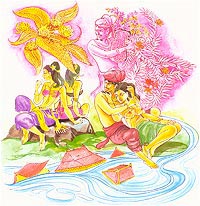
Verse 47. Pleasure Seeker Is Swept Away
For one who has a
clinging mind
and gathers only pleasure-flowers,
Death does seize and carry away
as great flood a sleeping village.
Explanation: Those men
and women , fascinated by worldly things, go about seeking pleasure, like a
garland-maker picking the flowers of his choice in a garden. But, gradually and
silently, death overcomes them like a flood in the night sweeping away a village
asleep.
Dhammapada Verse 47
Vitatubha Vatthu
Pupphani heva pacinantam
byasattamanasam naram
suttam gamam mahoghova
maccu adaya gacchati.
Verse 47: Like one who
picks and chooses flowers, a man who has his mind attached to sensual pleasures
is carried away by Death, just as a great flood sweeps away a sleeping village.
The Story of Vitatubha
While residing at the
Jetavana monastery, the Buddha uttered Verse (47) of this book, with reference
to Vitatubha, son of King Pasenadi of Kosala.
King Pasenadi of Kosala,
wishing to marry into the clan of the Sakyans, sent some emissaries to
Kapilavatthu with a request for the hand of one of the Sakyan princesses. Not
wishing to offend King Pasenadi, the Sakyan princes replied that they would
comply with his request, but instead of a Sakyan princess they sent a very
beautiful girl born of King Mahanama and a slave woman. King Pasenadi made that
girl one of his chief queens and subsequently she gave birth to a son. This son
was named Vitatubha. When the prince was sixteen years old, he was sent on a
visit to King Mahanama and the Sakyan princes. There he was received with some
hospitality but all the Sakyan princes who were younger than Vitatubha had been
sent away to a village, so that they would not have to pay respect to
Vitatubha. After staying a few days in Kapilavatthu, Vitatubha and his company
left for home. Soon after they left, a slave girl was washing with milk the
place where Vitatubha had sat; she was also cursing him, shouting, “This
is the place where that son of a slave woman had sat”. At that moment, a
member of Vitatubha’s entourage returned to fetch something which he had left
at the place and heard what the slave girl said. The slave girl also told him
that Vitatubha’s mother, Vasabhakhattiya, was the daughter of a slave girl
belonging to Mahanama.
When Vitatubha was told
about the above incident, he became wild with rage and declared that one day he
would wipe out the whole clan of the Sakyans. True to his word, when Vitatubha
became king, he marched on the Sakyan clan and massacred them all, with the
exception of a few who were with Mahanama and some others. On their way home,
Vitatubha and his army encamped on the sandbank in the river Aciravati. As
heavy rain fell in the upper parts of the country on that very night, the river
swelled and rushed down with great force carrying away Vitatubha and his army
into the ocean.
On hearing about these
two tragic incidents, the Buddha explained to the bhikkhus that his relatives,
the Sakyan princes, had in one of their previous existences, put poison into
the river killing the fishes. It was as a result of that particular action that
the Sakyan princes had to die en masse. Then, referring to the incident about
Vitatubha and his army, the Buddha said, “As a great flood sweeps away
all the villagers in a sleeping village, so also, Death carries away all the
creatures hankering after sensual pleasures.”
Then the Buddha spoke in
verse as follows:
|
Verse 47: Like one who picks and chooses
flowers, a man who has his mind attached to sensual pleasures is carried away
by Death, just as a great flood sweeps away a sleeping village.
|
Welcome, Munnabhai: US president woos Indian tourists
Chidanand Rajghatta, TNN Jan 21, 2012, 05.50AM IST
WASHINGTON: Munnabhai hasn’t made it to America yet, but president Obama
wants to make sure he’ll have no problem visiting there. The US
president, using the backdrop of Florida’s famed Disneyland, identified
India, China, and Brazil among countries that could bump up tourist
traffic to America so that US can remain the world’s top global travel
destination.
The travel and tourism industry generated 7.5
million jobs and 2.7% of US GDP in 2010, but Washington is concerned
about declining trends in a world where countries large and small, far
and near, are duking it out for tourism revenue. Post 9/11, US share of
international traveler spending has fallen from 17% to 11% due to
security concerns and increased competition. Obama wants to arrest that
slide.
MAY YOU BE EVER HAPPY, WELL AND SECURE
MAY YOU LIVE LONG
MAY ALL SENTIENT AND NON-SENTIENT BEINGS BE EVER HAPPY
MAY YOU BE ALWAYS HAVE CALM, QUIET, ALERT,ATTENTIVE AND
EQUANIMITY MIND WITH A CLEAR UNDERSTANDING THAT
EVERYTHING IS CHANGING
01/24/12
Filed under:
General
Posted by:
site admin @ 9:23 pm
25 01 2012 LESSON 504 Dhammapada Verse 46 Who Conquers Death?
FREE ONLINE eNālandā
Research &
Practice UNIVERSITY & BUDDHIST
GOOD NEWS
LETTER
Through http://sarvajan.ambedkar.org
is
SPINNING WHEEL OF DHAMMA!
WINNING GOOD
KAMMA!
To ATTAIN NIBBANA!
BY
GIVING MASTERKEY!
TO MAYAWATI!
OF BSP!
By Broad minded Entire Uttar Pradesh People giving her seats Three Hundred and Three!
THE BUDDHIST ON LINE GOOD NEWS LETTER
COURSE PROGRAM
LESSON 504
Practice a Sutta a Day Keeps Dukkha Away
Sambodhi Pujana Dhatu Stupa andmeditation Kuti are built in MahabodhiSociety, Bangalore on 8th March 2012. Kindly Donat. Hlp needed urgently.-Yours Ananda Bhante
DR BR AMBEDKAR IS NO 1 TALENTEDPERSON IN THE WORLD-Last month’s analysis of top 100talented persons in the world-Cambridge University London displayed the list.Out of 100 the first talented person is Dr Baba SahebBhimrao Ambedkar.
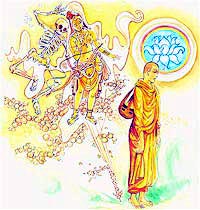
Verse 46. Who Conquers Death?
Having known this froth-like body
and awakening to its mirage nature,
smashing Mara’s flowered shafts
unseen beyond the Death-king go.
Explanation: This body of ours is like froth, bubbles, or
foam. It disintegrates quickly. The nature of life is like a mirage,
an illusion. Therefore, one must give up these unrealities. To achieve
that one must destroy Mara’s flower-arrows by which he tempts
men and women. It is necessary that the truth-seeker should go beyond
Mara’s region, to areas unseen by him. Mara knows only the realm
of death. The truth seeker goes beyond that region to the ‘deathless’
(Nibbana) - a domain Mara has never seen.
Dhammapada Verse 46
Maricikammatthanika bhikkhu Vatthu
Phepnupamam1 kayamimam viditva
maricidhammam2 abhisambudhano
chetvana marassa papupphakani3
adassanam maccurajassa gacche4
Verse 46: One who knows that this body is impermanent like froth, and
comprehends that it is insubstantial like a mirage, will cut the flowers of Mara
(i.e., the three kinds of vatta or rounds), and pass out of sight of the
King of Death.
1. Phepnupamam: like froth; it means that this body is perishable and
impermanent like froth.
2. maricidhammam: lit., mirage + nature; nature of a mirage, i. e.,
insubstantial like a mirage.
3. marassa papupphakani: flowers or flower-tipped arrows of Mara.
These flowers or arrows of Mara represent the tivattam or the three kinds
of vattam (rounds), viz., kilesavattam ( the round of moral
defilements), kammavattam (the round of volitional action) and vipakavattam
(the round of resultant effects). According to the Commentary, this chain or
round is broken when cut by the sword of ariya magga nana.
4. adassanam maccurajassa gacche: In this context, out of sight of the
King of Death means the realization of Nibbana.
The Story of the Bhikkhu who Contemplates the Body as a Mirage
While residing at the Jetavana monastery, the Buddha uttered Verse (46) of
this book, with reference to a certain bhikkhu.
On one occasion, a certain bhikkhu, after taking a subject of meditation from
the Buddha, went to the forest. Although he tried hard he made little progress
in his meditation; so he decided to go back to the Buddha for further
instruction. On his way back he saw a mirage, which, after all, was only an
illusive appearance of a sheet of water. At that instant, he came to realize
that the body also was insubstantial like a mirage. Thus keeping his mind on the
insubstantiality of the body he came to the bank of the river Aciravati. While
sitting under a tree close to the river, seeing big froths breaking up, he
realized the impermanent nature of the body.
Soon, the Buddha appeared in his vision and said to him, “My son,
just as you have realized, this body is impermanent like froth and insubstantial
like a mirage.”
Then the Buddha spoke in verse as follows:
Verse 46: One who knows that this body is impermanent like froth,
and comprehends that it is insubstantial like a mirage will cut the
flowers of Mara (i.e., the three kinds of vatta or rounds), and pass
out of sight of the King of Death. |
At the end of the discourse the bhikkhu attained arahatship.
Filed under:
General
Posted by:
site admin @ 10:40 am
24 01 2012 LESSON 503 FLOWERS Dhammapada Verse 45 The Seeker Understands
FREE ONLINE eNālandā
Research &
Practice UNIVERSITY & BUDDHIST
GOOD NEWS
LETTER
Through http://sarvajan.ambedkar.org
is
SPINNING WHEEL OF DHAMMA!
WINNING GOOD
KAMMA!
To ATTAIN NIBBANA!
BY
GIVING MASTERKEY!
TO MAYAWATI!
OF BSP!
By Broad minded Entire Uttar Pradesh People giving her seats Three Hundred and Three!
THE BUDDHIST ON LINE GOOD NEWS LETTER
COURSE PROGRAM
LESSON 503
Practice a Sutta a Day Keeps Dukkha Away
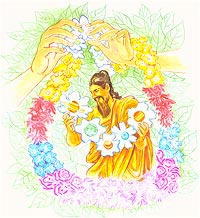
Verse 45. The Seeker Understands
One Trained will comprehend this earth,
the world of Yama, and the gods,
One Trained discern the well-taught Dhamma
as one who’s skilled selects a flower.
Explanation: In the previous stanza the question was raised
as to who will penetrate the well-articulated doctrine? The present
stanza provides the answer: the student, the learner, the seeker,
the person who is disciplined. He or she will perceive the doctrine,
like the expert garland-maker who recognizes and arranges flowers.
It is the learner, the seeker, the student who will perceive the world
of Yama, the realm of heavenly beings and existence on earth. He will
discard and determine the various areas of the doctrine, life a deft
garland-maker who plucks and arranges the flowers into garlands.
01/22/12
Filed under:
General
Posted by:
site admin @ 3:44 pm
23 01 2012 LESSON 502 Dhammapada FLOWERS Verse 44 The Garland-Maker
FREE ONLINE eNālandā
Research &
Practice UNIVERSITY & BUDDHIST
GOOD NEWS
LETTER
Through http://sarvajan.ambedkar.org
is
SPINNING WHEEL OF DHAMMA!
WINNING GOOD
KAMMA!
To ATTAIN NIBBANA!
BY
GIVING MASTERKEY!
TO MAYAWATI!
OF BSP!
By Broad minded Entire Uttar Pradesh People giving her seats Three Hundred and Three!
THE BUDDHIST ON LINE GOOD NEWS LETTER
COURSE PROGRAM
LESSON 501
Practice a Sutta a Day Keeps Dukkha Away
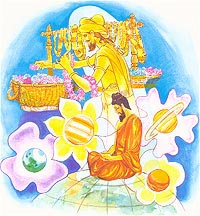
Verse 44. The Garland-Maker
Who will comprehend this earth,
the world of Yama, and the gods?
Who will discern the well-taught Dhamma
as one who’s skilled selects a flower.
Explanation: An expert in garland making will select, pluck
and arrange flowers into garlands. In the same way who will examine
the nature of life penetratingly? Who will perceive the real nature
of life in the world, along with the realms of the underworld and
heavenly beings? Who will understand and penetratively perceive the
well-articulated doctrine, like an expert maker of garlands, deftly
plucking and arranging flowers.
- FROM:
-
Sunday, 22 January 2012 4:32 PM
http://www.hindustantimes.com/Specials/Coverage/Assembly-Elections-2012/Chunk-HT-UI-AssemblyElections2012-UP-TopStories/Mayawati-rides-on-hope-Kanshi-Ram-s-name/SP-Article10-800484.aspxMayawati rides on hope, Kanshi Ram’s nameA BSP supporter seeks UP CM Mayawati’s blessings at an event tocelebrate her 56th birthday in Lucknow. Invoking the memory of her political mentor, the late Kanshi Ram,Mayawati on Saturday called upon people to vote for her party in theJanuary 30 Punjab assembly polls. “It was Babu Kanshi Ram’s wish thatour party rules Punjab,” the BSP chief said at a rally at Kharar inMohali district.“We fulfilled his desire four times in Uttar Pradesh.”Though Punjab was the home state of BSP founder Kanshi Ram and has a29% SC population — the highest among all states — The party is going it alone in all 117constituencies.Mayawati, however, claimed on Saturday that the Congress and SAD-BJPfaced dissidence and a split in their votes would benefit the BSP.‘This is a golden opportunity to attain power in Punjab,” she said.“No party — Congress, BJP or any other — in the state have deliveredthe goods to the sarva samaj (common masses).”At another rally in Nawanshahr town, Mayawati said while other partieswooed SC/STs after Independence through “hollow promises”, the BSPgovernment in UP initiated several schemes in education, employment,health and welfare not just for SC/STs but for “all downtroddensections”.Targeting the Congress, she attacked the UPA for not doing enough tocurb “price rise”.She said the Centre’s “wrong policies” had adversely affected the common man.Countering Congress allegations that her recent sacking of ministerswas an act of desperation, she said, “We have ensured our partycandidates have a clean image and are working for the development ofpeople.”She said the EC’s move to cover elephant statues in UP and the mediacoverage of the issue had only heightened the popularity of the BSP’spoll symbol.
Notification for phase-III of UP Assembly polls issued
PTI | 12:01 PM,Jan 22,2012
Lucknow, Jan 21 (PTI) Notification for the third phase
of Uttar Pradesh Assembly polls was issued today, setting in
motion the filing of nominations.
The third phase would test the fate of three cabinet
ministers, one minister of state, 29 sitting MLAs and 14
former ministers.
Polling for the third phase of elections, covering 56
seats, would be held on February 15.
“More than 1.75 crore voters are expected to cast their
votes at 17,869 polling booths in 11,589 polling stations,”
Election Commission officials said.
Ministers who are expected file their nominations include
Indrajit Saroj from Manjhanpur, Nand Gopal Gupta from
Allahabad South and Dharmaraj Nishad from Shahganj.
While former minister Rangnath Mishra would file
nomination for Mirzapur Sadar seat, sacked higher education
minister Rakesh Dhar Tripathi would be contesting as an
Independent candidate from Handiya seat in Allahabad.
Among prominent BJP candidates, Legislative Party leader
Om Prakash Singh would contest from Chunar and former Vidhan
Sabha speaker Kesari Nath Tripathi from Allahabad South seat.
Shekhar Bahuguna, brother of state Congress president
Rita Bahuguna Joshi, would file nomination for Phaphamau seat
in Allahabad, while Ujjwal Rama Singh, son of SP M P and
former Minister Reoti Raman Singh, would contest from Karchana
seat.
Various parties are also fielding candidates facing
criminal charges for the upcoming polls.
Former MP and an accused in several cases Ateeq Ahmad has
been named candidate by Apna Dal from Allahabad West seat,
while mafia don Brijesh Singh would contest from Syedraza seat
in Chandauli district as Pragatisheel Manav Samaj candidate.
Prem Prakash Singh alias Munna Bajrangi, an accused in
several shootouts, would file his nomination as Apna Dal
candidate from Madiyahon in Jaunpur district.
Adding to the list of candidates with criminal background,
SP MLA Vijay Mishra, who is currently lodged in jail for
allegedly assaulting a cabinet minister, would be seeking
re-election from Gyanpur seat in Bhadoi district.
Doesn’t the decision to veil the statues of elephants and
leaders of the BSP invite the charge that the Election Commission is
targeting one party?
Yes.EC
draping the statues of an aboriginal inhabitant of Jambudvipa, i.e.,
the Great PraBuddha Bharath (Scheduled Caste) amounts to Unseeability.
The
draping of wrong elephant symbol of BSP with the trunk raised above
posture and threatening to allot the symbols to other parties and
independents will become a comedy when other symbols such as
hand,lantern,cycle,lotus,hand pump, pen, watch etc with other following
postures also would be allotted to other parties and independents:Since
the pictures could not be seen in comments, visit
http://sarvajan.ambedkar.org
All
the 170 million pairs of hands, bicycles, lotuses and all the photos of
Lakshmi standing on lotuses, all the
bicycles,spectacles,watches,pens,table fans,TV sets, lanterns, hand
pumps, sickles with hammers
and stars must be draped in clothes or plastics.

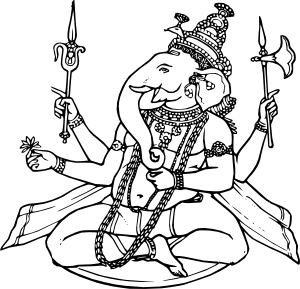
Election Commission has rejected BSP plea to reconsider its order to
cover statues of party symbol ‘elephant’ and that of Chief Minister
Mayawati in poll-bound Uttar Pradeesh.
The EC must regret that such an order was passed.
People of this country expect a higher sense of responsibility and constitutional decorum
from CEC for such an order inspired by pressure from some
political parties.
The public is attributing as anti-Untouchables and casteist motives to its order on statutes.
It does include
considerations of religion, race, caste and community in the manner as
alleged.And it is one of the assigned responsibilities (by some political parties) of the EC to
ensure that these aspects are allowed to vitiate the election
process.
No doubt the order was to be in conformity with the EC’s consistent
practice to remove
photographs and pictures of active political leaders at all public
places, put up at the cost of public exchequer, so that there was no
undue advantage or disadvantage to political parties and the candidates.
But the basic philosophy of the Model Code of Conduct (MCC) was that
all
the political parties, in the Centre and
in the States, did not use their official power and official machinery
in a manner which might lead to complaints of misuse to influence the
voters. “This basic philosophy of MCC has not been met.
BSP’s contention is that the elephant statues were in welcome
posture with trunks raised and were different from the party’s symbol
wherein the elephant was seen with its trunk down, the EC said it was
not acceptable. Political parties and Independent candidates would seek
allotment of the the following Hand,bicycle,lotus,spectacles,watches,pens,table
fans,TV sets, lanterns, hand pumps, sickles with hammers
and stars symbols in different postures if it allots elephant symbol
to other parties. CEC may have to allot all the above and below
mentioned different postures of symbols.





![]()













While enforcing the level playing field, the EC should take into
account statues raised with private funds also, whether of political leaders
or election symbols or otherwise.
The EC pointed out that in the implementation of the MCC, must
engage in prior consultations every time, and try to take early
remedial action in order to keep the electoral process on the track. In
any case, here the EC was covering an untouchable’s statue encourages the people to practice Un-seeablility, hence the need
to consult BSP did arise.
Looking from whatever rules, facts and reasoning, the step to cover the
statues was the most inappropriate option before the EC.
Chief Election Commissioner S.Y. Quraishi cannot put an end to the controversy as allegations had
been levelled against it on a daily basis.
By draping the statue of an untouchable, the EC has made provision for the people of UP to practice Unseeabilty.
With
the issuance on Thursday of the notification for the first phase of
Assembly polls on February 8, there is and apprehension in the minds of
the people of this country in general and the broad minded people of
Uttar Pradesh in particular, that the comedy action of the Commission
may even postpone the UP election out of fear that the BSP may cross 300
seats.You have ordered for draping of elephants in Uttar Pradesh which
are not the symbol of BSP.
Elephant symbols of empowerment are too powerful for India’s Election Commission
These giant stone elephants sitting on their pedestals in a huge park
outside Delhi are a symbol of India’s political development. Built here
and in Uttar Pradesh’s capital city of Lucknow, along with other
massive stone and bronze monuments, stupas, and domes at a reported cost
of Rs600, they are designed to glorify SC/ST/OBC
icons such as Lord Buddha, Mahatma Jothiba Phule, Sahu Maharaj, Narayan
Guru, Dr.BR Ambedkar, Manyawar Kanshiram Kumari who are symbol of
empowerment
for aboriginal inhabitants of PraBuddha Bharath.
India’s Election Commission ordered last week that all the elephants,
and statues of Mayawati, should be covered for the duration of the
state’s current assembly elections – polling takes place next month. The
chief election commissioner, S.Y.Qureshi, said this was done to stop
Mayawati’s Bahujan Samaj Party (BSP) gaining “political mileage” from
the displays.
This was
excessive and unnecessary because the statues were permanent fixtures,
not photographs or banners hung on walls or highways. The expensive
drama involved in covering them also drew attention to Mayawati, and has
led to sympathy from her supporters – she told them the
authorities were discriminating against SC/STs.
So the elephants are important, covered or uncovered, and they are
also significant as a symbol of Mayawati’s success. She is a Scheduled Caste– the
“untouchables” (Aboriginal Inhabitant of PraBUddha Bharath) in the Indian caste system – and relies on this caste
for mass support in elections.
Her main aim has been to impress her fellow SC/STs/OBCs/Minorities/Poor Upper Castes by building up her
own extravagant exclusive image and life-style, and by building the
monuments that bring back memories of powerful Mogul rulers’ palaces and
forts and widespread highway projects,
including a race track for a very successful grand prix motor race last October.
Many people throng to the parks on holidays and admire the elephants,
enjoying the well maintained open spaces.

But this is the BSP election symbol
Yet
you have ordered it to be draped saying elephant is an elephant whether
its trunk raised above or low. In that case will you order the
following standing sitting dancing, milk drinking elephants found all
over UP to be draped. Will it not be a comedy?
In
Uttar Pradesh the fight is between Bahujan Samaj Party with its Sacred
Politics, led by Highly Performing best and meritorious governance of
kanoon ki Devi Ms Maha Mayawati VS a handful greedy politicians such as
Nehruvian and Mulayam dynasty yurajas, yurani ( had the yuraj’s father,
mother, sister, grand father, great grand father who ruled for 65 years
allowed untouchable Scheduled Castes inside their kitchens, now the
youraj need not visit their homes all his life for the sake of votes)
& the media which should be
“I can face two battalions but not two scribes. – Napoleon Bonaparte
Once the media loses credibility, it can forget about being the watchdog of society.
It will lose all moral authority to call others to account.”
But not like negative media those do not publish comments in favour of BSP. Media
making adverse reports on BSP and not publishing corrective comments,
some of them in the name of moderation. Such handful of Greedy people,
media and the CEC will become broadminded to support an untouchable to
rule this country as it was done by the people of Uttar Pradesh in whole
heartedly elected Ms Mayawati as Chief Minister and the people of US
elected Obama as the President. Instead of visiting the houses of
untouchables throughout life for the sake of power and votes, it is
better to make an untouchable as the Prime Minister of this country and
create a situation where the SC/STs could easily get into the kitchens
of the traditional Upper Caste leaders whno never do so.
Mayawati alleged that the poll panel’s order was “one-sided” and “anti-Scheduled Castes”. “The Election Commission made a one-sided decision to cover statues of elephants and those of mine installed to honour the will of Kanshiram, without hearing my party.”
“Centre and Opposition are insulting Kanshiram; SC/STs will not forgive them”, she said.
She also cited the example of a park in Chandigarh erected by the
Congress that carries a 45-feet-high hand - the party’s symbol. Calling upon the poll panel to cover such structures of the Congress in other states, she said, “If the CEC is not just, BSP will call it anti-SC/ST, under Congress pressure.”
Putting up a brave face, she also said that the statue-screening
incident had saved the party crores by giving it huge publicity. “CEC, other parties have publicised BSP for free, I thank them.”
Mayawati will truly win in the upcoming elections next month. A wish she has already expressed to the electorate, something she reiterated again today- UP as her birthday gift. Victory in the polls would truly be a sweet surprise, a fitting belated birthday gift.
The BSP will encash the Election Commission’s directives on
draping the statues of Ms. Mayawati and party symbol elephant. Party general
secretary Satish Chandra Mishra fired a missive to Chief Election
Commissioner S.Y. Quraishi on Thursday, protesting against the
“one-sided order.” Describing Ms. Mayawati as Scheduled Caste ki beti
(daughter of a SC), Mr. Mishra wrote that the EC’s diktats had
demoralised the SC/STs and downtrodden sections.BSP general secretary
and Rajya Sabha member Satish
Chandra Mishra criticised the order. Mr. Mishra had written to the
Commission saying its order was in violation of the law, and that
it be reconsidered. Mr. Mishra had even said the Commission had
demoralised the party and left SC/STs and backwards “cheated.” The BSP
also appeared to raise questions on the Commission’s intentions to hold
free and fair polls in the State.
Mr. Mishra had
written: “The decision is [in] violation of Article 14 of the
Constitution, which provides right of equality. Similar decisions should
be taken against other parties also.”
M
Filed under:
General
Posted by:
site admin @ 3:22 am
21 01 2012 LESSON 501 Verse 43 Well-Trained Mind Excels People
FREE ONLINE eNālandā
Research &
Practice UNIVERSITY & BUDDHIST
GOOD NEWS
LETTER
Through http://sarvajan.ambedkar.org
is
SPINNING WHEEL OF DHAMMA!
WINNING GOOD
KAMMA!
To ATTAIN NIBBANA!
BY
GIVING MASTERKEY!
TO MAYAWATI!
OF BSP!
By Broad minded Entire Uttar Pradesh People giving her seats Three Hundred and Three!
THE BUDDHIST ON LINE GOOD NEWS LETTER
COURSE PROGRAM
LESSON 501
Practice a Sutta a Day Keeps Dukkha Away
Verse 43. Well-Trained Mind Excels People
What one’s mother, what on e’s father,
e’s father,
whatever other kin may do,
the well directed mind indeed
can do greater good.
Explanation: Well directed thoughts can help a person better
than one’s father or one’s mother.
01/19/12
Filed under:
General
Posted by:
site admin @ 11:52 pm
20 01 2012 LESSON 500 Verse 42 Without The Mind, Body Is Worthless
FREE ONLINE eNālandā
Research &
Practice UNIVERSITY & BUDDHIST
GOOD NEWS
LETTER
Through http://sarvajan.ambedkar.org
is
SPINNING WHEEL OF DHAMMA!
WINNING GOOD
KAMMA!
To ATTAIN NIBBANA!
BY
GIVING MASTERKEY!
TO MAYAWATI!
OF BSP!
By Broad minded Entire Uttar Pradesh People giving her seats Three Hundred and Three!
THE BUDDHIST ON LINE GOOD NEWS LETTER
COURSE PROGRAM
LESSON 500
Practice a Sutta a Day Keeps Dukkha Away
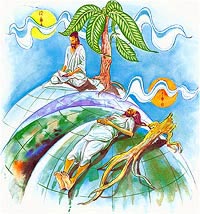
Verse 41. Without The Mind, Body Is Worthless
Not long alas, and it will lie
this body, here upon the earth.
Discarded, void of consciousness,
useless as a rotten log.
Explanation: Soon, this body, without consciousness, discarded
like a decayed worthless log, will lie on the earth.
Most Respected Chief Election Commissioner of India,
(Could not find his email ID, may he doesn’t like to be in front and cant lead by example.
Following email ids of some of his senapati’s, could be found. We may send our mails to them.)
feedback@eci.gov.in
jaipriye@eci.gov.in,balakrish@eci.gov.in,
dralokshukla@eci.gov.in,ddinews@doordarshan.gov.in
![]()
In
Uttar Pradesh the fight is between Bahujan Samaj Party with its Sacred
Politics, led by Highly Performing best and meritorious governance of
kanoon ki Devi Ms Maha Mayawati VS a handful greedy politicians such as
Nehruvian and Mulayam dynasty yurajas, yurani ( had the yuraj’s father,
mother, sister, grand father, great grand father who ruled for 65 years
allowed untouchable Scheduled Castes inside their kitchens, now the
youraj need not visit their homes all his life for the sake of votes)
& the media which should be
“I can face two battalions but not two scribes. – Napoleon Bonaparte
Once the media loses credibility, it can forget about being the watchdog of society.
It will lose all moral authority to call others to account.”
But not like negative media those do not publish comments in favour of BSP. Media
making adverse reports on BSP and not publishing corrective comments,
some of them in the name of moderation. Such handful of Greedy people,
media and the CEC will become broadminded to support an untouchable to
rule this country as it was done by the people of Uttar Pradesh in whole
heartedly elected Ms Mayawati as Chief Minister and the people of US
elected Obama as the President. Instead of visiting the houses of
untouchables throughout life for the sake of power and votes, it is
better to make an untouchable as the Prime Minister of this country and
create a situation where the SC/STs could easily get into the kitchens
of the traditional Upper Caste leaders whno never do so.
Mayawati alleged that the poll panel’s order was “one-sided” and “anti-Scheduled Castes”. “The Election Commission made a one-sided decision to cover statues of elephants and those of mine installed to honour the will of Kanshiram, without hearing my party.”
“Centre and Opposition are insulting Kanshiram; SC/STs will not forgive them”, she said.
She also cited the example of a park in Chandigarh erected by the
Congress that carries a 45-feet-high hand - the party’s symbol. Calling upon the poll panel to cover such structures of the Congress in other states, she said, “If the CEC is not just, BSP will call it anti-SC/ST, under Congress pressure.”
Putting up a brave face, she also said that the statue-screening
incident had saved the party crores by giving it huge publicity. “CEC, other parties have publicised BSP for free, I thank them.”
Mayawati will truly win in the upcoming elections next month. A wish she has already expressed to the electorate, something she reiterated again today- UP as her birthday gift. Victory in the polls would truly be a sweet surprise, a fitting belated birthday gift.
The BSP will encash the Election Commission’s directives on
draping the statues of Ms. Mayawati and party symbol elephant. Party general
secretary Satish Chandra Mishra fired a missive to Chief Election
Commissioner S.Y. Quraishi on Thursday, protesting against the
“one-sided order.” Describing Ms. Mayawati as Scheduled Caste ki beti
(daughter of a SC), Mr. Mishra wrote that the EC’s diktats had
demoralised the SC/STs and downtrodden sections.BSP general secretary
and Rajya Sabha member Satish
Chandra Mishra criticised the order. Mr. Mishra had written to the
Commission saying its order was in violation of the law, and that
it be reconsidered. Mr. Mishra had even said the Commission had
demoralised the party and left SC/STs and backwards “cheated.” The BSP
also appeared to raise questions on the Commission’s intentions to hold
free and fair polls in the State.
Mr. Mishra had
written: “The decision is [in] violation of Article 14 of the
Constitution, which provides right of equality. Similar decisions should
be taken against other parties also.”
All
the 170 million pairs of hands, bicycles, lotuses and all the photos of
Lakshmi standing on lotuses, all the
bicycles,spectacles,watches,pens,table fans,TV sets, lanterns, hand
pumps, sickles with hammers
and stars must be draped in clothes or plastics.


Election Commission has rejected BSP plea to reconsider its order to
cover statues of party symbol ‘elephant’ and that of Chief Minister
Mayawati in poll-bound Uttar Pradeesh.
The EC must regret that such an order was passed.
People of this country expect a higher sense of responsibility and constitutional decorum
from CEC for such an order inspired by pressure from some
political parties.
The public is attributing as anti-Untouchables and casteist motives to its order on statutes.
It does include
considerations of religion, race, caste and community in the manner as
alleged.And it is one of the assigned responsibilities (by some political parties) of the EC to
ensure that these aspects are allowed to vitiate the election
process.
No doubt the order was to be in conformity with the EC’s consistent
practice to remove
photographs and pictures of active political leaders at all public
places, put up at the cost of public exchequer, so that there was no
undue advantage or disadvantage to political parties and the candidates.
But the basic philosophy of the Model Code of Conduct (MCC) was that
all
the political parties, in the Centre and
in the States, did not use their official power and official machinery
in a manner which might lead to complaints of misuse to influence the
voters. “This basic philosophy of MCC has not been met.
BSP’s contention is that the elephant statues were in welcome
posture with trunks raised and were different from the party’s symbol
wherein the elephant was seen with its trunk down, the EC said it was
not acceptable. Political parties and Independent candidates would seek
allotment of the the following Hand,bicycle,lotus,spectacles,watches,pens,table
fans,TV sets, lanterns, hand pumps, sickles with hammers
and stars symbols in different postures if it allots elephant symbol
to other parties. CEC may have to allot all the above and below
mentioned different postures of symbols.





![]()













While enforcing the level playing field, the EC should take into
account statues raised with private funds also, whether of political leaders
or election symbols or otherwise.
The EC pointed out that in the implementation of the MCC, must
engage in prior consultations every time, and try to take early
remedial action in order to keep the electoral process on the track. In
any case, here the EC was covering an untouchable’s statue encourages the people to practice Un-seeablility, hence the need
to consult BSP did arise.
Looking from whatever rules, facts and reasoning, the step to cover the
statues was the most inappropriate option before the EC.
Chief Election Commissioner S.Y. Quraishi cannot put an end to the controversy as allegations had
been levelled against it on a daily basis.
By draping the statue of an untouchable, the EC has made provision for the people of UP to practice Unseeabilty.
With
the issuance on Thursday of the notification for the first phase of
Assembly polls on February 8, there is and apprehension in the minds of
the people of this country in general and the broad minded people of
Uttar Pradesh in particular, that the comedy action of the Commission
may even postpone the UP election out of fear that the BSP may cross 300
seats.You have ordered for draping of elephants in Uttar Pradesh which
are not the symbol of BSP.
Elephant symbols of empowerment are too powerful for India’s Election Commission
These giant stone elephants sitting on their pedestals in a huge park
outside Delhi are a symbol of India’s political development. Built here
and in Uttar Pradesh’s capital city of Lucknow, along with other
massive stone and bronze monuments, stupas, and domes at a reported cost
of Rs600, they are designed to glorify SC/ST/OBC
icons such as Lord Buddha, Mahatma Jothiba Phule, Sahu Maharaj, Narayan
Guru, Dr.BR Ambedkar, Manyawar Kanshiram Kumari who are symbol of
empowerment
for aboriginal inhabitants of PraBuddha Bharath.
India’s Election Commission ordered last week that all the elephants,
and statues of Mayawati, should be covered for the duration of the
state’s current assembly elections – polling takes place next month. The
chief election commissioner, S.Y.Qureshi, said this was done to stop
Mayawati’s Bahujan Samaj Party (BSP) gaining “political mileage” from
the displays.
This was
excessive and unnecessary because the statues were permanent fixtures,
not photographs or banners hung on walls or highways. The expensive
drama involved in covering them also drew attention to Mayawati, and has
led to sympathy from her supporters – she told them the
authorities were discriminating against SC/STs.
So the elephants are important, covered or uncovered, and they are
also significant as a symbol of Mayawati’s success. She is a Scheduled Caste– the
“untouchables” (Aboriginal Inhabitant of PraBUddha Bharath) in the Indian caste system – and relies on this caste
for mass support in elections.
Her main aim has been to impress her fellow SC/STs/OBCs/Minorities/Poor Upper Castes by building up her
own extravagant exclusive image and life-style, and by building the
monuments that bring back memories of powerful Mogul rulers’ palaces and
forts and widespread highway projects,
including a race track for a very successful grand prix motor race last October.
Many people throng to the parks on holidays and admire the elephants,
enjoying the well maintained open spaces.

But this is the BSP election symbol
Yet
you have ordered it to be draped saying elephant is an elephant whether
its trunk raised above or low. In that case will you order the
following standing sitting dancing, milk drinking elephants found all
over UP to be draped. Will it not be a comedy?
She has done a lot during her four
terms as chief minister to develop the state, especially in rural areas.
She has done a lot during her four
terms as chief minister to develop the state, especially in rural areas.
Hon’ble Chief Minister, Uttar Pradesh
Ms. Mayawati Ji
Led Government’s four-year term
Has been very promising
And the best in the
sphere of
“Law & Order and
Crime Control”
Besides
“Development and Public Welfare”
Important and Historic Steps pertaining to Development and Public Welfare·
Hon’ble Ms. Mayawati Ji-led government formed on 13 May, 2007 in Uttar Pradesh, after its four-year term, has kindled a new ray of “bright” future among the general public in the State,
especially the SC/STs,
backwards, religious minorities and upper-caste poor in respect of law
and order and crime control together with development and public welfare
activities.
This very government, by pursuing the path shown by great saints, gurus and seers born in backward classes, especially Mahtma Jotiba Phule, Chhatrapati Shahuji Maharaj, Shri Narayana Guru, Baba Saheb Dr. Bhimrao Ambedkar
and Manyawar Shri Kanshiram Ji in development and public welfare activities with government following the policy of “Sarvajan Hitay – Sarvajan Sukhay”.
·
Besides, to honour these backward-born great “Saints, Gurus and Seers”, various magnificent spots, memorials, museums, parks, etc have been constructed in the state, on which the total budgeted government amount spent is even less than 1%; the remaining funds having spent on law and order, crime control, development and public welfare activities.
·
In the last four years, the central government did not release on time its share payable to the state totalling Rs. 21,385 crore. If this amount had been paid by the centre in time, achievements of the state government could have been far far
better.
·
Not only this, the “special economic package’ of Rs. 80,000 crore sought from the central government for the total development of the state, especially Bundelkhand and Poorvanchal in view of the poor and pitiable economic conditions inherited from the previous governments, no money was received from the central government at all.
·
Thereafter, under government’s new development strategy several major projects /schemes on the PPP-model, like the Ganga Express-way, Yamuna Express-way and Upper Ganga canal were prepared to spur development in the state in which no central investments were involved except a departmental ‘no objection ‘ from them; the centre, however, did not cooperate even in this matter.
·
And yet, with “ correct mobilization of resources and improved financial management” the state government generated an atmosphere
Development, notable
achievements of which are enumerated below:
NOTE-1-Since the formation, in 1995 of the first government of Hon’ble Chief Minister Ms. Mayawati Ji in Uttar Pradesh, its priority has been the total development of the poor and the backward SC/ST, other backward classes,Religious minorities and disables persons-who had remained neglected for centuries and during earlier governments. By separately creating Uttar Pradesh Welfare Department and other ministries, there has been considerable improvements
in their condition at every level and\ every sphere.
1. This government in the last four years has undertaken several activities at a total cost of Rs. 37,000 crore (Rs. 36,795 crore), outlay of 21.21 and 100% expenditure on the development of “SC/ST” under special component plan which are chiefly – increase in the rate of post matric for (Scheduled Castes), eligibility level of income increased from 1lakh to Rs.2 lakh,, scholarships fora all students (girls and boys) from class 1 to 8, establishment of ‘bhagidari bhavan’ at Lucknow and Agra,
including Training institutes at Aligarh and Rae Bareli to coach SC/ST youth for recruitment to high-level services like I.A.S and P.C.S; recruitment in Government posts through a drive to clear the backlog; for the first time Reservation in contracts upto Rs.25 lakh for SC/ST, so far, contracts worth Rs.1,623 crore allotted; about 4 lakh S/C families allotted more Than 3,500 hectares of land.; 16 Mahamaya Polytechnics for Information Technology set up for these categories of students; regularisation of Landless SC/ST people in possession of gram sabah land upto13May, 2007; formal right of possession letters (pattas) awarded to 9,431 persons; about 3000 genuine lease-holders benefited by removing illegal usurpers from their land; creation of employment totalling 5,945 lakh man- days for men and 2,089 lakh for women belonging to SC/ST classes created in rural areas; about 8 lakh S/C families benefited by writing-off debts amounting to Rs.120.28 crore of Uttar Pradesh SC/ST Development Corporation; electrification on large-scale of SC/ST bustees /majras and appointment of 23% from these classes only of SOs in police stations; provision of reservation also in state government-aided private enterprises; allotment of more than 4,000 fair price shops; together with the establishment of a Rs.100 crore “leather park and shoe mandi”: in Agra, exemption from VAT of Agra Footwear Industry.
2. “Other Backward Classes” – in the last four years 2 lakh landless people allotted lease of about 50,000 hectares of agricultural land; effective implementation of 27% reservation for OBSc in the allotment of fair price shops in the urban and rural areas under the public distribution system; computerisation of the entire procedure of scholarship under the backward classes Welfare department; more than 50 lakh students (girls and boys) benefites by scholarships under the scheme of aid to the poor families of backward classes on account of marriage and illness about Rs.50 crore spent every year; apart from increasing the “creamy layer” annual income limit of these classes from Rs.3 lakh Rs.5lakh,
about Rs.250 crore spent to reimburse the admission fees of students studying in post matric classes
3. In the matter of Religious Minorities especially the Muslim community, mention may be made of the establishment of Manyawar Shri Kanshiram Ji Urdu, Arabic-Persian University; inclusion of 10 new Arabic-Persian Madrasas in the grant-in-aid list; as much as 486.73 crore approx, on account of scholarships to 1,28,35,824 minority students (girls and boys); elegibilty income limit for scholarships increased to Rs.1 lakh in respect of, minority students; grant of Rs. 3,745 lakh for the marriage of 37,445 daughters from minority BPL families; reimbursement of fees amounting to Rs.2,049 lakh of 49,166 post matric students; construction of well-equipped “Haj Houses” at
Ghaziabad and Lucknow for the convenience of the Hajis; “direct
Haj flight” from Varanasi to Jeddah; abolition of the pre-condition of police verification in the appointment of “Mutawallis”; arrangement of advance coaching to prepare for competitive recruitment examinations; the amount of grant for Uttar Pradesh Urdu Academy more than doubled to Rs.3 crore; establishment of 58 government secondary
schools in minority-dominated areas of 22 selected districts as well as mformation of a commission to provide the atatus of minority institution to ‘taleemi idaar’ (educational institutions) besides, the distribution of Manyawar Shri Kanshiram Ji Handloom Weavers awards.
4. “Disabled” – establishment of ‘Uttar Pradeesh Dr. Shakuntala Misra Rehabilation University’ at a cost of Rs.400 crore to provide
quality education to the differently-abled students; with 1% reservation for the visually impaired and 2% other disabled, so far, 677 and 1320fair shops allotted, respectively; disabled pension rate increased to Rs.300 per month from Rs.150- the total number of disabled pensioner during 2009-10 increased to 708077.
5. Several welfare schemes implemented for Sarv-Samaj “women” also, notable being amendment of the zamindari kanoon to ensure equitable share of women in patriarchal landed property; the amount of dole for destitute women increased to Rs.300 per month from Rs.150 apart from construction of shelter homes etc for them in Mathurs and Vrindavan; “alertness and sensitivity” on the part of government has resulted in considerable “decline” of criminal cases against “women”.
NOTE-II- In addition, many significant and historic steps wre taken for the uplift of the poor and the helpless belonging to sarv-samaj besides, Farmers, labourers, lawyers, employees, traders and people engaged in other professions, with all government departments also contributing to the development of the people of the state viz.:
1. Uttar Pradesh Mukhyamantri Mahamaya Gharib Arthik Madad Yojna
benefits about 31 lakh families in Uttar Pradeshwhich have not been
able to avail of the benefits of the BPL list or antyodaya, by providing
an assistance of Rs.400 per month.
2. Savitribai Phule Shiksha Madad Yojna benefitted
a total of 6,86,953 girl students, so far, with Rs.15,000 and a bicycle
given to class 10 students and an additional assistance of Rs.10,000 on
promotion to class 12.
3. Mahamaya Gharib Balika Ashirwad Yojna provides for Rs.1lakh to be given to the girl child immediately on birth, which has benefitted about 3,25,000 girl children.
4. Dr. Ambedkar Gram Sabha Samagra Vikas Yojna benefitted abount 5,598 gram sabhas.
5. Manyawar Shri Kanshiram Ji Sheri Gharib Awas Yojna provides for free housing facilities, benefiting about 1lakh families.
6. Sarvjan Hitay Gharib Awas (Slum Area) Maliqana Haq Yojna benefited about 7,232 families.
7. BPL card-holders of Sarv-samaj and beneficiaries of Mahamaya Gharib Arthik Madad Yojna being provided free of charge legal aid by government lawyers to plead their cases in courts.
8. Under Manyawar Shri Kanshiram Ji Sheri SC/ST Bssti Samagra Vikas Yojna, 250 bustees selected for development.
9. Lease-hold of 55,000 hectares of agricultural land for about 2.5 lakh poor and unemployed landless people.
10. About “3.5 lakh families” allotted residential plots measuring 3,500 hectares.
11. Allotment of 30,000 hectares of land to about 36,000 agriculturists.
12. 16,000 sites allotted to 19,000 people engaged in the pottery craft.
13. Allotment of 12,000 hectares of land for free plantation to 42,000 farmers.
14. Insurance provided to 18,67,835 heads of families under the General Public Insurance Scheme.
15. Under the enforced Uttar Oradesh Janhit Guarantee Quanoon 13
essential services relating to revenue, urban development, medical and
food and supply guaranteed within a specified time limit.
16. Brilliant
BPL students (girls and boys) of the newly established Gautam Buddha
University belonging to sarv-samaj sent to Europe for higher studies on
state expenses.
17. The maximum sickness allowance increased from Rs.2,000 to 5,000 in the case of S/S and those eligible from the general category.
18. The amount of grant-in-aid doubled in the event of marriage/sickness in Bundelkhand.
19. As many as 897 child development projects under operation.
20. Daily wages of “labourers/wage earners” of unorganised sector increased to Rs.100 from Rs.58.
21. More
than 18 lakh government employees in the state provided benefit of the
sixth pay commission, causing an additional financial burden of
Rs.21,000 crore.
22. As many as 35,000 daily wage employees, appointed till 29 June, 1991 regularised.
23. Generation of 10,586 lakh man days in the rural areas at a cost of Rs. 16,995 crore.
24. Self-employment made available to 13.58 lakh families with a grant of Rs.800 crore.
25. Recruitment
of 1.9 lakh ‘safai-workers (Aroghya Rakshaks)” in the state in one go
besides, 88,000 primary school teachers, 5,000 Urdu teachers and massive
recruitment in other departments together with employment opportunities
provided to “lakhs” of people in non-governmental sectors as well.
26. Infrastructural Development: construction of 165 Km long, 6-lane Yamuna express-way at a cost of Rs. 9,935 crore between Noida and Agra.
27. Rs.30,000 crore –construction project of 1,047 Km long, 8-lane entry controlled express-way from Greater Noida to Ballia.
28. Costing Rs. 8,911 crore, 148-km long Sanauta-Purkazi Express-way project along the upper Ganga canal bank.
29. In the Taj city, Agra, construction of a 20.5 km long 6-lane ring road at a cost of Rs.1,100 crore.
30. Delhi-Noida-Greater Noida Metro Rail Link, first phase, from Delhi to Noida completed.
31. PPP process activated to establish ab international airport at Kushinagar for the development of Buddhist circuit.
32. Energy development; with an amount of Rs. 28,796 crore incurred by the government led by the Hon’ble Chief Minister Ms. Mayawati Ji, a “new trust”
born among the general public to meet its electricity needs, during its
four-year term,; the government seriously engaged at the ground level
about its promise to offer 24-hourelectricity by 2014, Begining of about
30,000 MW new projects. Investment of Rs. 1,20,000 crore. In the field
of transmission, thye largest ever investment of Rs.10,000 crore through
PPP in the country.
33. Road construction – construction/reconstruction of more than 50,000 km long roads with an expenditure of about Rs.9000 crore.
34. About 13,000 km long CC roads and KC drains constructed in 5,480 gram sabhas/villages at a cost of Rs. 3,569 crore.
35. Construction of 319 bridges at a cost of Rs.1,369 crore as well as 16 over-bridges, entailinf an expenditure of Rs.363
crore.
36. Irrigation – Strengthening of irrigation works/activities at a cost of Rs.22,097 crore.
37. Additional irrigation capacity of about 1.5 lakh hectares generated with the construction of 2,975 tube wells.
38. Tail-feeding of more than 9,000 canals ensured.
39. Irrigation arrangement of 32 lakh hectares of land.
40. Agriculture and Allied services – about Rs. 19,50 crore spent in the last four years.
41. Drive to bouble the income of the farmers.
42. Weather-based crop insurance scheme started.
43. Rain water storage project in Bundelkhand.
44. Unprecedented increase in sugarcane price (SAP).
45. Uttar Pradesh tops the country in milk production.
46. Dr.Ambedkar Agricultural Improvement Scheme of feeder separation for uninterrupted power supply to farmers.
47. Establishment of new agricultural university in Banda.
48. Education and Sports Development – about 65,000 crore (Rs.64,997 Crore) were spent on account of education in the last four years.
49. As many as 12,160 new senior primary schools and 4,654 new primary schools established
50. 13 private universities established.
51. Manyawar Shri Kanshiram Ji Research Chair established in 6 universities.
52. As many as 41 new government polytechnics set up.
53. In Gautambuddha Nagar, a second technical university established under the name of Mahamaya Technical University.
54. Commencement of ‘Manyawar Shri Kanshiram Ji Kala Samman Puraskar’ and Sant Ravidas Kala Samman Puraskar’.
55. Medical and Health services – About 22,000 crore (Rs 22,190 crore) spent in the last four years.
56. Decision to operate medical colleges in Kannauj, Jalaun and Saharanpur districts as wellas a para-medical college in
Jhansi.
57. Decision to open state of the art super specialty 500-bed hospital with participation of private sector, costing around
140-150 crore each in Lucknow, Agra, Jalaun, Bijnur, Azamgarh, Ambedkar Nagar. And Saharanpur.
58. For the first time in the country a separate unani directorate established by Uttar Pradesh.
59. Urban Development – About
Rs.13,156 crore spent on account of housing and urban development as
wellas Rs. 4,090 crore spent on hygene and cleanliness schemes.
60. Projects
worth about Rs.8,000 crore completed in Kanpur, Lucknow, Agra,
Varanasi, Meerut, Allahabad and Mathura on development of urban
infrastructural facilities and providing housing to the poor besides,
fulfilling their basic needs.
61. Provision of about Rs.1,000 crore for drinking water projects in 7 metropolitan towns. Completion of projects of
Rs.400 crore in other 37 towns and plying of 1,310 modern buses started.
62. Implementation of solid waste management schemes in 26 cities.
In
additionto the above, the government has, through other departments ,
taken several important and notable decisions, a detailed account of
which is given in a government published listing its achievements of
four years.
In
order to see for herself the ground reality of the activities stated in
the booklet, the Hon’ble Chief Minister, Ms Mayawati Ji, from 1st February, 2011 to 2nd March
2011 i.e., for full one month, made surprise inspections to take stock
of law and order situation and creime control in all the 72 districts,
together with development and public welfare activities, with strict
action taken against authorities, if anything wanting was detected.
Necessary directions and guidance for improvement were also given.
In a nutshell, the four years of the Uttar Pradesh Chief Minister Hon’ble Ms Mayawati Ji led government has been “ highly promising and the best” in the area of “development and public welfare”.
Every policy of Uttar Pradesh Govt. is based on ‘Sarvajan Hitay – Sarvajan Sukhay’
Important and Historic Initiative for Law & Order and Crime Control
1. Since the formation of the present government in Uttar Pradesh, on 13 May, 2007 till date, an Unprecedented
environment
of “peace and order and communal harmony, free from injustice, crime
and fear” has been created by giving “top priority” to “law-order and
crime control” for which several important decisions had to be taken
with iron resolve at the different levels e.g:
2. Rigorous and effective action taken against more than 1 lakh known notorious criminals/Mafiosi.
3. 1.707 notorious criminals detained under the most stringent “National Security Act (NSA)”.
4. Strict action taken under the “Gangster Act” against about 40,000 professional offenders.
5. A
total of 8.013 notorious delequents, carrying reward on their heads,
were arrested, including those “carrying on the head a reward” upto Rs.5
lakh.
6. Another 374 notorious criminals carrying reward, between Rs.50,000 – Rs. 5,00,000 were “killed” by the police in self defense.
7. Also,
thousands of anti-social elements/goondas and white-collar criminals
were sent to their right place i.e. behind the bars in the “jail”.
8. For the first in the state, action was also taken against “ influencial people and those occupying high positions”
found
guilty of breaching the law, establishing the motto “all wequal before
the law” under which several ministers, ex-ministers, MPs and
legislators were proceeded against leagally with due strictness.
9. “Historic action” continues, without let or hinderance, against arrant criminals and Mafiosi to “confisticat their
ill-gotten wealth” in order to break the economic backbone. Property worth more than Rs. 443 crore forfeited so far.
10. Elimination
of fierce dacoits – synonymous of terror, Rs. 5 lakh rewardee bandit
chief Shivakumar alias Dadua, Ambika Patel i.e. Thokia, Mussafir Yadav,
carrying a reward of Rs.2lakh from Bihar State and Santosh alias Kittu
Gupta with a reward of Rs. 1.5 lakh besides, several other offenders
carrying rewards between Rs. 1 lakh and Rs. 50,000 were killed by police
in encounters inself-defence.
11. In
the terrorist attack on CRPF group centre at Rampur by 4 terrorists of
HUJI – Harqat UI Jehad Al Islami as well as an active member of
Khalistan Zindabad Force (KZF) together with ISI agents were also
apprehended.
12. Noor
Baksh, a shooter belonging to the gang of international criminal,
Dawood Ibrahim was shot daed while trying to escape from police custody.
13. To
secure justice to prosecuted people under the previous government,
10,000 cases filed through a “special campaign” and action taken against
31,136 persons. “Legal” action also initiated against those trying to
register “fake” reports.
14. The
area of ‘jungle raj’, goonda tax, ‘mafia rule’ and ‘anarchy’ inherited
in legacy, ends, entirely due to the “missionary and struggling” efforts
of Hon’ble Chief Ninister Ms. Mayawati JI. People, coming out of the
suffocating “jungle raj”, breathing in, today, the wiff of fresh air of
the “rule of law by law”.
15. The
result of such strict action was that an environment of “ communal
harmony” continued to exist and no untoward incident occurred in the
whole of the state, in light of the court decision on the very sensitive
Ram Janmbhoomi/Babri Masjid “case”. The peaceful conditions prevailed
in Uttar Pradesh, there was calm and quiet in other states of the
country as well.
16. So
also Common Wealth Games 2010, three-tier panchayat elections,
Mahakumbh fair, Haridwar-2010, Allahabad Magh Mela-2011 passed off
peacefully. Lok Sabha-2009 general elections were also conducted without
violence, with peace and impartiality.
17. In order to ensure “justice” to the general public and create “trust” towards the law and order system in them,
strict
instructions issued to record the First Information Report (FIR) in the
thanas from victimized persons without the slightest difficulties.
18. Instructions to all district, division and tehsil level authorities to be available to the people, as a must in their
offices from 10 to 12 in thye morning.
19. Observance of “thana divwas” on every 1st and 3rd Saturdsy of the month with the object of taking effective
action against victimization of poor people of the sarv-samaj.
20. As a result of these special efforts made by the government, remarkable “decline“ in the rate of all kinds of crime
against “SC/ST” in the state. Eqally notable has been the percentage of disposal of crime enquiries which stands at 92.
21. Appointment of a special public prosecutor” for prosecution of cases under the SC/ST Prevention of Atrocities
Act.
22. “Considerable reduction” in incidence of all crimes against “women” in the state.
23. The
percentage of action was 94.1, last year against those accused of crime
against “women” and 91.9 of cases disposed of, which is a “record” in
itself. Consequently, the rate of crime against women in Uttar Pradesh
is much less than even the national average.
24. The effort to secure “justice” in every matter and at every level to
every segment of the society and the sarv-samaj, the poor people,
farmers, labourers, businessmen, lawyers, service-class and
non-service-class people as also students in accordance with the policy
of “Sarvajan Hitay Sarvajan Sukhay”.
25. Together with the arrest of more than two dozen hard core naxalites, a strategy of
“tatal development (samagra vikas)” in identified areas adopted in
order to deal with the “naxal” problem so that a feeling of trust
towards the administration in kindled in the public psyche in the
affected areas and they do not go astray. Efforts to provide the various
basic amenities under Dr. Ambedkar gram sabha yojns to the 423 naxal
affected villages.
26. Many important and historic decisions taken to establish “rule of the law by law” in the state in order to “modernize and strengthen to make the police administration alert and vigilant”.
27. More than double the increase in police budget with about Rs. 7,740 crore sanctioned. For the first time in Uttar
Pradesh a service manual for different sections of the police force promulgated.
28. Formation of “Uttar Pradesh Police Recruitment Board” for transparency in view of complaints of corruption in
police recruitment.
29. In a “historic” decision about 2.04 lakh new posts for policemen created, in one stroke. Already 35,000 constables
selected in a transparent procedure – a step which has been praised at the national also.
30. Constitution of two new zones Viz. “Poorvanchal and western Uttar Pradesh” to further strengthen the “Special Task Force (STF)”.
31. “National Capital Police Zone” formed for effective control over law and order and crime control in western Uttar
Pradesh.
32. Establishment
of “women police stations (mahila Thana)” in all districts together
with “mahila helpline”, “family planning Centre” and “mahila sahayta
prakoshtha” at the state level.
33. “Anti-Terrorist Squad (ATS)” set up in November, 2007 itself.
34. “SIT” constituted to investigate serious economic offences.
35. For proper security and up keep of the newly constructed sites/memorials etc
formation of “Uttar Pradesh Police Special Zone Security Battalian” under which 1,233 new posts created.
36. “state level committee constituted” inder the chairmanship of Director General, police to prevent circulation of
“counterfeit / fake currency notes”.
37. Sevearl proposals for necessary cooperation pending with the centre about inclusion of naxal-affected districts
into
“focus” districts under the “integrated development plan” for
development of the local surroundings and modernization of the police.
Apart
from these, many more important steps were taken, a detailed account of
which is given in a booklet published by the government, highlighting
its achievements during the last four years.
In
brief, to get the correct feel of ground realities, the Hon’ble Chief
minisre Ms. Mayawati Ji herself made surprise inspections of “Law-order
and crime control:, for one full month i.e. from 1 February – 2 March,
2011, visiting police stations in all the 72 districts in the
state,taking strong action against authorities found wanting in
performance and issuing guidelines for improvement.
Every policy of Uttar Pradesh Govt. is based on ‘Sarvajan Hitay – Sarvajan Sukhay’
VOICE OF SARVAJAN
- FROM:
-
- TO:
-
Friday, 20 January 2012 11:58 PM
Dear All,
Elections are due in UP from 6th Feb.
2012. As you know the media / centre govt / election commission will
always present only incorrect negative news repeatedly about UP govt and
Mayawati to defame her.
Now in this technology world let’s
present to whole world correct and positive news about UP govt and
Mayawati which may assist BSP to win more seats.
As a part of your responsibility,
please try to do two below things by spending about 10min daily from
today till the elections are over.
—————————————————————————————————————————
1) Open various news items about Mayawati & BSP from Google news search and put your comparative positive comment on the news.
2) Vote to Mayawati in various news papers online survey.
—————————————————————————————————————————
If you notice now days there are many
people writing comments on news articles, which mean many people read
these news and they do write comments as well. So let’s have comments
from our side as well.
If all well wisher of BSP writes
their positive comparative comments, then it will surely put real storey
about UP and Mayawati to the world.
Please send this email to maximum people without losing any time as 6th Feb. 2012 is very near.
FYI - I have written few below comparative points about BSP govt;
1) UP is now one of the fast
developing states in all aspects like education / infrastructure / water
/ roads etc. Congress could not do this in last 40 years of their rule.
BJP demolished Babari. SP promoted goondaraj.
2) Controlled crime and created safe environment.
3) Created various new districts which helped developing the local area.
4) Proposed divisions of state into smaller states for better development
5) Given full respect to great national social leaders by creating their parks and institutes.
6) Sacked ministers who are indicated by Lokayukta in corruption.
7) Rejected FDI in retails to protect small shop owners.
8) Mayawati is the only CM who is going to serve full 5 years with stable govt.
There
are many more developments which media will never tell, so local UP
people will need to play vital role for spreading correct news.
Let’s keep our land in our hands.
Yours in mission.
Rgds..dhiraj
MAY YOU BE EVER HAPPY, WELL AND SECURE
MAY YOU LIVE LONG
MAY ALL SENTIENT AND NON-SENTIENT BEINGS BE EVER HAPPY
MAY YOU BE ALWAYS HAVE CALM, QUIET, ALERT,ATTENTIVE AND
EQUANIMITY MIND WITH A CLEAR UNDERSTANDING THAT
EVERYTHING IS CHANGING
01/18/12
Filed under:
General
Posted by:
site admin @ 6:09 pm
01/17/12
Filed under:
General
Posted by:
site admin @ 10:09 pm
01/16/12
Filed under:
General
Posted by:
site admin @ 6:01 pm
17 01 2012 LESSON 497 Dhammapada
Verse 38 Wisdom Does Not Grow If the Mind Wavers
FREE ONLINE eNālandā
Research &
Practice UNIVERSITY & BUDDHIST
GOOD NEWS
LETTER
Through http://sarvajan.ambedkar.org
is
SPINNING WHEEL OF DHAMMA!
WINNING GOOD KAMMA!
To ATTAIN NIBBANA!
BY
GIVING MASTERKEY!
TO MAYAWATI!
OF BSP!
By Broad minded Entire Uttar Pradesh People giving her seats Three Hundred and Three!
THE BUDDHIST ON LINE GOOD NEWS LETTER
COURSE PROGRAM
LESSON 497
Practice a Sutta a Day Keeps Dukkha Away
Felicitation to Mr.Gopinath, Internationally Honoured Ambedkarite Writer on 18-01-2012 at 05:00 PM at NGO Hall, Cubbon Park, Bangalore. Please attend with family and friends. Jai Bhim
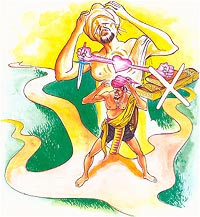
Verse 38. Wisdom Does Not Grow If the Mind Wavers
One of unsteady mind,
who doesn’t know True Dhamma,
who is of wavering confidence
wisdom fails to win.
Explanation: If the mind of a person keeps on wavering, and
if a person does not know the doctrine, if one’s enthusiasm keeps
on fluctuating or flagging,, the wisdom
From Piya Tan
Season Greetings and Happy Lunar New Year!
Buddhism sets you free
Religion imprisons our minds with beliefs, dogmas, rituals and guilt.
There are also religions that do not or dare not call themselves
religion, understandably. But the demand for unquestioning faith is there
all the same.
Call Buddhism what you like, but there is something about Buddhism that
is truly rewarding if we keep an open mind. No, there is nothing to
believe here. Many find this to be one of the hardest things to do. All
right, we can say that Buddhism does begin with some kind of beliefs,
such as keeping the moral precepts so that our body and speech are in
order for the sake of a harmonious family and society. But these are not
beliefs: they are universal truths that make human communion harmonious
and fruitful.
Then there is Buddhist mind-training or meditation, which even other
religions are now adopting. This is because it brings inner peace and
clarity. Ultimately mental stillness has no label. In fact, this is what
the Buddha of early Buddhism is trying to tell us: truth does not belong
to any religion, nor to anyone. It is liberating like the fresh air and
space around us.
There are also Buddhisms that call for mere faith, or some ritual. If
these work for you, use them. At any time, you find that there is
something simpler or better, have the courage to rise to it. Buddhism is
about change, and change is occurring all the time if we carefully
observe ourselves and things around us.
The Buddha’s Buddhism teaches us to keep on letting go of beliefs once we
understand them. It is like learning ABC: we first master them, and then
learn to spell words and make sentences. Then we read interesting books,
and even tell stories to others, and share with them the great wonders of
learning.
Early Buddhism is about self-learning. It is like learning to walk: no
one can walk for us. As toddlers, we crawled and tried to stand, we fell,
stood again, and now we are walking effortlessly (until age catches up,
that is).
Wisdom comes in a similar way. Our sufferings arose from various
conditions we were not sure about, or we could not prevent them for some
reason. But there is a lot to learn from our sufferings. First, we must
accept that there is really no one to blame, except conditions: no sin,
no fate, no demon, no God, no others. Study the conditions, and
understand them, then we will be able to prevent such sufferings, or at
least lessen their effects.
Religions that demand all kinds of beliefs and rituals are trying to own
us. But such religions are nothing but cunning and desperate people who
are trying to control our minds and use our bodies. If any beliefs do not
benefit us (they usually don’t), we should let them go. If we are not
sure what the beliefs are about, it is not benefitting us. The same with
rituals: they should help bring some peace and wisdom to us. If not, we
do not need to do them.
Beliefs and rituals are often nothing more than public relations and
advertisements that money-priests use to hold their clientele and con the
gullible. A belief often means something we are not sure about, and are
not really helpful. If we care to recall our own past: it is a record of
our abandoning belief after belief. That is how we grow, by shedding the
onion-skins of beliefs when the sting of truth opens our eyes.
The rituals that religious professionals charge us for – such as funerals
– can all be even more meaningfully done by us, our relatives and friends
together. If we truly love the dearly departed, we should give him or her
a truly loving friends’ funeral. True and good rituals are not public
show-offs of guilt or wealth, but a powerful gesture of the heart that
feels for others and a good feeling for ourselves.
When Edward Bernays, the “father of public relations,” made a great
fortune selling his ideas to corporations and politicians, it really
benefitted no one except the corporations and politicians, and Bernays.
People in the US were throwing their hard-earned cash into investments,
making a lot of money, and living like intoxicated hamsters in the cage
of pleasure and plenty. They were all heading for the Great Crash of
1929, the beginning of the 12-year Great Depression. They started blaming
everyone else, except themselves.
Now, the religions are using Bernays’ tricks in making us to feel guilty
and sinful about ourselves as if we are not already suffering enough, and
to desire for things (like heaven) that we do not need. Of course, these
religions claim they have all the answers. But these are answers to
problems that these religions themselves have conjured up.
Religions work
best where ignorance and the class system prevail. Yet more evil had been
done in the name of religion than much of the rest of history put
together. Religion burdens us with the greatest of sufferings when they
try to define good and evil for us, even against our better judgement and
common sense. The more powerful the religion the greater the
damage.[1]
Better than any religion is an open curiosity for the healing truth and
liberating insight; a relentless questioning that only brings joy and
peace of helpful answers that fruit in self-understanding. And the best
person to examine and ask such questions is we ourselves. For, if we do
not think for ourselves, we will lose our minds; if we stop feeling, then
we are dead. The chains are mind-made, only the mind can break them.
Piya Tan ©2012
01/15/12
Filed under:
General
Posted by:
site admin @ 7:24 pm
16 01 2012 LESSON 496 Dhammapada
Verse 37 Death’s Snare Can Be Broken By Tamed Mind
FREE ONLINE eNālandā
Research &
Practice UNIVERSITY & BUDDHIST
GOOD NEWS
LETTER
Through http://sarvajan.ambedkar.org
is
SPINNING WHEEL OF DHAMMA
WINNING GOOD KAMMA
To ATTAIN NIBBANA
BY
GIVING MASTERKEY
TO MAYAWATI
OF BSP
With Three Hundred and Three
THE BUDDHIST ON LINE GOOD NEWS LETTER
COURSE PROGRAM
LESSON 496
Practice a Sutta a Day Keeps Dukkha Away
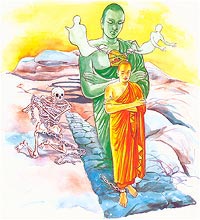
Verse 37. Death’s Snare Can Be Broken By Tamed Mind
Drifting far, straying all alone,
formless, recumbent in a cave.
They will be free from Mara’s bonds
who restrain this mind.
Explanation: The mind is capable of travelling vast distances
- up or down, north or south, east or west - in any direction. It
can travel to the past or the future. It roams about all alone. It
is without any perceptible forms. If an individual were to restrain
the mind fully, he will achieve freedom from the bonds of death.

Mayawati lashes out at EC, releases list of candidiatesAccusing the Election Commission of buckling under Congress pressure,
Uttar Pradesh chief minister Mayawati on Sunday said its direction to
have her statues and those of BSP symbol ‘elephant’ covered were
“anti-dalit” and “casteist”.The BSP chief said that following its constitutional
responsibility with honesty and dedication, the EC should have
issued directives to get Congress’ poll symbol ‘hand’ and RLD’s symbol
‘handpump’ covered like the statues of elephant.“If the EC does
not take right decisions regarding symbols of these two parties, then
the people will consider this decision (with regard to BSP) taken with
an anti-dalit and casteist mentality and under pressure of the
Congress-led government at the Centre,” she claimed.
It was a low-key 56th birthday on Sunday for Uttar Pradesh chief
minister Mayawati, who used the occasion to release the list of 403
candidates for the coming state polls.
“Tickets have been given to 88 SC candidates, 113 OBC, 85 religious
minorities, specially Muslims, 117 upper caste, of which 74 are Brahmins
and 33 Chattriyas,” she said adding this was to honour the concept of
equality.
The BSP is contesting on its own the assembly elections of UP, Punjab and Uttarakhand.
Unlike in the past when a huge cake was cut on her birthday amid
state-wide celebrations and she announced a number of new projects, the
UP CM did not do so this year keeping in view the model code of conduct
ahead of next month’s Assembly polls.
Mayawati said, “due to elections, I have directed all party workers
and well wishers to celebrate my birthday within their families. As a
birthday gift, I want absolute majority in these elections too”.
She said, “the Election Commission made a one-sided decision to cover
statues of elephants and those of mine installed to honour the will of
Kanshiram, without hearing my party”.
“People of ’sarvsamaj’ associated with the movement and other
intellectuals are considering it to be a decision taken with casteist
and anti-dalit mentality,” she said.
Referring to an EC order, the BSP supremo said that the Commission
had removed two officers of the dalit community on the complaints of
opposition parties.
“Statues of elephant were installed as per the Indian culture and not
because of being the BSP symbol. These statues have been installed to
welcome the visitors,” she claimed.
She said that despite the feelings of her party, her government
complied with the EC order of covering her statues, installed as per the
will of Kanshiram, and those of elephants, erected in accordance with
Indian culture.
She said it was “evident” from the reply of Chief Election Commission
last night given to the party that it was a warning to it but she
maintained that the decision was based on “wrong facts”.
http://ccnmtl.columbia.edu/projects/mmt/ambedkar/web/index.html
1 [Introduction—why I am an unlikely President for this Conference]
|
|
[1:] Friends,
I am really sorry for the members of the Jat-Pat-Todak Mandal who have so very kindly invited me to preside
over this Conference. I am sure they will be asked many questions for having selected me as
the President. The Mandal will be asked to explain as to why it has imported a man from Bombay to preside over a
function which is held in Lahore. I believe the Mandal could easily have found someone better
qualified than myself to preside on the occasion. I have criticised the Hindus. I have questioned the authority of
the Mahatma
whom
they revere. They hate me. To them I am a snake in their garden. The
Mandal will no doubt be asked by the politically-minded Hindus to
explain why it has called me to fill this place of honour. It is an act
of great daring. I shall not be surprized if some political Hindus
regard it as an insult. This selection of mine [=me] certainly cannot
please the ordinary religiously-minded Hindus.
|
|
[2:] The Mandal may be asked to explain why
it has disobeyed the Shastric injunction in selecting the President.
According to the Shastras, the Brahmin is appointed to be the Guru for the three Varnas,  , is a direction of the Shastras. The Mandal therefore knows from whom a Hindu , is a direction of the Shastras. The Mandal therefore knows from whom a Hindu
should take his lessons and from whom he should not. The Shastras do
not permit a Hindu to accept anyone as his Guru merely because he is
well-versed. This is made very clear by Ramdas, a Brahmin saint from Maharashtra, who is alleged to have inspired Shivaji to establish a Hindu Raj. In his Dasbodh, a socio-politico-religious treatise in Marathi verse, Ramdas asks, addressing the Hindus, can we accept an Antyaja to be our Guru because he is a Pandit (i.e. learned)? He gives an answer in the negative.
|
|
[3:] What replies to give to these questions
is a matter which I must leave to the Mandal. The Mandal knows best the
reasons which led it to travel to Bombay to select a president, to fix upon a man so repugnant to the Hindus, and to descend so low in the scale as to select an Antyaja—an untouchable— to address an audience of the Savarnas.
As for myself, you will allow me to say that I have accepted the
invitation much against my will, and also against the will of many of my
fellow untouchables. I know that the Hindus are sick of me. I know that I am not a persona grata
[=someone welcome] with them. Knowing all this, I have deliberately
kept myself away from them. I have no desire to inflict myself upon
them. I have been giving expression to my views from my own platform.
This has already caused a great deal of heart-burning and irritation.
|
|
[4:] I have no desire to ascend the platform of the Hindus,
to do within their sight what I have been doing within their hearing.
If I am here it is because of your choice and not because of my wish.
Yours is a cause of social reform. That cause has always made an appeal
to me, and it is because of this that I felt I ought not to refuse an
opportunity of helping the cause—especially when you think that I can
help it. Whether what I am going to say today will help you in any way
to solve the problem you are grappling with, is for you to judge. All I
hope to do is to place before you my views on the problem.
2 [Why social reform is necessary for political reform]
|
|
[1:] The path of social reform, like the path
to heaven (at any rate, in India), is strewn with many difficulties.
Social reform in India has few friends and many critics. The critics
fall into two distinct classes. One class consists of political
reformers, and the other of the Socialists.
|
|
[2:] It was at one time recognized that
without social efficiency, no permanent progress in the other fields of
activity was possible; that owing to mischief wrought by evil customs, Hindu
Society was not in a state of efficiency; and that ceaseless efforts
must be made to eradicate these evils. It was due to the recognition of
this fact that the birth of the National Congress was accompanied by the foundation of the Social Conference.
While the Congress was concerned with defining the weak points in the
political organisation of the country, the Social Conference was engaged
in removing the weak points in the social organisation of the Hindu
Society. For some time the Congress and the Conference worked as two
wings of one common activity, and they held their annual sessions in the
same pandal.
|
|
[3:] But soon the two wings developed into
two parties, a ‘political reform party’ and a ’social reform party’,
between whom there raged a fierce controversy. The ‘political reform
party’ supported the National Congress, and the ’social reform party’ supported the Social Conference.
The two bodies thus became two hostile camps. The point at issue was
whether social reform should precede political reform. For a decade the
forces were evenly balanced, and the battle was fought without victory
to either side.
|
|
[4:] It was, however, evident that the fortunes of the Social Conference
were ebbing fast. The gentlemen who presided over the sessions of the
Social Conference lamented that the majority of the educated Hindus
were for political advancement and indifferent to social reform; and
that while the number of those who attended the Congress was very large,
and the number who did not attend but who sympathized with it was even
larger, the number of those who attended the Social Conference was very
much smaller.
|
|
[5:] This indifference, this thinning of its
ranks, was soon followed by active hostility from the politicians. Under
the leadership of the late Mr. Tilak, the courtesy with which the Congress allowed the Social Conference the use of its pandal
was withdrawn, and the spirit of enmity went to such a pitch that when
the Social Conference desired to erect its own pandal, a threat to burn
the pandal was held out by its opponents. Thus in the course of time the
party in favour of political reform won, and the Social Conference
vanished and was forgotten.
|
|
[6:] The speech delivered by Mr. W. C. Bonnerji in 1892 at Allahabad, as President of the eighth session of the Congress, sounds like a funeral oration on the death of the Social Conference, and is so typical of the Congress attitude that I venture to quote from it the following extract. Mr. Bonnerji said:
“I for one have no patience with those who say we shall not be fit for
political reform until we reform our social system. I fail to see any
connection between the two. . .Are we not fit (for political reform)
because our widows remain unmarried and our girls are given in marriage
earlier than in other countries? because our wives and daughters do not
drive about with us visiting our friends? because we do not send our
daughters to Oxford and Cambridge?” (Cheers [from the audience])
|
|
[7:] I have stated the case for political reform as put by Mr. Bonnerji. There were many who were happy that the victory went to the Congress.
But those who believe in the importance of social reform may ask, is an
argument such as that of Mr. Bonnerji final? Does it prove that the
victory went to those who were in the right? Does it prove conclusively
that social reform has no bearing on political reform? It will help us
to understand the matter if I state the other side of the case. I will
draw upon the treatment of the untouchables for my facts.
|
|
[8:] Under the rule of the Peshwas in the Maratha country, the untouchable was not allowed to use the public streets if a Hindu
was coming along, lest he should pollute the Hindu by his shadow. The
untouchable was required to have a black thread either on his wrist or
around his neck, as a sign or a mark to prevent the Hindus
from getting themselves polluted by his touch by mistake. In Poona, the
capital of the Peshwa, the untouchable was required to carry, strung
from his waist, a broom to sweep away from behind himself the dust he
trod on, lest a Hindu walking on the same dust should be polluted. In Poona,
the untouchable was required to carry an earthen pot hung around his
neck wherever he went—for holding his spit, lest his spit falling on the
earth should pollute a Hindu who might unknowingly happen to tread on
it.
|
|
[9:] Let me take more recent facts. The tyranny practised by the Hindus upon the Balais, an untouchable community in Central India, will serve my purpose. You will find a report of this in the Times of India of 4th January 1928. The correspondent of the Times of India reported that high-caste Hindus—viz., Kalotas, Rajputs and Brahmins, including the Patels and Patwaris of the villages of Kanaria, Bicholi-Hafsi, Bicholi-Mardana, and about 15 other villages in the Indore district (of the Indore State)—informed
the Balais of their respective villages that if they wished to live
among them, they must conform to the following rules:
- Balais must not wear gold-lace-bordered pugrees.
- They must not wear dhotis with coloured or fancy borders.
- They
must convey intimation [=information] of the death of any Hindu to
relatives of the deceased—no matter how far away these relatives may be
living.
- In all Hindu marriages, Balais must play music before the processions and during the marriage.
- Balai women must not wear gold or silver ornaments; they must not wear fancy gowns or jackets.
- Balai women must attend all cases of confinement [=childbirth] of Hindu women.
- Balais must render services without demanding remuneration, and must accept whatever a Hindu is pleased to give.
- If the Balais do not agree to abide by these terms, they must clear out of the villages.
|
|
[10:] The Balais refused to comply; and the Hindu
element proceeded against them. Balais were not allowed to get water
from the village wells; they were not allowed to let go their cattle to
graze. Balais were prohibited from passing through land owned by a
Hindu, so that if the field of a Balai was surrounded by fields owned by
Hindus, the Balai could have no access to his own field. The Hindus
also let their cattle graze down the fields of Balais. The Balais
submitted petitions to the Darbar[=Court of Indore] against these
persecutions; but as they could get no timely relief, and the oppression
continued, hundreds of Balais with their wives and children were
obliged to abandon their homes—in which their ancestors had lived for
generations—and to migrate to adjoining States: that is, to villages in Dhar, Dewas, Bagli, Bhopal, Gwalior and other States. What happened to them in their new homes may for the present be left out of our consideration.
|
|
[11:] The incident at Kavitha in Gujarat happened only last year. The Hindus of Kavitha ordered the untouchables
not to insist upon sending their children to the common village school
maintained by Government. What sufferings the untouchables of Kavitha
had to undergo, for daring to exercise a civic right against the wishes
of the Hindus, is too well known to need detailed description. Another
instance occurred in the village of Zanu, in the Ahmedabad district of Gujarat. In November 1935 some untouchable women of well-to-do families started fetching water in metal pots. The Hindus
looked upon the use of metal pots by untouchables as an affront to
their dignity, and assaulted the untouchable women for their impudence.
|
|
[12:] A most recent event is reported from the village of Chakwara in Jaipur State. It seems from the reports that have appeared in the newspapers that an untouchable of Chakwara who had returned from a pilgrimage had arranged to give a dinner to his fellow untouchables
of the village, as an act of religious piety. The host desired to treat
the guests to a sumptuous meal, and the items served included ghee
(butter) also. But while the assembly of untouchables was engaged in partaking of the food, the Hindus in their hundreds, armed with lathis,
rushed to the scene, despoiled the food, and belaboured the
untouchables—who left the food they had been served with and ran away
for their lives. And why was this murderous assault committed on
defenceless untouchables? The reason given is that the untouchable host
was impudent enough to serve ghee, and his untouchable guests were
foolish enough to taste it. Ghee is undoubtedly a luxury for the rich.
But no one would think that consumption of ghee was a mark of high
social status. The Hindus
of Chakwara thought otherwise, and in righteous indignation avenged
themselves for the wrong done to them by the untouchables, who insulted
them by treating ghee as an item of their food—which they ought to have
known could not be theirs, consistently with the dignity of the Hindus.
This means that an untouchable must not use ghee, even if he can afford
to buy it, since it is an act of arrogance towards the Hindus. This
happened on or about the 1st of April 1936!
|
|
[13:] Having stated the facts, let me now state the case for social reform. In doing this, I will follow Mr. Bonnerji
as nearly as I can, and ask the political-minded Hindus, “Are you fit
for political power even though you do not allow a large class of your
own countrymen like the untouchables
to use public schools? Are you fit for political power even though you
do not allow them the use of public wells? Are you fit for political
power even though you do not allow them the use of public streets? Are
you fit for political power even though you do not allow them to wear
what apparel or ornaments they like? Are you fit for political power
even though you do not allow them to eat any food they like?” I can ask a
string of such questions. But these will suffice.
|
|
[14:] I wonder what would have been the
reply of Mr. Bonnerji. I am sure no sensible man will have the courage
to give an affirmative answer. Every Congressman who repeats the dogma
of Mill
that one country is not fit to rule another country, must admit that
one class is not fit to rule another class. How is it then that the
’social reform party’ lost the battle? To understand this correctly it
is necessary to take note of the kind of social reform which the
reformers were agitating for. In this connection it is necessary to make
a distinction between social reform in the sense of the reform of the Hindu
family, and social reform in the sense of the reorganization and
reconstruction of the Hindu Society. The former has a relation to widow
remarriage, child marriage, etc., while the latter relates to the
abolition of the Caste System.
|
|
[15:] The Social Conference was a body which mainly concerned itself with the reform of the high-caste Hindu family. It consisted mostly of enlightened high-caste Hindus
who did not feel the necessity for agitating for the abolition of
Caste, or had not the courage to agitate for it. They felt quite
naturally a greater urge to remove such evils as enforced widowhood,
child marriages, etc.—evils which prevailed among them and which were
personally felt by them. They did not stand up for the reform of the
Hindu Society. The battle that was fought centered round the question of
the reform of the family. It did not relate to social reform in the
sense of the break-up of the Caste System.
It [=the break-up of the Caste System] was never put in issue by the
reformers. That is the reason why the Social Reform Party lost.
|
|
[16:] I am aware that this argument cannot
alter the fact that political reform did in fact gain precedence over
social reform. But the argument has this much value (if not more): it
explains why social reformers lost the battle. It also helps us to
understand how limited was the victory which the ‘political reform
party’ obtained over the ’social reform party’, and to understand that
the view that social reform need not precede political reform is a view
which may stand only when by social reform is meant the reform of the
family. That political reform cannot with impunity take precedence over
social reform in the sense of the reconstruction of society, is a thesis
which I am sure cannot be controverted.
|
|
[17:] That the makers of political
constitutions must take account of social forces is a fact which is
recognized by no less a person than Ferdinand Lassalle, the friend and co-worker of Karl Marx. In addressing a Prussian audience in 1862, Lassalle said:
The constitutional questions are in the first instance not questions of right but questions of might. The actual constitution
of a country has its existence only in the actual condition of force
which exists in the country: hence political constitutions have value
and permanence only when they accurately express those conditions of
forces which exist in practice within a society.
|
|
[18:] But it is not necessary to go to Prussia. There is evidence at home. What is the significance of the Communal Award,
with its allocation of political power in defined proportions to
diverse classes and communities? In my view, its significance lies in
this: that political constitution
must take note of social organisation. It shows that the politicians
who denied that the social problem in India had any bearing on the
political problem were forced to reckon with the social problem in
devising the Constitution. The Communal Award is, so to say, the nemesis
following upon the indifference to and neglect of social reform. It is a
victory for the Social Reform Party which shows that, though defeated,
they were in the right in insisting upon the importance of social
reform. Many, I know, will not accept this finding. The view is
current—and it is pleasant to believe in it—that the Communal Award is
unnatural and that it is the result of an unholy alliance between the
minorities and the bureaucracy. I do not wish to rely on the Communal
Award as a piece of evidence to support my contention, if it is said
that it is not good evidence.
|
|
[19:] Let us turn to Ireland. What does the history of Irish Home
Rule show? It is well-known that in the course of the negotiations between the representatives
of Ulster and Southern Ireland, Mr. Redmond, the representative of Southern Ireland, in order
to bring Ulster into a Home Rule Constitution
common to the whole of Ireland, said to the representatives of Ulster:
“Ask any political safeguards you like and you shall have them.” What
was the reply that Ulstermen gave? Their reply was, “Damn your
safeguards, we don’t want to be ruled by you on any terms.” People who
blame the minorities in India ought to consider what would have happened
to the political aspirations of the majority, if the minorities had
taken the attitude which Ulster took. Judged by the attitude of Ulster
to Irish Home Rule, is it nothing that the minorities agreed to be ruled
by the majority (which has not shown much sense of statesmanship),
provided some safeguards were devised for them? But this is only
incidental. The main question is, why did Ulster take this attitude? The
only answer I can give is that there was a social problem between
Ulster and Southern Ireland: the problem between Catholics and
Protestants, which is essentially a problem of Caste. That Home Rule in
Ireland would be “Rome Rule” was the way in which the Ulstermen had
framed their answer. But that is only another way of stating that it was
the social problem of Caste between the Catholics and Protestants which
prevented the solution of the political problem. This evidence again is
sure to be challenged. It will be urged that here too the hand of the
Imperialist was at work.
|
|
[20:] But my resources are not exhausted. I
will give evidence from the History of Rome. Here no one can say that
any evil genius was at work. Anyone who has studied the History of Rome
will know that the Republican Constitution of Rome bore marks having strong resemblance to the Communal Award.
When the kingship in Rome was abolished, the kingly power (or the
Imperium) was divided between the Consuls and the Pontifex Maximus. In
the Consuls was vested the secular authority of the King, while the
latter took over the religious authority of the King. This Republican
Constitution had provided that of the two Consuls, one was to be
Patrician and the other Plebian. The same Constitution had also provided
that of the Priests under the Pontifex Maximus, half were to be
Plebians and the other half Patricians. Why is it that the Republican
Constitution of Rome had these provisions—which, as I said, resemble so
strongly the provisions of the Communal Award? The only answer one can
get is that the Constitution of Republican Rome had to take account of
the social division between the Patricians and the Plebians, who formed
two distinct castes. To sum up, let political reformers turn in any
direction they like: they will find that in the making of a
constitution, they cannot ignore the problem arising out of the
prevailing social order.
|
|
[21:] The illustrations which I have taken
in support of the proposition that social and religious problems have a
bearing on political constitutions seem to be too particular. Perhaps
they are. But it should not be supposed that the bearing of the one on
the other is limited. On the other hand, one can say that generally
speaking, History bears out the proposition that political revolutions
have always been preceded by social and religious revolutions. The
religious Reformation started by Luther was the precursor of the
political emancipation of the European people. In England, Puritanism
led to the establishment of political liberty. Puritanism founded the
new world. It was Puritanism that won the war of American Independence,
and Puritanism was a religious movement.
|
|
[22:] The same is true of the Muslim Empire. Before the Arabs became a political power, they had undergone a thorough religious revolution started by the Prophet Mohammad. Even Indian History supports the same conclusion. The political revolution led by Chandragupta was preceded by the religious and social revolution of Buddha. The political revolution led by Shivaji was preceded by the religious and social reform brought about by the saints of Maharashtra. The political revolution of the Sikhs was preceded by the religious and social revolution led by Guru Nanak.
It is unnecessary to add more illustrations. These will suffice to show
that the emancipation of the mind and the soul is a necessary
preliminary for the political expansion of the people.
|
3 [Why social reform is necessary for economic reform]
|
|
[1:] Let me now turn to the Socialists. Can
the Socialists ignore the problem arising out of the social order? The
Socialists of India, following their fellows in Europe, are seeking to
apply the economic interpretation of history to the facts of India. They
propound that man is an economic creature, that his activities and
aspirations are bound by economic facts, that property is the only
source of power. They therefore preach that political and social reforms
are but gigantic illusions, and that economic reform by equalization of
property must have precedence over every other kind of reform. One may
take issue with every one of these premises—on which rests the
Socialists’ case for economic reform as having priority over every other
kind of reform. One may contend that the economic motive is not the
only motive by which man is actuated. That economic power is the only
kind of power, no student of human society can accept.
|
|
[2:] That the social status of an individual
by itself often becomes a source of power and authority, is made clear
by the sway which the Mahatmas have held over the common man. Why do millionaires in India obey penniless Sadhus and Fakirs? Why do millions of paupers in India sell their trifling trinkets which constitute their only wealth, and go to Benares and Mecca?
That religion is the source of power is illustrated by the history of
India, where the priest holds a sway over the common man often greater
than that of the magistrate, and where everything, even such things as
strikes and elections, so easily takes a religious turn and can so
easily be given a religious twist.
|
|
[3:] Take the case of the Plebians of Rome,
as a further illustration of the power of religion over man. It throws
great light on this point. The Plebians had fought for a share in the
supreme executive under the Roman Republic, and had secured the
appointment of a Plebian Consul elected by a separate electorate
constituted by the Commitia Centuriata, which was an assembly of
Plebians. They wanted a Consul of their own because they felt that the
Patrician Consuls used to discriminate against the Plebians in carrying
on the administration. They had apparently obtained a great gain,
because under the Republican Constitution of Rome one Consul had the
power of vetoing an act of the other Consul.
|
|
[4:] But did they in fact gain anything? The
answer to this question must be in the negative. The Plebians never
could get a Plebian Consul who could be said to be a strong man, and who
could act independently of the Patrician Consul. In the ordinary course
of things the Plebians should have got a strong Plebian Consul, in view
of the fact that his election was to be by a separate electorate of
Plebians. The question is, why did they fail in getting a strong Plebian
to officiate as their Consul?
|
|
[5:] The answer to this question reveals the
dominion which religion exercises over the minds of men. It was an
accepted creed of the whole Roman populus [=people] that no
official could enter upon the duties of his office unless the Oracle of
Delphi declared that he was acceptable to the Goddess. The priests who
were in charge of the temple of the Goddess of Delphi were all
Patricians. Whenever therefore the Plebians elected a Consul who was
known to be a strong party man and opposed to the Patricians—or
“communal,” to use the term that is current in India—the Oracle
invariably declared that he was not acceptable to the Goddess. This is
how the Plebians were cheated out of their rights.
|
|
[6:] But what is worthy of note is that the
Plebians permitted themselves to be thus cheated because they too, like
the Patricians, held firmly the belief that the approval of the Goddess
was a condition precedent to the taking charge by an official of his
duties, and that election by the people was not enough. If the Plebians
had contended that election was enough and that the approval by the
Goddess was not necessary, they would have derived the fullest benefit
from the political right which they had obtained. But they did not. They
agreed to elect another, less suitable to themselves but more suitable
to the Goddess—which in fact meant more amenable to the Patricians.
Rather than give up religion, the Plebians give up the material gain for
which they had fought so hard. Does this not show that religion can be a
source of power as great as money, if not greater?
|
|
[7:] The fallacy of the Socialists lies in
supposing that because in the present stage of European Society property
as a source of power is predominant, that the same is true of India, or
that the same was true of Europe in the past. Religion, social status,
and property are all sources of power and authority, which one man has,
to control the liberty of another. One is predominant at one stage; the
other is predominant at another stage. That is the only difference. If
liberty is the ideal, if liberty means the destruction of the dominion
which one man holds over another, then obviously it cannot be insisted
upon that economic reform must be the one kind of reform worthy of
pursuit. If the source of power and dominion is, at any given time or in
any given society, social and religious, then social reform and
religious reform must be accepted as the necessary sort of reform.
|
|
[8:] One can thus attack the doctrine of the
Economic Interpretation of History adopted by the Socialists of India.
But I recognize that the economic interpretation of history is not
necessary for the validity of the Socialist contention that equalization
of property is the only real reform and that it must precede everything
else. However, what I would like to ask the Socialists is this: Can you
have economic reform without first bringing about a reform of the
social order? The Socialists of India do not seem to have considered
this question. I do not wish to do them an injustice. I give below a
quotation from a letter which a prominent Socialist wrote a few days ago
to a friend of mine, in which he said, “I do not believe that we can
build up a free society in India so long as there is a trace of this
ill-treatment and suppression of one class by another. Believing as I do
in a socialist ideal, inevitably I believe in perfect equality in the
treatment of various classes and groups. I think that Socialism offers
the only true remedy for this as well as other problems.”
|
|
[9:] Now the question that I would like to
ask is: Is it enough for a Socialist to say, “I believe in perfect
equality in the treatment of the various classes?” To say that such a
belief is enough is to disclose a complete lack of understanding of what
is involved in Socialism. If Socialism is a practical programme and is
not merely an ideal, distant and far off, the question for a Socialist
is not whether he believes in equality. The question for him is whether
he minds one class ill-treating and suppressing another class as a
matter of system, as a matter of principle—and thus allowing tyranny and
oppression to continue to divide one class from another.
|
|
[10:] Let me analyse the factors that are
involved in the realization of Socialism, in order to explain fully my
point. Now it is obvious that the economic reform contemplated by the
Socialists cannot come about unless there is a revolution resulting in
the seizure of power. That seizure of power must be by a proletariat.
The first question I ask is: Will the proletariat of India combine to
bring about this revolution? What will move men to such an action? It
seems to me that, other things being equal, the only thing that will
move one man to take such an action is the feeling that other men with
whom he is acting are actuated by a feeling of equality and fraternity
and—above all—of justice. Men will not join in a revolution for the
equalization of property unless they know that after the revolution is
achieved they will be treated equally, and that there will be no
discrimination of caste and creed.
|
|
[11:] The assurance of a Socialist leading
the revolution that he does not believe in Caste, I am sure will not
suffice. The assurance must be the assurance proceeding from a much
deeper foundation—namely, the mental attitude of the compatriots towards
one another in their spirit of personal equality and fraternity. Can it
be said that the proletariat of India, poor as it is, recognises no
distinctions except that of the rich and the poor? Can it be said that
the poor in India recognize no such distinctions of caste or creed, high
or low? If the fact is that they do, what unity of front can be
expected from such a proletariat in its action against the rich? How can
there be a revolution if the proletariat cannot present a united front?
|
|
[12:] Suppose for the sake of argument that
by some freak of fortune a revolution does take place and the Socialists
come into power; will they not have to deal with the problems created
by the particular social order prevalent in India? I can’t see how a
Socialist State in India can function for a second without having to
grapple with the problems created by the prejudices which make Indian
people observe the distinctions of high and low, clean and unclean. If
Socialists are not to be content with the mouthing of fine phrases, if
the Socialists wish to make Socialism a definite reality, then they must
recognize that the problem of social reform is fundamental, and that
for them there is no escape from it.
|
|
[13:] That the social order prevalent in
India is a matter which a Socialist must deal with; that unless he does
so he cannot achieve his revolution; and that if he does achieve it as a
result of good fortune, he will have to grapple with the social order
if he wishes to realize his ideal—is a proposition which in my opinion
is incontrovertible. He will be compelled to take account of Caste after
the revolution, if he does not take account of it before the
revolution. This is only another way of saying that, turn in any
direction you like, Caste is the monster that crosses your path. You
cannot have political reform, you cannot have economic reform, unless
you kill this monster.
|
|
4 [Caste is not just a division of labour, it is a division of labourers]
|
|
[1:] It is a pity that Caste even today has its defenders. The defences are many. It is defended on the ground that the Caste System
is but another name for division of labour; and if division of labour
is a necessary feature of every civilized society, then it is argued
that there is nothing wrong in the Caste System. Now the first thing
that is to be urged against this view is that the Caste System is not
merely a division of labour. It is also a division of labourers.
Civilized society undoubtedly needs division of labour. But in no
civilized society is division of labour accompanied by this unnatural
division of labourers into watertight compartments. The Caste System is
not merely a division of labourers which is quite different from
division of labour—it is a hierarchy in which the divisions of labourers
are graded one above the other. In no other country is the division of
labour accompanied by this gradation of labourers.
|
|
[2:] There is also a third point of criticism against this view of the Caste System.
This division of labour is not spontaneous, it is not based on natural
aptitudes. Social and individual efficiency requires us to develop the
capacity of an individual to the point of competency to choose and to
make his own career. This principle is violated in the Caste System, in
so far as it involves an attempt to appoint tasks to individuals in
advance—selected not on the basis of trained original capacities, but on
that of the social status of the parents.
|
|
[3:] Looked at from another point of view, this stratification of occupations which is the result of the Caste System
is positively pernicious. Industry is never static. It undergoes rapid
and abrupt changes. With such changes, an individual must be free to
change his occupation. Without such freedom to adjust himself to
changing circumstances, it would be impossible for him to gain his
livelihood. Now the Caste System will not allow Hindus
to take to occupations where they are wanted, if they do not belong to
them by heredity. If a Hindu is seen to starve rather than take to new
occupations not assigned to his Caste, the reason is to be found in the
Caste System. By not permitting readjustment of occupations, Caste
becomes a direct cause of much of the unemployment we see in the
country.
|
|
[4:] As a form of division of labour, the Caste system
suffers from another serious defect. The division of labour brought
about by the Caste System is not a division based on choice. Individual
sentiment, individual preference, has no place in it. It is based on the
dogma of predestination. Considerations of social efficiency would
compel us to recognize that the greatest evil in the industrial system
is not so much poverty and the suffering that it involves, as the fact
that so many persons have callings [=occupations] which make no appeal
to those who are engaged in them. Such callings constantly provoke one
to aversion, ill will, and the desire to evade.
|
|
[5:] There are many occupations in India
which, on account of the fact that they are regarded as degraded by the
Hindus, provoke those who are engaged in them to aversion. There is a
constant desire to evade and escape from such occupations, which arises
solely because of the blighting effect which they produce upon those who
follow them, owing to the slight and stigma cast upon them by the Hindu
religion. What efficiency can there be in a system under which neither
men’s hearts nor their minds are in their work? As an economic
organization Caste is therefore a harmful institution, inasmuch as it
involves the subordination of man’s natural powers and inclinations to
the exigencies of social rules.
|
5 [Caste cannot preserve a nonexistent “racial purity”]
|
|
[1:] Some have dug a biological trench in defence of the Caste System.
It is said that the object of Caste was to preserve purity of race and
purity of blood. Now ethnologists are of the opinion that men of pure
race exist nowhere and that there has been a mixture of all races in all
parts of the world. Especially is this the case with the people of
India. Mr. D. R. Bhandarkar in his paper on “Foreign Elements in the Hindu
Population” has stated that “There is hardly a class or Caste in India
which has not a foreign strain in it. There is an admixture of alien
blood not only among the warrior classes—the Rajputs and the Marathas—but also among the Brahmins
who are under the happy delusion that they are free from all foreign
elements.” The Caste system cannot be said to have grown as a means of
preventing the admixture of races, or as a means of maintaining purity
of blood.
|
|
[2:] As a matter of fact [the] Caste system
came into being long after the different races of India had commingled
in blood and culture. To hold that distinctions of castes are really
distinctions of race, and to treat different castes as though they were
so many different races, is a gross perversion of facts. What racial
affinity is there between the Brahmin of the Punjab and the Brahmin of Madras? What racial affinity is there between the untouchable of Bengal and the untouchable of Madras? What racial difference is there between the Brahmin of the Punjab and the Chamar of the Punjab? What racial difference is there between the Brahmin of Madras and the Pariah
of Madras? The Brahmin of the Punjab is racially of the same stock as
the Chamar of the Punjab, and the Brahmin of Madras is of the same race
as the Pariah of Madras.
|
|
[3:] [The] Caste system
does not demarcate racial division. [The] Caste system is a social
division of people of the same race. Assuming it, however, to be a case
of racial divisions, one may ask: What harm could there be if a mixture
of races and of blood was permitted to take place in India by
intermarriages between different castes? Men are no doubt divided from
animals by so deep a distinction that science recognizes men and animals
as two distinct species. But even scientists who believe in purity of
races do not assert that the different races constitute different
species of men. They are only varieties of one and the same species. As
such they can interbreed and produce an offspring which is capable of
breeding and which is not sterile.
|
|
[4:] An immense lot of nonsense is talked about heredity and eugenics in defence of the Caste System.
Few would object to the Caste System if it was in accord with the basic
principle of eugenics, because few can object to the improvement of the
race by judicious mating. But one fails to understand how the Caste
System secures judicious mating. [The] Caste System is a negative thing.
It merely prohibits persons belonging to different castes from
intermarrying. It is not a positive method of selecting which two among a
given caste should marry.
|
|
[5:] If Caste is eugenic in origin, then the origin of sub-castes
must also be eugenic. But can anyone seriously maintain that the origin
of sub-castes is eugenic? I think it would be absurd to contend for
such a proposition, and for a very obvious reason. If caste means race,
then differences of sub-castes cannot mean differences of race, because
sub-castes become ex hypothesia[=by hypothesis] sub-divisions of
one and the same race. Consequently the bar against intermarrying and
interdining between sub-castes cannot be for the purpose of maintaining
purity of race or of blood. If sub-castes cannot be eugenic in origin,
there cannot be any substance in the contention that Caste is eugenic in
origin.
|
|
[6:] Again, if Caste is eugenic in origin one
can understand the bar against intermarriage. But what is the purpose
of the interdict placed on interdining between castes and sub-castes
alike? Interdining cannot infect blood, and therefore cannot be the
cause either of the improvement or of [the] deterioration of the race.
|
|
[7:] This shows that Caste has no scientific
origin, and that those who are attempting to give it an eugenic basis
are trying to support by science what is grossly unscientific. Even
today, eugenics cannot become a practical possibility unless we have definite knowledge regarding the laws of heredity. Prof. Bateson
in his Mendel’s Principles of Heredity says, “There is nothing in the
descent of the higher mental qualities to suggest that they follow any
single system of transmission. It is likely that both they and the more
marked developments of physical powers result rather from the
coincidence of numerous factors than from the possession of any one
genetic element.” To argue that the Caste System was eugenic in its conception is to attribute to the forefathers of present-day Hindus a knowledge of heredity which even the modern scientists do not possess.
|
|
[8:] A tree should be judged by the fruits it
yields. If Caste is eugenic, what sort of a race of men should it have
produced? Physically speaking the Hindus are a C3
people. They are a race of Pygmies and dwarfs, stunted in stature and
wanting in stamina. It is a nation 9/10ths of which is declared to be
unfit for military service. This shows that the Caste System does not embody the eugenics of modern scientists. It is a social system which embodies the arrogance and selfishness of a perverse section of the Hindus who were superior enough in social status to set it in fashion, and who had the authority to force it on their inferiors.
|
6 [Caste prevents Hindus from forming a real society or nation]
|
|
[1:] Caste does not result in economic
efficiency. Caste cannot improve, and has not improved, the race. Caste
has however done one thing. It has completely disorganized and
demoralized the Hindus.
|
|
[2:] The first and foremost thing that must be recognized is that Hindu Society is a myth. The name Hindu is itself a foreign name. It was given by the Mohammedans to the natives for the purpose of distinguishing themselves [from them]. It does not occur in any Sanskrit work prior to the Mohammedan invasion.
They did not feel the necessity of a common name, because they had no
conception of their having constituted a community. Hindu Society as
such does not exist. It is only a collection of castes. Each caste is
conscious of its existence. Its survival is the be-all and end-all of
its existence. Castes do not even form a federation. A caste has no
feeling that it is affiliated to other castes, except when there is a
Hindu-Muslim riot. On all other occasions each caste endeavours to
segregate itself and to distinguish itself from other castes.
|
|
[3:] Each caste not only dines among itself
and marries among itself, but each caste prescribes its own distinctive
dress. What other explanation can there be of the innumerable styles of
dress worn by the men and women of India, which so amuse the tourists?
Indeed the ideal Hindu
must be like a rat living in his own hole, refusing to have any contact
with others. There is an utter lack among the Hindus of what the
sociologists call “consciousness of kind.” There is no Hindu
consciousness of kind. In every Hindu the consciousness that exists is
the consciousness of his caste. That is the reason why the Hindus cannot
be said to form a society or a nation.
|
|
[4:] There are, however, many Indians whose
patriotism does not permit them to admit that Indians are not a nation,
that they are only an amorphous mass of people. They have insisted that
underlying the apparent diversity there is a fundamental unity which
marks the life of the Hindus, inasmuch as there is a similarity of those
habits and customs, beliefs and thoughts, which obtain all over the
continent of India. Similarity in habits and customs, beliefs and
thoughts, there is. But one cannot accept the conclusion that therefore,
the Hindus
constitute a society. To do so is to misunderstand the essentials which
go to make up a society. Men do not become a society by living in
physical proximity, any more than a man ceases to be a member of his
society by living so many miles away from other men.
|
|
[5:] Secondly, similarity in habits and
customs, beliefs and thoughts, is not enough to constitute men into
society. Things may be passed physically from one to another like
bricks. In the same way habits and customs, beliefs and thoughts of one
group may be taken over by another group, and there may thus appear a
similarity between the two. Culture spreads by diffusion, and that is
why one finds similarity between various primitive tribes in the matter
of their habits and customs, beliefs and thoughts, although they do not
live in proximity. But no one could say that because there was this
similarity, the primitive tribes constituted one society. This is
because similarity in certain things is not enough to constitute a
society.
|
|
[6:] Men constitute a society because they
have things which they possess in common. To have similar things is
totally different from possessing things in common. And the only way by
which men can come to possess things in common with one another is by
being in communication with one another. This is merely another way of
saying that Society continues to exist by communication—indeed, in
communication. To make it concrete, it is not enough if men act in a way
which agrees with the acts of others. Parallel activity, even if
similar, is not sufficient to bind men into a society.
|
|
[7:] This is proved by the fact that the festivals observed by the different castes amongst the Hindus
are the same. Yet these parallel performances of similar festivals by
the different castes have not bound them into one integral whole. For
that purpose what is necessary is for a man to share and participate in a
common activity, so that the same emotions are aroused in him that
animate the others. Making the individual a sharer or partner in the
associated activity, so that he feels its success as his success, its
failure as his failure, is the real thing that binds men and makes a
society of them. The Caste System
prevents common activity; and by preventing common activity, it has
prevented the Hindus from becoming a society with a unified life and a
consciousness of its own being.
|
7 [The worst feature of the Caste System is an anti-social spirit]
|
|
[1:] The Hindus
often complain of the isolation and exclusiveness of a gang or a clique
and blame them for anti-social spirit. But they conveniently forget
that this anti-social spirit is the worst feature of their own Caste System.
One caste enjoys singing a hymn of hate against another caste as much
as the Germans enjoyed singing their hymn of hate against the English
during the last war [=World War I]. The literature of the Hindus is
full of caste genealogies in which an attempt is made to give a noble
origin to one caste and an ignoble origin to other castes. The Sahyadrikhand is a notorious instance of this class of literature.
|
|
[2:] This anti-social spirit is not confined to caste alone. It has gone deeper and has poisoned the mutual relations of the sub-castes as well. In my province the Golak Brahmins,
Deorukha Brahmins, Karada Brahmins, Palshe Brahmins, and Chitpavan
Brahmins all claim to be sub-divisions of the Brahmin caste. But the
anti-social spirit that prevails between them is quite as marked and
quite as virulent as the anti-social spirit that prevails between them
and other non-Brahmin castes. There is nothing strange in this. An
anti-social spirit is found wherever one group has “interests of its
own” which shut it out from full interaction with other groups, so that
its prevailing purpose is protection of what it has got.
|
|
[3:] This anti-social spirit, this spirit of
protecting its own interests, is as much a marked feature of the
different castes in their isolation from one another as it is of nations
in their isolation. The Brahmin’s primary concern is to protect “his
interest” against those of the non-Brahmins;
and the non-Brahmins’ primary concern is to protect their interests
against those of the Brahmins. The Hindus, therefore, are not merely an
assortment of castes, but are so many warring groups, each living for
itself and for its selfish ideal.
|
|
[4:] There is another feature of caste which
is deplorable. The ancestors of the present-day English fought on one
side or the other in the Wars of the Roses and the Cromwellian War. But
the descendants of those who fought on the one side do not bear any
animosity—any grudge—against the descendents of those who fought on the
other side. The feud is forgotten. But the present-day non-Brahmins
cannot forgive the present-day Brahmins for the insult their ancestors gave to Shivaji. The present-day Kayasthas will not forgive the present-day Brahmins for the infamy cast upon their forefathers by the forefathers of the latter. To what is this difference due? Obviously to the Caste System.
The existence of Caste and Caste Consciousness has served to keep the
memory of past feuds between castes green, and has prevented solidarity.
|
8 [Caste prevents the uplift and incorporation of the aboriginal tribes]
|
|
[1:] The recent [constitutional]
discussion about the excluded and partially included areas has served
to draw attention to the position of what are called the aboriginal tribes
in India. They number about 13 millions, if not more. Apart from the
question of whether their exclusion from the new Constitution is proper
or improper, the fact still remains that these aborigines have remained
in their primitive uncivilized state in a land which boasts of a
civilization thousands of years old. Not only are they not civilized,
but some of them follow pursuits which have led to their being classified as criminals.
|
|
[2:] Thirteen millions of people living in
the midst of civilization are still in a savage state, and are leading
the life of hereditary criminals!! But the Hindus
have never felt ashamed of it. This is a phenomenon which in my view is
quite unparalleled. What is the cause of this shameful state of
affairs? Why has no attempt been made to civilize these aborigines and
to lead them to take to a more honourable way of making a living?
|
|
[3:] The Hindus
will probably seek to account for this savage state of the aborigines
by attributing to them congenital stupidity. They will probably not
admit that the aborigines have remained savages because they had made no
effort to civilize them, to give them medical aid, to reform them, to
make them good citizens. But supposing a Hindu wished to do what the Christian missionary
is doing for these aborigines, could he have done it? I submit not.
Civilizing the aborigines means adopting them as your own, living in
their midst, and cultivating fellow-feeling—in short, loving them. How
is it possible for a Hindu to do this? His whole life is one anxious
effort to preserve his caste. Caste is his precious possession which he
must save at any cost. He cannot consent to lose it by establishing
contact with the aborigines, the remnants of the hateful Anaryas of the Vedic days.
|
|
[4:] Not that a Hindu
could not be taught the sense of duty to fallen humanity, but the
trouble is that no amount of sense of duty can enable him to overcome
his duty to preserve his caste. Caste is, therefore, the real
explanation as to why the Hindu has let the savage remain a savage in
the midst of his civilization without blushing, or without feeling any
sense of remorse or repentance. The Hindu has not realized that these
aborigines are a source of potential danger. If these savages remain
savages, they may not do any harm to the Hindus. But if they are
reclaimed by non-Hindus and converted to their faiths, they will swell
the ranks of the enemies of the Hindus. If this happens, the Hindu will
have to thank himself and his Caste System.
9 [The higher castes have conspired to keep the lower castes down]
|
|
[1:] Not only has the Hindu
made no effort for the humanitarian cause of civilizing the savages,
but the higher-caste Hindus have deliberately prevented the lower castes
who are within the pale of Hinduism from rising to the cultural level
of the higher castes. I will give two instances, one of the Sonars and the other of the Pathare Prabhus. Both are communities quite well-known in Maharashtra.
Like the rest of the communities desiring to raise their status, these
two communities were at one time endeavouring to adopt some of the ways
and habits of the Brahmins.
|
|
[2:] The Sonars were styling themselves Daivadnya Brahmins and were wearing their “dhotis” with folds in them, and using the word namaskar for salutation. Both the folded way of wearing the “dhoti” and the namaskar were
special to the Brahmins. The Brahmins did not like this imitation and
this attempt by Sonars to pass off as Brahmins. Under the authority of
the Peshwas,
the Brahmins successfully put down this attempt on the part of the
Sonars to adopt the ways of the Brahmins. They even got the President of
the Councils of the East India Company’s settlement in Bombay to issue a prohibitory order against the Sonars residing in Bombay.
|
|
[3:] At one time the Pathare Prabhus
had widow-remarriage as a custom of their caste. This custom of
widow-remarriage was later on looked upon as a mark of social
inferiority by some members of the caste, especially because it was
contrary to the custom prevalent among the Brahmins.
With the object of raising the status of their community, some Pathare
Prabhus sought to stop this practice of widow-remarriage that was
prevalent in their caste. The community was divided into two camps, one
for and the other against the innovation. The Peshwas
took the side of those in favour of widow-remarriage, and thus
virtually prohibited the Pathare Prabhus from following the ways of the
Brahmins.
|
|
[4:] The Hindus criticise the Mohammedans
for having spread their religion by the use of the sword. They also
ridicule Christianity on the score of the Inquisition. But really
speaking, who is better and more worthy of our respect—the Mohammedans
and Christians who attempted to thrust down the throats of unwilling
persons what they regarded as necessary for their salvation, or the Hindu
who would not spread the light, who would endeavour to keep others in
darkness, who would not consent to share his intellectual and social
inheritance with those who are ready and willing to make it a part of
their own make-up? I have no hesitation in saying that if the Mohammedan
has been cruel, the Hindu has been mean; and meanness is worse than
cruelty.
10 [Caste prevents Hinduism from being a missionary religion]
|
|
[1:] Whether the Hindu
religion was or was not a missionary religion has been a controversial
issue. Some hold the view that it was never a missionary religion.
Others hold that it was. That the Hindu religion was once a missionary
religion must be admitted. It could not have spread over the face of
India, if it was not a missionary religion. That today it is not a
missionary religion is also a fact which must be accepted. The question
therefore is not whether or not the Hindu religion was a missionary
religion. The real question is, why did the Hindu religion cease to be a
missionary religion?
|
|
[2:] My answer is this: the Hindu religion ceased to be a missionary religion when the Caste System
grew up among the Hindus. Caste is inconsistent with conversion.
Inculcation of beliefs and dogmas is not the only problem that is
involved in conversion. To find a place for the convert in the social
life of the community is another, and a much more important, problem
that arises in connection with conversion. That problem is where to
place the convert, in what caste? It is a problem which must baffle
every Hindu wishing to make aliens converts to his religion.
|
|
[3:] Unlike a club, the membership of a caste
is not open to all and sundry. The law of Caste confines its membership
to persons born in the caste. Castes are autonomous, and there is no
authority anywhere to compel a caste to admit a new-comer to its social
life. Hindu
Society being a collection of castes, and each caste being a closed
corporation, there is no place for a convert. Thus it is the caste which
has prevented the Hindus
from expanding and from absorbing other religious communities. So long
as Caste remains, Hindu religion cannot be made a missionary religion,
and Shudhi will be both a folly and a futility.
11 [Caste deprives Hindus of mutual help, trust, and fellow-feeling]
|
|
[1:] The reasons which have made Shudhi impossible for Hindus are also responsible for making Sanghatan impossible. The idea underlying Sanghatan is to remove from the mind of the Hindu
that timidity and cowardice which so painfully mark him off from the
Mohammedan and the Sikh, and which have led him to adopt the low ways of
treachery and cunning for protecting himself. The question naturally
arises: From where does the Sikh or the Mohammedan derive his strength,
which makes him brave and fearless? I am sure it is not due to relative
superiority of physical strength, diet, or drill. It is due to the
strength arising out of the feeling that all Sikhs will come to the rescue of a Sikh when he is in danger, and that all Mohammedans will rush to save a Muslim if he is attacked.
|
|
[2:] The Hindu
can derive no such strength. He cannot feel assured that his fellows
will come to his help. Being one and fated to be alone, he remains
powerless, develops timidity and cowardice, and in a fight surrenders or
runs away. The Sikh as well as the Muslim
stands fearless and gives battle, because he knows that though one he
will not be alone. The presence of this belief in the one helps him to
hold out, and the absence of it in the other makes him to give way.
|
|
[3:] If you pursue this matter further and
ask what is it that enables the Sikh and the Mohammedan to feel so
assured, and why is the Hindu
filled with such despair in the matter of help and assistance, you will
find that the reasons for this difference lie in the difference in
their associated mode of living. The associated mode of life practised
by the Sikhs and the Mohammedans produces fellow-feeling. The associated mode of life of the Hindus does not. Among Sikhs and Muslims there is a social cement which makes them Bhais. Among Hindus
there is no such cement, and one Hindu does not regard another Hindu as
his Bhai. This explains why a Sikh says and feels that one Sikh, or one
Khalsa, is equal to sava lakh
men. This explains why one Mohammedan is equal to a crowd of Hindus.
This difference is undoubtedly a difference due to Caste. So long as
Caste remains, there will be no Sanghatan; and so long as there is no Sanghatan the Hindu will remain weak and meek.
|
|
[4:] The Hindus
claim to be a very tolerant people. In my opinion this is a mistake. On
many occasions they can be intolerant, and if on some occasions they
are tolerant, that is because they are too weak to oppose or too
indifferent to oppose. This indifference of the Hindus has become so
much a part of their nature that a Hindu will quite meekly tolerate an
insult as well as a wrong. You see amongst them, to use the words of Morris,
“The great treading down the little, the strong beating down the weak,
cruel men fearing not, kind men daring not and wise men caring not.”
With the Hindu Gods all-forbearing, it is not difficult to imagine the
pitiable condition of the wronged and the oppressed among the Hindus.
Indifferentism is the worst kind of disease that can infect a people.
Why is the Hindu so indifferent? In my opinion this indifferentism is
the result of the Caste System, which has made Sanghatan and co-operation even for a good cause impossible.
12 [Caste is a powerful weapon for preventing all reform]
|
|
[1:] The assertion by the individual of his
own opinions and beliefs, his own independence and interest—as over
against group standards, group authority, and group interests—is the
beginning of all reform. But whether the reform will continue depends
upon what scope the group affords for such individual assertion. If the
group is tolerant and fair-minded in dealing with such individuals, they
will continue to assert [their beliefs], and in the end will succeed in
converting their fellows. On the other hand if the group is intolerant,
and does not bother about the means it adopts to stifle such
individuals, they will perish and the reform will die out.
|
|
[2:] Now a caste has an unquestioned right to
excommunicate any man who is guilty of breaking the rules of the caste;
and when it is realized that excommunication involves a complete cesser
[=cessation] of social intercourse, it will be agreed that as a form of
punishment there is really little to choose between excommunication and
death. No wonder individual Hindus have not had the courage to assert their independence by breaking the barriers of Caste.
|
|
[3:] It is true that man cannot get on with
his fellows. But it is also true that he cannot do without them. He
would like to have the society of his fellows on his terms. If he cannot
get it on his terms, then he will be ready to have it on any terms,
even amounting to complete surrender. This is because he cannot do
without society. A caste is ever ready to take advantage of the
helplessness of a man, and to insist upon complete conformity to its
code in letter and in spirit.
|
|
[4:] A caste can easily organize itself into a
conspiracy to make the life of a reformer a hell; and if a conspiracy
is a crime, I do not understand why such a nefarious act as an attempt
to excommunicate a person for daring to act contrary to the rules of
caste should not be made an offence punishable in law. But as it is,
even law gives each caste an autonomy to regulate its membership and
punish dissenters with excommunication. Caste in the hands of the
orthodox has been a powerful weapon for persecuting the reformers and
for killing all reform.
13 [Caste destroys public spirit, public opinion, and public charity]
|
|
[1:] The effect of caste on the ethics of the Hindus
is simply deplorable. Caste has killed public spirit. Caste has
destroyed the sense of public charity. Caste has made public opinion
impossible. A Hindu’s
public is his caste. His responsibility is only to his caste. His
loyalty is restricted only to his caste. Virtue has become caste-ridden,
and morality has become caste-bound. There is no sympathy for the
deserving. There is no appreciation of the meritorious. There is no
charity to the needy. Suffering as such calls for no response. There is
charity, but it begins with the caste and ends with the caste. There is
sympathy, but not for men of other castes.
|
|
[2:] Would a Hindu acknowledge and follow the leadership of a great and good man? The case of a Mahatma apart, the answer must be that he will follow a leader if he is a man of his caste. A Brahmin will follow a leader only if he is a Brahmin, a Kayastha
if he is a Kayastha, and so on. The capacity to appreciate merits in a
man, apart from his caste, does not exist in a Hindu. There is
appreciation of virtue, but only when the man is a fellow caste-man. The
whole morality is as bad as tribal morality. My caste-man, right or
wrong; my caste-man, good or bad. It is not a case of standing by virtue
or not standing by vice. It is a case of standing by, or not standing
by, the caste. Have not Hindus committed treason against their country
in the interests of their caste?
13 [Caste destroys public spirit, public opinion, and public charity]
|
|
[1:] The effect of caste on the ethics of the Hindus
is simply deplorable. Caste has killed public spirit. Caste has
destroyed the sense of public charity. Caste has made public opinion
impossible. A Hindu’s
public is his caste. His responsibility is only to his caste. His
loyalty is restricted only to his caste. Virtue has become caste-ridden,
and morality has become caste-bound. There is no sympathy for the
deserving. There is no appreciation of the meritorious. There is no
charity to the needy. Suffering as such calls for no response. There is
charity, but it begins with the caste and ends with the caste. There is
sympathy, but not for men of other castes.
|
|
[2:] Would a Hindu acknowledge and follow the leadership of a great and good man? The case of a Mahatma apart, the answer must be that he will follow a leader if he is a man of his caste. A Brahmin will follow a leader only if he is a Brahmin, a Kayastha
if he is a Kayastha, and so on. The capacity to appreciate merits in a
man, apart from his caste, does not exist in a Hindu. There is
appreciation of virtue, but only when the man is a fellow caste-man. The
whole morality is as bad as tribal morality. My caste-man, right or
wrong; my caste-man, good or bad. It is not a case of standing by virtue
or not standing by vice. It is a case of standing by, or not standing
by, the caste. Have not Hindus committed treason against their country
in the interests of their caste?
14 [My ideal: a society based on Liberty, Equality, and Fraternity]
|
|
[1:] I would not be surprized if some of you
have grown weary listening to this tiresome tale of the sad effects
which caste has produced. There is nothing new in it. I will therefore
turn to the constructive side of the problem. What is your ideal society
if you do not want caste, is a question that is bound to be asked of
you. If you ask me, my ideal would be a society based on Liberty, Equality, and Fraternity. And why not?
|
|
[2:] What objection can there be to
Fraternity? I cannot imagine any. An ideal society should be mobile,
should be full of channels for conveying a change taking place in one
part to other parts. In an ideal society there should be many interests
consciously communicated and shared. There should be varied and free
points of contact with other modes of association. In other words there
must be social endosmosis. This is fraternity, which is only another
name for democracy. Democracy is not merely a form of government. It is
primarily a mode of associated living, of conjoint communicated
experience. It is essentially an attitude of respect and reverence
towards one’s fellow men.
|
|
[3:] Any objection to Liberty? Few object to
liberty in the sense of a right to free movement, in the sense of a
right to life and limb. There is no objection to liberty in the sense of
a right to property, tools, and materials, as being necessary for
earning a living, to keep the body in a due state of health. Why not
allow a person the liberty to benefit from an effective and competent
use of a person’s powers? The supporters of Caste who would allow
liberty in the sense of a right to life, limb, and property, would not
readily consent to liberty in this sense, inasmuch as it involves
liberty to choose one’s profession.
|
|
[4:] But to object to this kind of liberty is
to perpetuate slavery. For slavery does not merely mean a legalized
form of subjection. It means a state of society in which some men are
forced to accept from others the purposes which control their conduct.
This condition obtains even where there is no slavery in the legal
sense. It is found where, as in the Caste System, some persons are compelled to carry on certain prescribed callings which are not of their choice.
|
|
[5:] Any objection to equality? This has
obviously been the most contentious part of the slogan of the French
Revolution. The objections to equality may be sound, and one may have to
admit that all men are not equal. But what of that? Equality may be a
fiction, but nonetheless one must accept it as the governing principle. A
man’s power is dependent upon (1) physical heredity; (2) social
inheritance or endowment in the form of parental care, education,
accumulation of scientific knowledge, everything which enables him to be
more efficient than the savage; and finally, (3) on his own efforts. In
all these three respects men are undoubtedly unequal. But the question
is, shall we treat them as unequal because they are unequal? This is a
question which the opponents of equality must answer.
|
|
[6:] From the standpoint of the
individualist, it may be just to treat men unequally so far as their
efforts are unequal. It may be desirable to give as much incentive as
possible to the full development of everyone’s powers. But what would
happen if men were treated as unequally as they are unequal in the first
two respects? It is obvious that those individuals also in whose favour
there is birth, education, family name, business connections, and
inherited wealth, would be selected in the race. But selection under
such circumstances would not be a selection of the able. It would be the
selection of the privileged. The reason, therefore, which requires that
in the third respect [of those described in the paragraph above] we
should treat men unequally, demands that in the first two respects we
should treat men as equally as possible.
|
|
[7:] On the other hand, it can be urged that
if it is good for the social body to get the most out of its members, it
can get the most out of them only by making them equal as far as
possible at the very start of the race. That is one reason why we cannot
escape equality. But there is another reason why we must accept
equality. A statesman is concerned with vast numbers of people. He has
neither the time nor the knowledge to draw fine distinctions and to
treat each one equitably, i.e. according to need or according to
capacity. However desirable or reasonable an equitable treatment of men
may be, humanity is not capable of assortment and classification. The
statesman, therefore, must follow some rough and ready rule, and that
rough and ready rule is to treat all men alike, not because they are
alike but because classification and assortment is impossible. The
doctrine of equality is glaringly fallacious but, taking all in all, it
is the only way a statesman can proceed in politics—which is a severely
practical affair and which demands a severely practical test.
15 [The Arya Samajists’ “Chaturvarnya” retains the old bad caste labels]
|
|
[1:] But there is a set of reformers who hold out a different ideal. They go by the name of the Arya Samajists, and their ideal of social organization is what is called Chaturvarnya,
or the division of society into four classes instead of the four
thousand castes that we have in India. To make it more attractive and to
disarm opposition, the protagonists of Chaturvarnya
take great care to point out that their Chaturvarnya is based not on
birth but on guna (worth). At the outset, I must confess that
notwithstanding the worth-basis of this Chaturvarnya, it is an ideal to
which I cannot reconcile myself.
|
|
[2:] In the first place, if under the Chaturvarnya of the Arya Samajists an individual is to take his place in the Hindu Society according to his worth, I do not understand why the Arya Samajists insist upon labelling men as Brahmin, Kshatriya, Vaishya and Shudra.
A learned man would be honoured without his being labelled a Brahmin. A
soldier would be respected without his being designated a Kshatriya. If
European society honours its soldiers and its servants without giving
them permanent labels, why should Hindu Society find it difficult to do
so, is a question which Arya Samajists have not cared to consider.
|
|
[3:] There is another objection to the
continuance of these labels. All reform consists in a change in the
notions, sentiments, and mental attitudes of the people towards men and
things. It is common experience that certain names become associated
with certain notions and sentiments which determine a person’s attitude
towards men and things. The names Brahmin, Kshatriya, Vaishya, and Shudra are names which are associated with a definite and fixed notion in the mind of every Hindu. That notion is that of a hierarchy based on birth.
|
|
[4:] So long as these names continue, Hindus will continue to think of the Brahmin, Kshatriya, Vaishya, and Shudra as hierarchical divisions of high and low, based on birth, and to act accordingly. The Hindu
must be made to unlearn all this. But how can this happen, if the old
labels remain, and continue to recall to his mind old notions? If new
notions are to be inculcated in the minds of people, it is necessary to
give them new names. To continue the old names is to make the reform
futile. To allow this Chaturvarnya
based on worth to be designated by such stinking labels as Brahmin,
Kshatriya, Vaishya, Shudra, indicative of social divisions based on
birth, is a snare.
16 [”Chaturvarnya” would face impossible difficulties in practice]
|
|
[1:] To me this Chaturvarnya
with its old labels is utterly repellent, and my whole being rebels
against it. But I do not wish to rest my objection to Chaturvarnya on
mere grounds of sentiments. There are more solid grounds on which I rely
for my opposition to it. A close examination of this ideal has
convinced me that as a system of social organization, Chaturvarnya is
impracticable, is harmful, and has turned out to be a miserable failure.
From a practical point of view, the system of Chaturvarnya raises
several difficulties which its protagonists [=advocates] do not seem to
have taken into account. The principle underlying Caste is fundamentally
different from the principle underlying Chaturvarnya. Not only are they fundamentally different, but they are also fundamentally opposed.
|
|
[2:] The former [=Chaturvarnya] is based on
worth. How are you going to compel people who have acquired a higher
status based on birth, without reference to their worth, to vacate that
status? How are you going to compel people to recognize the status due
to a man, in accordance with his worth, who is occupying a lower status
based on his birth? For this, you must first break up the Caste System, in order to be able to establish the Chaturvarnya system. How are you going to reduce the four thousand castes, based on birth, to the four Varnas, based on worth? This is the first difficulty which the protagonists of the Chaturvarnya must grapple with.
|
|
[3:] There is a second difficulty which the protagonists of Chaturvarnya
must grapple with, if they wish to make the establishment of
Chaturvarnya a success. Chaturvarnya pre-supposes that you can classify
people into four definite classes. Is this possible? In this respect,
the ideal of Chaturvarnya has, as you will see, a close affinity to the
Platonic ideal. To Plato, men fell by nature into three classes. In some
individuals, he believed, mere appetites dominated. He assigned them to
the labouring and trading classes. Others revealed to him that over and
above appetites, they had a courageous disposition. He classed them as
defenders in war and guardians of internal peace. Others showed a
capacity to grasp the universal reason underlying things. He made them
the law-givers of the people.
|
|
[4:] The criticism to which Plato’s Republic is subject, is also
the criticism which must apply to the system of Chaturvarnya,
insofar as it proceeds upon the possibility of an accurate
classification of men into four distinct classes. The chief criticism
against Plato is that his idea of lumping individuals into a few
sharply-marked-off classes is a very superficial view of man and his
powers. Plato had no perception of the uniqueness of every individual,
of his incommensurability with others, of each individual as forming a
class of his own. He had no recognition of the infinite diversity of
active tendencies, and the combination of tendencies of which an
individual is capable. To him, there were types of faculties or powers
in the individual constitution.
|
|
[5:] All this is demonstrably wrong. Modem
science has shown that the lumping together of individuals into a few
sharply-marked-off classes is a superficial view of man, not worthy of
serious consideration. Consequently, the utilization of the qualities of
individuals is incompatible with their stratification by classes, since
the qualities of individuals are so variable. Chaturvarnya
must fail for the very reason for which Plato’s Republic must
fail—namely, that it is not possible to pigeonhole men, according as
they belong to one class or the other. That it is impossible to
accurately classify people into four definite classes, is proved by the
fact that the original four classes have now become four thousand
castes.
|
|
[6:] There is a third difficulty in the way of the establishment of the system of Chaturvarnya.
How are you going to maintain the system of Chaturvarnya, supposing it
was established? One important requirement for the successful working of
Chaturvarnya is the maintenance of the penal system which could
maintain it by its sanction. The system of Chaturvarnya must perpetually
face the problem of the transgressor. Unless there is a penalty
attached to the act of transgression, men will not keep to their
respective classes. The whole system will break down, being contrary to
human nature. Chaturvarnya cannot subsist by its own inherent goodness.
It must be enforced by law.
|
|
[7:] That without penal sanction the ideal of Chaturvarnya cannot be realized, is proved by the story in the Ramayana of Rama killing Shambuka. Some people seem to blame Rama because he wantonly and without reason killed Shambuka. But to blame Rama for killing Shambuka is to misunderstand the whole situation. Ram Raj
was a Raj based on Chaturvarnya. As a king, Rama was bound to maintain
Chaturvarnya. It was his duty therefore to kill Shambuka, the Shudra
who had transgressed his class and wanted to be a Brahmin. This is the
reason why Rama killed Shambuka. But this also shows that penal sanction
is necessary for the maintenance of Chaturvarnya. Not only penal
sanction is necessary, but the penalty of death is necessary. That is
why Rama did not inflict on Shambuka a lesser punishment. That is why
the Manu-Smriti
prescribes such heavy sentences as cutting off the tongue, or pouring
of molten lead in the ears, of the Shudra who recites or hears the Veda.
The supporters of Chaturvarnya must give an assurance that they could
successfully classify men, and that they could induce modern society in
the twentieth century to re-forge the penal sanctions of the Manu-Smriti.
|
|
[8:] The protagonists of Chaturvarnya do not seem to have considered what is to happen to women in their system. Are they also to be divided into four classes, Brahmin, Kshatriya, Vaishya and Shudra?
Or are they to be allowed to take the status of their husbands? If the
status of the woman is to be the consequence of marriage, what becomes
of the underlying principle of Chaturvarnya—namely, that the status of a
person should be based upon the worth of that person? If they are to be
classified according to their worth, is their classification to be
nominal or real?
|
|
[9:] If it is to be nominal, then it is useless; and then the protagonists of Chaturvarnya
must admit that their system does not apply to women. If it is real,
are the protagonists of Chaturvarnya prepared to follow the logical
consequences of applying it to women? They must be prepared to have
women priests and women soldiers. Hindu
society has grown accustomed to women teachers and women barristers. It
may grow accustomed to women brewers and women butchers. But he would
be a bold person who would say that it will allow women priests and
women soldiers. But that will be the logical outcome of applying
Chaturvarnya to women. Given these difficulties, I think no one except a
congenital idiot could hope for and believe in a successful
regeneration of the Chaturvarnya.
17 [”Chaturvarnya” would be the most vicious system for the Shudras]
|
|
[1:] Assuming that Chaturvarnya is practicable, I contend that it is the most vicious system. That the Brahmins should cultivate knowledge, that the Kshatriya should bear arms, that the Vaishya should trade, and that the Shudra
should serve, sounds as though it was a system of division of labour.
Whether the theory was intended to state that the Shudra need not, or
whether it was intended to lay down that he must not, is an interesting
question. The defenders of Chaturvarnya give it the first meaning. They
say, why need the Shudra trouble to acquire wealth, when the three
[higher] Varnas are there to support him? Why need the Shudra bother to
take to education, when there is the Brahmin to whom he can go when the
occasion for reading or writing arises? Why need the Shudra worry to arm
himself, when there is the Kshatriya to protect him? The theory of
Chaturvarnya, understood in this sense, may be said to look upon the
Shudra as the ward and the three [higher] Varnas as his guardians. Thus
interpreted, it is a simple, elevating, and alluring theory.
|
|
[2:] Assuming this to be the correct view of the underlying conception of Chaturvarnya, it seems to me that the system is neither fool-proof nor knave-proof. What is to happen if the Brahmins, Vaishyas, and Kshatriyas
fail to pursue knowledge, to engage in economic enterprise, and to be
efficient soldiers, which are their respective functions? Contrary-wise,
suppose that they discharge their functions, but flout their duty to
the Shudra
or to one another; what is to happen to the Shudra if the three classes
refuse to support him on fair terms, or combine to keep him down? Who
is to safeguard the interests of the Shudra—or for that matter, those
of the Vaishya and Kshatriya—when the person who is trying to take
advantage of his ignorance is the Brahmin? Who is to defend the liberty
of the Shudra—and for that matter, of the Brahmin and the Vaishya—when
the person who is robbing him of it is the Kshatriya?
|
|
[3:] Inter-dependence of one class on another
class is inevitable. Even dependence of one class upon another may
sometimes become allowable. But why make one person depend upon another
in the matter of his vital needs? Education, everyone must have. Means
of defence, everyone must have. These are the paramount requirements of
every man for his self-preservation. How can the fact that his neighbour
is educated and armed help a man who is uneducated and disarmed? The
whole theory is absurd. These are the questions which the defenders of Chaturvarnya
do not seem to be troubled about. But they are very pertinent
questions. Assuming that in their conception of Chaturvarnya the
relationship between the different classes is that of ward and guardian,
and that this is the real conception underlying Chaturvarnya, it must
be admitted that it makes no provision to safeguard the interests of the
ward from the misdeeds of the guardian.
|
|
[4:] Whether or not the relationship of guardian and ward was the real underlying conception on which Chaturvarnya was based, there is no doubt that in practice the relation was that of master and servants. The three classes, Brahmins,
Kshatriyas, and Vaishyas, although not very happy in their mutual
relationship, managed to work by compromise. The Brahmin flattered the Kshatriya, and both let the Vaishya live in order to be able to live upon him. But the three agreed to beat down the Shudra.
He was not allowed to acquire wealth, lest he should be independent of
the three [higher] Varnas. He was prohibited from acquiring knowledge,
lest he should keep a steady vigil regarding his interests. He was
prohibited from bearing arms, lest he should have the means to rebel
against their authority. That this is how the Shudras were treated by
the Tryavarnikas is evidenced by the Laws of Manu. There is no code of laws more infamous regarding social rights than the Laws of Manu. Any instance from anywhere of social injustice must pale before it.
|
|
[5:] Why have the mass of people tolerated
the social evils to which they have been subjected? There have been
social revolutions in other countries of the world. Why have there not
been social revolutions in India, is a question which has incessantly
troubled me. There is only one answer which I can give, and it is that
the lower classes of Hindus have been completely disabled for direct action on account of this wretched Caste System.
They could not bear arms, and without arms they could not rebel. They
were all ploughmen—or rather, condemned to be ploughmen—and they never
were allowed to convert their ploughshares into swords. They had no
bayonets, and therefore everyone who chose, could and did sit upon them.
On account of the Caste System,
they could receive no education. They could not think out or know the
way to their salvation. They were condemned to be lowly; and not knowing
the way of escape, and not having the means of escape, they became
reconciled to eternal servitude, which they accepted as their
inescapable fate.
|
|
[6:] It is true that even in Europe the
strong has not shrunk from the exploitation—nay, the spoliation—of the
weak. But in Europe, the strong have never contrived to make the weak
helpless against exploitation so shamelessly as was the case in India
among the Hindus. Social war has been raging between the strong and the
weak far more violently in Europe than it has ever been in India. Yet
the weak in Europe has had in his freedom of military service, his
physical weapon; in suffering, his political weapon; and in education,
his moral weapon. These three weapons for emancipation were never
withheld by the strong from the weak in Europe. All these weapons were,
however, denied to the masses in India by the Caste System.
|
|
[7:] There cannot be a more degrading system of social organization than the Caste System.
It is the system which deadens, paralyses, and cripples the people,
[keeping them] from helpful activity. This is no exaggeration. History
bears ample evidence. There is only one period in Indian history which
is a period of freedom, greatness, and glory. That is the period of the Mourya Empire. At all other times the country suffered from defeat and darkness. But the Mourya period was a period when the Caste System
was completely annihilated—when the Shudras, who constituted the mass
of the people, came into their own and became the rulers of the country.
The period of defeat and darkness is the period when the Caste System flourished, to the damnation of the greater part of the people of the country.
18 [”Chaturvarnya” is nothing new; it is as old as the Vedas]
|
|
[1:] Chaturvarnya is not new. It is as old as the Vedas. That is one of the reasons why we are asked by the Arya Samajists
to consider its claims. Judging from the past, as a system of social
organization it has been tried and it has failed. How many times have
the Brahmins annihilated the seed of the Kshatriyas! How many times have the Kshatriyas annihilated the Brahmins! The Mahabharata and the Puranas
are full of incidents of the strife between the Brahmins and the
Kshatriyas. They even quarreled over such petty questions as to who
should salute first, as to who should give way first, the Brahmins or
the Kshatriyas, when the two met in the street.
|
|
[2:] Not only was the Brahmin an eyesore to the Kshatriya
and the Kshatriya an eyesore to the Brahmin, it seems that the
Kshatriyas had become tyrannical, and the masses, disarmed as they were
under the system of Chaturvarnya, were praying to Almighty God for relief from their tyranny. The Bhagwat tells us very definitely that Krishna had taken avatar
for one sacred purpose: and that was, to annihilate the Kshatriyas.
With these instances of rivalry and enmity between the different Varnas
before us, I do not understand how anyone can hold out Chaturvarnya as
an ideal to be aimed at, or as a pattern on which the Hindu Society should be remodelled.
19 [Caste among Hindus is not the same as “caste” among non-Hindus]
|
|
[1:] I have dealt with those, those who are outside your group [=the Mandal]
and whose hostility to your ideal [=the destruction of Caste] is quite
open. There appear to be others who are neither without you nor with
you. I was hesitating whether I should deal with their point of view.
But on further consideration I have come to the conclusion that I must,
and that for two reasons. Firstly, their attitude to the problem of
caste is not merely an attitude of neutrality, but is an attitude of
armed neutrality. Secondly, they probably represent a considerable body
of people. Of these, there is one set which finds nothing peculiar nor
odious in the Caste System of the Hindus. Such Hindus cite the case of Muslims, Sikhs, and Christians, and find comfort in the fact that they too have castes amongst them.
|
|
[2:] In considering this question, you must
at the outset bear in mind that nowhere is human society one single
whole. It is always plural. In the world of action, the individual is
one limit and society the other. Between them lie all sorts of
associative arrangements of lesser and larger scope—families,
friendships, co-operative associations, business combines, political
parties, bands of thieves and robbers. These small groups are usually
firmly welded together, and are often as exclusive as castes. They have a
narrow and intensive code, which is often anti-social. This is true of
every society, in Europe as well as in Asia. The question to be asked in
determining whether a given society is an ideal society is not whether
there are groups in it, because groups exist in all societies.
|
|
[3:] The questions to be asked in determining
what is an ideal society are: How numerous and varied are the interests
which are consciously shared by the groups? How full and free is the
interplay with other forms of associations? Are the forces that separate
groups and classes more numerous than the forces that unite them? What
social significance is attached to this group life? Is its exclusiveness
a matter of custom and convenience, or is it a matter of religion? It
is in the light of these questions that one must decide whether caste
among Non-Hindus is the same as Caste among Hindus.
|
|
[4:] If we apply these considerations to castes among Mohammedans, Sikhs, and Christians on the one hand, and to castes among Hindus
on the other, you will find that caste among Non-Hindus is
fundamentally different from caste among Hindus. First, the ties which
consciously make the Hindus
hold together are non-existent, while among Non-Hindus there are many
that hold them together. The strength of a society depends upon the
presence of points of contact, possibilities of interaction, between
different groups which exist in it. These are what Carlyle
calls “organic filaments”—i.e., the elastic threads which help to bring
the disintegrating elements together and to reunite them. There is no
integrating force among the Hindus
to counteract the disintegration caused by caste. While among the
Non-Hindus there are plenty of these organic filaments which bind them
together.
|
|
[5:] Again it must be borne in mind that although there are castes among Non-Hindus, as there are among Hindus, caste has not the same social significance for Non-Hindus as it has for Hindus. Ask a Mohammedan or a Sikh
who he is. He tells you that he is a Mohammedan or a Sikh, as the case
may be. He does not tell you his caste, although he has one; and you are
satisfied with his answer. When he tells you that he is a Muslim, you
do not proceed to ask him whether he is a Shiya or a Suni; Sheikh or Saiyad; Khatik or Pinjari. When he tells you he is a Sikh, you do not ask him whether he is Jat or Roda, Mazbi or Ramdasi.
But you are not satisfied, if a person tells you that he is a Hindu.
You feel bound to inquire into his caste. Why? Because so essential is
caste in the case of a Hindu, that without knowing it you do not feel
sure what sort of a being he is.
|
|
[6:] That caste has not the same social significance among Non-Hindus as it has among Hindus is clear, if you take into consideration the consequences which follow breach of caste. There may be castes among Sikhs and Mohammedans,
but the Sikhs and the Mohammedans will not outcast a Sikh or a
Mohammedan if he broke his caste. Indeed, the very idea of
excommunication is foreign to the Sikhs and the Mohammedans. But with
the Hindus the case is entirely different. A Hindu is sure to be
outcasted if he broke caste. This shows the difference in the social
significance of caste to Hindus and Non-Hindus. This is the second point
of difference.
|
|
[7:] But there is also a third and a more important one. Caste
among the non-Hindus has no religious consecration; but among the Hindus
most decidedly it has. Among the Non-Hindus, caste is only a practice,
not a sacred institution. They did not originate it. With them it is
only a survival. They do not regard caste as a religious dogma. Religion
compels the Hindus to treat isolation and segregation of castes as a
virtue. Religion does not compel the Non-Hindus to take the same
attitude towards caste. If Hindus wish to break caste, their religion
will come in their way. But it will not be so in the case of Non-Hindus.
It is, therefore, a dangerous delusion to take comfort in the mere
existence of caste among Non-Hindus, without caring to know what place
caste occupies in their life and whether there are other “organic
filaments” which subordinate the feeling of caste to the feeling of
community. The sooner the Hindus are cured of this delusion, the better.
|
|
[8:] The other set [of “neutral” Hindus] denies that caste presents any problem at all for the Hindus to consider. Such Hindus seek comfort in the view that the Hindus
have survived, and take this as a proof of their fitness to survive. This point of view is well expressed by Prof. S. Radhakrishnan in his Hindu View of Life. Referring to Hinduism he says,
“The civilization itself has not been a short-lived one. Its historic
records date back for over four thousand years and even then it had
reached a stage of civilization which has continued its unbroken, though
at times slow and static, course until the present day. It has stood
the stress and strain of more than four or five millenniums of spiritual
thought and experience. Though peoples of different races and cultures
have been pouring into India from the dawn of History, Hinduism has been
able to maintain its supremacy and even the proselytising creeds backed
by political power have not been able to coerce the large majority of Hindus
to their views. The Hindu culture possesses some vitality which seems
to be denied to some other more forceful currents. It is no more
necessary to dissect Hinduism than to open a tree to see whether the sap
still runs.”
The name of Prof. Radhakrishnan is big enough to invest
with profundity whatever he says, and impress the minds of his readers.
But I must not hesitate to speak out my mind. For I fear that his
statement may become the basis of a vicious argument that the fact of
survival is proof of fitness to survive.
|
|
[9:] It seems to me that the question is not
whether a community lives or dies; the question is on what plane does it
live. There are different modes of survival. But not all are equally
honourable. For an individual as well as for a society, there is a gulf
between merely living, and living worthily. To fight in a battle and to
live in glory is one mode. To beat a retreat, to surrender, and to live
the life of a captive is also a mode of survival. It is useless for a Hindu
to take comfort in the fact that he and his people have survived. What
he must consider is, what is the quality of their survival. If he does
that, I am sure he will cease to take pride in the mere fact of
survival. A Hindu’s life has been a life of continuous defeat, and what
appears to him to be life everlasting is not living everlastingly, but
is really a life which is perishing everlastingly. It is a mode of
survival of which every right-minded Hindu who is not afraid to own up
to the truth will feel ashamed.
20 [The real key to destroying Caste is rejection of the Shastras]
|
|
[1:] There is no doubt, in my opinion, that
unless you change your social order you can achieve little by way of
progress. You cannot mobilize the community either for defence or for
offence. You cannot build anything on the foundations of caste. You
cannot build up a nation, you cannot build up a morality. Anything that
you will build on the foundations of caste will crack, and will never be
a whole.
|
|
[2:] The only question that remains to be considered is—How to bring about the reform of the Hindu social order? How to abolish Caste? This is a question of supreme importance. There is a view that in the reform of Caste, the first step to take is to abolish sub-castes.
This view is based upon the supposition that there is a greater
similarity in manners and status between sub-castes than there is
between castes. I think this is an erroneous supposition. The Brahmins of Northern and Central India are socially of lower grade, as compared with the Brahmins of the Deccan and Southern India.
The former are only cooks and water-carriers, while the latter occupy a
high social position. On the other hand, in Northern India, the
Vaishyas and Kayasthas are intellectually and socially on a par with the Brahmins of the Deccan and Southern India.
|
|
[3:] Again, in the matter of food there is no similarity between the Brahmins of the Deccan and Southern India, who are vegetarians, and the Brahmins of Kashmir and Bengal,
who are non-vegetarians. On the other hand, the Brahmins of the Deccan
and Southern India have more in common so far as food is concerned with
such non-Brahmins as the Gujaratis, Marwaris, Banias, and Jains.
|
|
[4:] There is no doubt that from the standpoint of making the transition from one caste to another easy, the fusion of the Kayasthas of Northern India and the other Non-Brahmins of Southern India with the Non-Brahmins of the Deccan and the Dravidian country
is more practicable than the fusion of the Brahmins of the South with
the Brahmins of the North. But assuming that the fusion of sub-castes
is possible, what guarantee is there that the abolition of sub-castes
will necessarily lead to the abolition of castes? On the contrary, it
may happen that the process may stop with the abolition of sub-castes.
In that case, the abolition of sub-castes will only help to strengthen
the castes, and make them more powerful and therefore more mischievous.
This remedy is therefore neither practicable nor effective, and may
easily prove to be a wrong remedy.
|
|
[5:] Another plan of action for the abolition
of Caste is to begin with inter-caste dinners. This also, in my
opinion, is an inadequate remedy. There are many castes which allow
inter-dining. But it is a common experience that inter-dining has not
succeeded in killing the spirit of Caste and the consciousness of Caste.
I am convinced that the real remedy is inter-marriage. Fusion of blood
can alone create the feeling of being kith and kin, and unless this
feeling of kinship, of being kindred, becomes paramount, the separatist
feeling—the feeling of being aliens—created by Caste will not vanish.
Among the Hindus,
inter-marriage must necessarily be a factor of greater force in social
life than it need be in the life of the non-Hindus. Where society is
already well-knit by other ties, marriage is an ordinary incident of
life. But where society is cut asunder, marriage as a binding force
becomes a matter of urgent necessity. The real remedy for breaking Caste is inter-marriage. Nothing else will serve as the solvent of Caste.
|
|
[6:] Your Jat-Pat-Todak Mandal
has adopted this line of attack. It is a direct and frontal attack, and
I congratulate you upon a correct diagnosis, and more upon your having
shown the courage to tell the Hindus
what is really wrong with them. Political tyranny is nothing compared
to social tyranny, and a reformer who defies society is a much more
courageous man than a politician who defies the government. You are
right in holding that Caste will cease to be an operative force only
when inter-dining and inter-marriage have become matters of common
course. You have located the source of the disease.
|
|
[7:] But is your prescription the right
prescription for the disease? Ask yourselves this question: why is it
that a large majority of Hindus do not inter-dine and do not inter-marry? Why is it that your cause is not popular?
|
|
[8:] There can be only one answer to this
question, and it is that inter-dining and inter-marriage are repugnant
to the beliefs and dogmas which the Hindus
regard as sacred. Caste is not a physical object like a wall of bricks
or a line of barbed wire which prevents the Hindus from commingling and
which has, therefore, to be pulled down. Caste is a notion, it is a
state of the mind. The destruction of Caste does not therefore mean the
destruction of a physical barrier. It means a notional change.
|
|
[9:] Caste may be bad. Caste may lead to
conduct so gross as to be called man’s inhumanity to man. All the same,
it must be recognized that the Hindus
observe Caste not because they are inhuman or wrong-headed. They
observe Caste because they are deeply religious. People are not wrong in
observing Caste. In my view, what is wrong is their religion, which has
inculcated this notion of Caste. If this is correct, then obviously the
enemy you must grapple with is not the people who observe Caste, but
the Shastras
which teach them this religion of Caste. Criticising and ridiculing
people for not inter-dining or inter-marrying, or occasionally holding
inter-caste dinners and celebrating inter-caste marriages, is a futile
method of achieving the desired end. The real remedy is to destroy the
belief in the sanctity of the Shastras.
|
|
[10:] How do you expect to succeed, if you allow the Shastras to continue to mould the beliefs and opinions of the people? Not to question the authority of the Shastras—to
permit the people to believe in their sanctity and their sanctions, and
then to blame the people and to criticise them for their acts as being
irrational and inhuman—is an incongruous way of carrying on social
reform. Reformers working for the removal of untouchability, including Mahatma Gandhi, do not seem to realize that the acts of the people are merely the results of their beliefs inculcated in their minds by the Shastras, and that people will not change their conduct until they cease to believe in the sanctity of the Shastras on which their conduct is founded.
|
|
[11:] No wonder that such efforts have not
produced any results. You also seem to be erring in the same way as the
reformers working in the cause of removing untouchability. To agitate
for and to organise inter-caste dinners and inter-caste marriages is
like forced feeding brought about by artificial means. Make every man
and woman free from the thraldom of the Shastras, cleanse their minds of the pernicious notions founded on the Shastras, and he or she will inter-dine and inter-marry, without your telling him or her to do so.
|
|
[12:] It is no use seeking refuge in quibbles. It is no use telling people that the Shastras do not say what they are believed to say, if they are grammatically read or logically interpreted. What matters is how the Shastras have been understood by the people. You must take the stand that Buddha took. You must take the stand which Guru Nanak took. You must not only discard the Shastras, you must deny their authority, as did Buddha and Nanak. You must have courage to tell the Hindus
that what is wrong with them is their religion—the religion which has
produced in them this notion of the sacredness of Caste. Will you show
that courage?
21 [Internal reform of the Caste System is virtually impossible]
|
|
[1:] What are your chances of success? Social
reforms fall into different species. There is a species of reform which
does not relate to the religious notions of a people, but is purely
secular in character. There is also a species of reform which relates to
the religious notions of a people. Of such a species of reform, there
are two varieties. In one, the reform accords with the principles of the
religion, and merely invites people who have departed from it, to
revert to them and to follow them.
|
|
[2:] The second is a reform which not only
touches the religious principles but is diametrically opposed to those
principles, and invites people to depart from and to discard their
authority, and to act contrary to those principles. Caste is the natural
outcome of certain religious beliefs which have the sanction of the Shastras,
which are believed to contain the command of divinely inspired sages
who were endowed with a supernatural wisdom and whose commands,
therefore, cannot be disobeyed without committing a sin.
|
|
[3:] The destruction of Caste is a reform
which falls under the third category [that is, the second variety of the
second species]. To ask people to give up Caste is to ask them to go
contrary to their fundamental religious notions. It is obvious that the
first and second species of reform are easy. But the third is a
stupendous task, well-nigh impossible. The Hindus
hold to the sacredness of the social order. Caste has a divine basis.
You must therefore destroy the sacredness and divinity with which Caste
has become invested. In the last analysis, this means you must destroy
the authority of the Shastras and the Vedas.
|
|
[4:] I have emphasized this question of the
ways and means of destroying Caste, because I think that knowing the
proper ways and means is more important than knowing the ideal. If you
do not know the real ways and means, all your shots are sure to be
misfires. If my analysis is correct, then your task is herculean. You
alone can say whether you are capable of achieving it.
|
|
[5:] Speaking for myself, I see the task to
be well-nigh impossible. Perhaps you would like to know why I think so.
Out of the many reasons which have led me to take this view, I will
mention some which I regard as most important. One of these reasons is
the attitude of hostility which the Brahmins
have shown towards this question. The Brahmins form the vanguard of the
movement for political reform, and in some cases also of economic
reform. But they are not to be found even as camp-followers in the army
raised to break down the barricades of Caste. Is there any hope of the
Brahmins ever taking up a lead in the future in this matter? I say no.
|
|
[6:] You may ask why. You may argue that there is no reason why Brahmins should continue to shun social reform. You may argue that the Brahmins know that the bane of Hindu
Society is Caste, and as an enlightened class they could not be
expected to be indifferent to its consequences. You may argue that there
are secular Brahmins and priestly Brahmins, and if the latter do not
take up the cudgels on behalf of those who want to break Caste, the
former will.
|
|
[7:] All this of course sounds very plausible. But in all this it is forgotten that the break-up of the Caste system is bound to adversely affect the Brahmin caste. Having regard to this, is it reasonable to expect that the Brahmins
will ever consent to lead a movement, the ultimate result of which is
to destroy the power and prestige of the Brahmin caste? Is it reasonable
to expect the secular Brahmins to take part in a movement directed
against the priestly Brahmins? In my judgment, it is useless to make a
distinction between the secular Brahmins and priestly Brahmins. Both are
kith and kin. They are two arms of the same body, and one is bound to
fight for the existence of the other.
|
|
[8:] In this connection, I am reminded of some very pregnant remarks made by Prof. Dicey in his English Constitution. Speaking of the actual limitation on the legislative supremacy of Parliament, Dicey says:
“The actual exercise of authority by any sovereign whatever, and notably
by Parliament, is bounded or controlled by two limitations. Of these
the one is an external, and the other is an internal limitation. The
external limit to the real power of a sovereign consists in the
possibility or certainty that his subjects or a large number of them
will disobey or resist his laws….The internal limit to the exercise of
sovereignty arises from the nature of the sovereign power itself. Even a
despot exercises his powers in accordance with his character, which is
itself moulded by the circumstance under which he lives, including under
that head the moral feelings of the time and the society to which he
belongs. The Sultan could not, if he woulrfd, change the religion of the
Mohammedan world, but even if he could do so, it is in the very highest
degree improbable that the head of Mohammedanism should wish to
overthrow the religion of Mohammed; the internal check on the exercise
of the Sultan’s power is at least as strong as the external limitation.
People sometimes ask the idle question, why the Pope does not introduce
this or that reform? The true answer is that a revolutionist is not the
kind of man who becomes a Pope and that a man who becomes a Pope has no
wish to be a revolutionist.”
|
|
[9:]
I think these remarks apply equally to the Brahmins
of India, and one can say with equal truth that if a man who becomes a
Pope has no wish to become a revolutionary, a man who is born a Brahmin
has much less desire to become a revolutionary. Indeed, to expect a
Brahmin to be a revolutionary in matters of social reform is as idle as
to expect the British Parliament, as was said by Leslie Stephen, to pass an Act requiring all blue-eyed babies to be murdered.
|
|
[10:] Some of you will say that it is a matter of small concern whether the Brahmins
come forward to lead the movement against Caste or whether they do not.
To take this view is, in my judgment, to ignore the part played by the
intellectual class in the community. Whether you accept the theory of
the great man as the maker of history or whether you do not, this much
you will have to concede: that in every country the intellectual class
is the most influential class, if not the governing class. The
intellectual class is the class which can foresee, it is the class which
can advise and give the lead. In no country does the mass of the people
live the life of intelligent thought and action. It is largely
imitative, and follows the intellectual class.
|
|
[11:] There is no exaggeration in saying
that the entire destiny of a country depends upon its intellectual
class. If the intellectual class is honest, independent, and
disinterested, it can be trusted to take the initiative and give a
proper lead when a crisis arises. It is true that intellect by itself is
no virtue. It is only a means, and the use of means depends upon the
ends which an intellectual person pursues. An intellectual man can be a
good man, but he can easily be a rogue. Similarly an intellectual class
may be a band of high-souled persons, ready to help, ready to emancipate
erring humanity—or it may easily be a gang of crooks, or a body of
advocates for a narrow clique from which it draws its support.
|
|
[12:] You may think it a pity that the intellectual class in India is simply another name for the Brahmin
caste. You may regret that the two are one; that the existence of the
intellectual class should be bound up with one single caste; that this
intellectual class should share the interest and the aspirations of that
Brahmin caste, and should be a class which has regarded itself as the
custodian of the interest of that caste, rather than of the interests of
the country. All this may be very regrettable. But the fact remains
that the Brahmins form the intellectual class of the Hindus. It is not
only an intellectual class, but it is a class which is held in great
reverence by the rest of the Hindus.
|
|
[13:] The Hindus are taught that the Brahmins are Bhudevas (Gods on earth)  . .
The Hindus are taught that Brahmins alone can be their teachers. Manu
says, “If it be asked how it should be with respect to points of the Dharma which have not been specially mentioned, the answer is, that which Brahmins who are Shishthas propound shall doubtless have legal force”:
|
|
[14:]

|
|
[15:] When such an intellectual class, which
holds the rest of the community in its grip, is opposed to the reform
of Caste, the chances of success in a movement for the break-up of the Caste system appear to me very, very remote.
|
|
[16:] The second reason why I say the task is impossible will be clear, if you will bear in mind that the Caste system
has two aspects. In one of its aspects, it divides men into separate
communities. In its second aspect, it places these communities in a
graded order one above the other in social status. Each caste takes its
pride and its consolation in the fact that in the scale of castes it is
above some other caste. As an outward mark of this gradation, there is
also a gradation of social and religious rights, technically spoken of
as Ashtadhikaras and Sanskaras. The higher the grade of a caste, the greater the number of these rights; and the lower the grade, the lesser their number.
|
|
[17:] Now this gradation, this scaling of castes, makes it impossible to organise a common front against the Caste System.
If a caste claims the right to inter-dine and inter-marry with another
caste placed above it, it is frozen the instant it is told by
mischief-mongers—and there are many Brahmins
amongst such mischief-mongers—that it will have to concede inter-dining
and inter-marriage with castes below it! All are slaves of the Caste
System. But all the slaves are not equal in status.
|
|
[18:] To excite the proletariat to bring about an economic revolution, Karl Marx
told them: “You have nothing to lose except your chains.” But the
artful way in which the social and religious rights are distributed
among the different castes, whereby some have more and some have less,
makes the slogan of Karl Marx quite useless to excite the Hindus against the Caste System.
Castes form a graded system of sovereignties, high and low, which are
jealous of their status and which know that if a general dissolution
came, some of them stand to lose more of their prestige and power than
others do. You cannot, therefore, have a general mobilization of the Hindus (to use a military expression) for an attack on the Caste System.
22 [No reformers, and no appeals to reason, have so far succeeded]
|
|
[1:] Can you appeal to reason, and ask the Hindus
to discard Caste as being contrary to reason? That raises the question:
Is a Hindu free to follow his reason? Manu has laid down three
sanctions to which every Hindu must conform in the matter of his
behaviour:
|
|
[2:]

|
|
[3:] Here there is no place for reason to play its part. A Hindu must follow either Veda, Smriti or sadachar. He cannot follow anything else.
|
|
[4:] In the first place, how are the texts of the Vedas and Smritis
to be interpreted whenever any doubt arises regarding their meaning? On
this important question the view of Manu is quite definite. He says:
|
|
[5:]

|
|
[6:] According to this rule, rationalism as a canon of interpreting the Vedas and Smritis
is absolutely condemned. It is regarded to be as wicked as atheism, and
the punishment provided for it is excommunication. Thus, where a matter
is covered by the Veda or the Smriti, a Hindu cannot resort to rational thinking.
|
|
[7:] Even when there is a conflict between Vedas and Smritis
on matters on which they have given a positive injunction, the solution
is not left to reason. When there is a conflict between two Shrutis,
both are to be regarded as of equal authority. Either of them may be
followed. No attempt is to be made to find out which of the two accords
with reason. This is made clear by Manu:
|
|
[8:]

|
|
[9:] “When there is a conflict between Shruti and Smriti, the Shruti
must prevail.” But here too, no attempt must be made to find out which
of the two accords with reason. This is laid down by Manu in the
following shloka:
|
|
[10:]

|
|
[11:] Again, when there is a conflict between two Smritis, the Manu Smriti must prevail, but no attempt is to be made to find out which of the two accords with reason. This is the ruling given by Brihaspati:
|
|
[12:]

|
|
[13:] It is, therefore, clear that in any matter on which the Shrutis and Smritis have given a positive direction, a Hindu is not free to use his reasoning faculty. The same rule is laid down in the Mahabharat:
|
|
[14:]

|
|
[15:] He must abide by their directions. Caste and Varna are matters which are dealt with by the Vedas and the Smritis, and consequently, appeal to reason can have no effect on a Hindu.
|
|
[16:] So far as Caste and Varna are concerned, not only the Shastras do not permit the Hindu
to use his reason in the decision of the question, but they have taken
care to see that no occasion is left to examine in a rational way the
foundations of his belief in Caste and Varna. It must be a source of
silent amusement to many a Non-Hindu to find hundreds and thousands of
Hindus breaking Caste on certain occasions, such as railway journeys and
foreign travel, and yet endeavouring to maintain Caste for the rest of
their lives!
|
|
[17:] The explanation of this phenomenon
discloses another fetter on the reasoning faculties of the Hindus. Man’s
life is generally habitual and unreflective. Reflective thought—in the
sense of active, persistent, and careful consideration of any belief or
supposed form of knowledge, in the light of the grounds that support it
and the further conclusions to which it tends—is quite rare, and arises
only in a situation which presents a dilemma or a crisis. Railway
journeys and foreign travels are really occasions of crisis in the life
of a Hindu,
and it is natural to expect a Hindu to ask himself why he should
maintain Caste at all, if he cannot maintain it at all times. But he
does not. He breaks Caste at one step, and proceeds to observe it at the
next, without raising any question.
|
|
[18:] The reason for this astonishing conduct is to be found in the rule of the Shastras, which directs him to maintain Caste as far as possible and to undergo prayaschitta when he cannot. By this theory of prayaschitta, the Shastras,
by following a spirit of compromise, have given caste a perpetual lease
on life, and have smothered the reflective thought which would have
otherwise led to the destruction of the notion of Caste.
|
|
[19:] There have been many who have worked
in the cause of the abolition of Caste and Untouchability. Of those who
can be mentioned, Ramanuja, Kabir, and others stand out prominently. Can you appeal to the acts of these reformers and exhort the Hindus to follow them?
|
|
[20:] It is true that Manu has included sadachar as one of the sanctions along with Shruti and Smriti. Indeed, sadachar (
) has been given a higher place than Shastras:
|
|
[21:]

|
|
[22:] According to this, sadachar, whether it is dharmya or adharmya, in accordance with Shastras or contrary to Shastras, must be followed. But what is the meaning of sadachar? If anyone were to suppose that sadachar means right or good acts—i.e., acts of good and righteous men—he would find himself greatly mistaken. Sadachar does not means good acts or acts of good men. It means ancient custom, good or bad. The following verse makes this clear:
|
|
[23:]

|
|
[24:] As though to warn people against the view that sadachar means good acts or acts of good men, and fearing that people might understand it that way and follow the acts of good men, the Smritis have commanded the Hindus in unmistakable terms not to follow even Gods in their good deeds, if they are contrary to Shruti, Smriti, and sadachar. This may sound to be most extraordinary, most perverse, but the fact remains that  is an injunction issued to the Hindus by their Shastras. is an injunction issued to the Hindus by their Shastras.
|
|
[25:] Reason and morality are the two most
powerful weapons in the armoury of a reformer. To deprive him of the use
of these weapons is to disable him for action. How are you going to
break up Caste, if people are not free to consider whether it accords
with reason? How are you going to break up Caste, if people are not free
to consider whether it accords with morality? The wall built around
Caste is impregnable, and the material of which it is built contains
none of the combustible stuff of reason and morality. Add to this the
fact that inside this wall stands the army of Brahmins who form the intellectual class, Brahmins who are the natural leaders of the Hindus,
Brahmins who are there not as mere mercenary soldiers but as an army
fighting for its homeland, and you will get an idea why I think that the
breaking up of Caste among the Hindus is well-nigh impossible. At any
rate, it would take ages before a breach is made.
|
|
[26:] But whether the doing of the deed
takes time or whether it can be done quickly, you must not forget that
if you wish to bring about a breach in the system, then you have got to
apply the dynamite to the Vedas and the Shastras, which deny any part to reason; to the Vedas and Shastras, which deny any part to morality. You must destroy the religion of the Shrutis and the Smritis. Nothing else will avail. This is my considered view of the matter.
23 [Destroying Caste would not destroy the true principles of Religion]
|
|
[1:] Some may not understand what I mean by
destruction of Religion; some may find the idea revolting to them, and
some may find it revolutionary. Let me therefore explain my position. I
do not know whether you draw a distinction between principles and rules.
But I do. Not only do I make a distinction, but I say that this
distinction is real and important. Rules are practical; they are
habitual ways of doing things according to prescription. But principles
are intellectual; they are useful methods of judging things. Rules seek
to tell an agent just what course of action to pursue. Principles do not
prescribe a specific course of action. Rules, like cooking recipes, do
tell just what to do and how to do it. A principle, such as that of
justice, supplies a main heading by reference to which he is to consider
the bearings of his desires and purposes; it guides him in his thinking
by suggesting to him the important consideration which he should bear
in mind.
|
|
[2:] This difference between rules and
principles makes the acts done in pursuit of them different in quality
and in content. Doing what is said to be good by virtue of a rule, and
doing good in the light of a principle, are two different things. The
principle may be wrong, but the act is conscious and responsible. The
rule may be right, but the act is mechanical. A religious act may not be
a correct act, but must at least be a responsible act. To permit of
this responsibility, Religion must mainly be a matter of principles
only. It cannot be a matter of rules. The moment it degenerates into
rules, it ceases to be Religion, as it kills the responsibility which is
the essence of a truly religious act.
|
|
[3:] What is this Hindu Religion? Is it a set of principles, or is it a code of rules? Now the Hindu Religion, as contained in the Vedas and the Smritis,
is nothing but a mass of sacrificial, social, political, and sanitary
rules and regulations, all mixed up. What is called Religion by the
Hindus is nothing but a multitude of commands and prohibitions.
Religion, in the sense of spiritual principles, truly universal,
applicable to all races, to all countries, to all times, is not to be
found in them; and if it is, it does not form the governing part of a
Hindu’s life. That for a Hindu, Dharma means commands and prohibitions, is clear from the way the word Dharma is used in the Vedas and the Smritis and understood by the commentators. The word Dharma as used in the Vedas in most cases means religious ordinances or rites. Even Jaimini in his Purva-Mimamsa defines Dharma as “a desirable goal or result that is indicated by injunctive (Vedic) passages.”
|
|
[4:] To put it in plain language, what the Hindus
call Religion is really Law, or at best legalized class-ethics.
Frankly, I refuse to call this code of ordinances as Religion. The first
evil of such a code of ordinances, misrepresented to the people as
Religion, is that it tends to deprive moral life of freedom and
spontaneity, and to reduce it (for the conscientious, at any rate) to a
more or less anxious and servile conformity to externally imposed rules.
Under it, there is no loyalty to ideals; there is only conformity to
commands.
|
|
[5:] But the worst evil of this code of
ordinances is that the laws it contains must be the same yesterday,
today, and forever. They are iniquitous in that they are not the same
for one class as for another. But this iniquity is made perpetual in
that they are prescribed to be the same for all generations. The
objectionable part of such a scheme is not that they are made by certain
persons called Prophets or Law-givers. The objectionable part is that
this code has been invested with the character of finality and fixity.
Happiness notoriously varies with the conditions and circumstances of a
person, as well as with the conditions of different people and epochs.
That being the case, how can humanity endure this code of eternal laws,
without being cramped and without being crippled?
|
|
[6:] I have, therefore, no hesitation in
saying that such a religion must be destroyed, and I say there is
nothing irreligious in working for the destruction of such a religion.
Indeed I hold that it is your bounden duty to tear off the mask, to
remove the misrepresentation that is caused by misnaming this Law as
Religion. This is an essential step for you. Once you clear the minds of
the people of this misconception, and enable them to realize that what
they are told is Religion is not Religion, but that it is really Law,
you will be in a position to urge its amendment or abolition.
|
|
[7:] So long as people look upon it as
Religion they will not be ready for a change, because the idea of
Religion is generally speaking not associated with the idea of change.
But the idea of law is associated with the idea of change, and when
people come to know that what is called Religion is really Law, old and
archaic, they will be ready for a change, for people know and accept
that law can be changed.
24 [A true priesthood should be based on qualification, not heredity]
|
|
[1:] While I condemn a Religion of Rules, I
must not be understood to hold the opinion that there is no necessity
for a religion. On the contrary, I agree with Burke
when he says that “True religion is the foundation of society, the
basis on which all true Civil Government rests, and both their
sanction.” Consequently, when I urge that these ancient rules of life be
annulled, I am anxious that their place shall be taken by a Religion of
Principles, which alone can lay claim to being a true Religion. Indeed,
I am so convinced of the necessity of Religion that I feel I ought to
tell you in outline what I regard as necessary items in this religious
reform. The following, in my opinion, should be the cardinal items in
this reform:
-
There should be one and only one standard book of Hindu Religion, acceptable to all Hindus and recognized by all Hindus. This of course means that all other books of Hindu religion such as Vedas, Shastras, and Puranas,
which are treated as sacred and authoritative, must by law cease to be
so, and the preaching of any doctrine, religious or social, contained in
these books should be penalized.
-
It would be better if priesthood among Hindus
were abolished. But as this seems to be impossible, the priesthood must
at least cease to be hereditary. Every person who professes to be a Hindu
must be eligible for being a priest. It should be provided by law that
no Hindu shall be entitled to be a priest unless he has passed an
examination prescribed by the State, and holds a sanad from the State permitting him to practise.
-
No ceremony performed by a priest who does not hold a sanad shall be deemed to be valid in law, and it should be made penal [=punishable] for a person who has no sanad to officiate as a priest.
-
A priest should be the servant of the State, and should be subject to
the disciplinary action of the State in the matter of his morals,
beliefs, and worship, in addition to his being subject along with other
citizens to the ordinary law of the land.
-
The number of priests should be limited by law according to the requirements of the State, as is done in the case of the I.C.S.
|
|
[2:] To some, this may sound radical. But to
my mind there is nothing revolutionary in this. Every profession in
India is regulated. Engineers must show proficiency, doctors must show
proficiency, lawyers must show proficiency, before they are allowed to
practise their professions. During the whole of their career, they must
not only obey the law of the land, civil as well as criminal, but they
must also obey the special code of morals prescribed by their respective
professions. The priest’s is the only profession where proficiency is
not required. The profession of a Hindu priest is the only profession which is not subject to any code.
|
|
[3:] Mentally a priest may be an idiot,
physically a priest may be suffering from a foul disease such as
syphilis or gonorrhea, morally he may be a wreck. But he is fit to
officiate at solemn ceremonies, to enter the sanctum sanctorum [=holiest part] of a Hindu temple, and to worship the Hindu God. All this becomes possible among the Hindus
because for a priest it is enough to be born in a priestly caste. The
whole thing is abominable, and is due to the fact that the priestly
class among Hindus is subject neither to law nor to morality. It
recognizes no duties. It knows only of rights and privileges. It is a
pest which divinity seems to have let loose on the masses for their
mental and moral degradation.
|
|
[4:] The priestly class must be brought under
control by some such legislation as I have outlined above. This will
prevent it from doing mischief and from misguiding people. It will
democratise it by throwing it open to everyone. It will certainly help
to kill the Brahminism and will also help to kill Caste, which is
nothing but Brahminism incarnate. Brahminism is the poison which has
spoiled Hinduism. You will succeed in saving Hinduism if you will kill
Brahminism. There should be no opposition to this reform from any
quarter. It should be welcomed even by the Arya Samajists, because this is merely an application of their own doctrine of guna-karma.
|
|
[5:] Whether you do that or you do not, you
must give a new doctrinal basis to your Religion—a basis that will be in
consonance with Liberty, Equality and Fraternity; in short, with
Democracy. I am no authority on the subject. But I am told that for such
religious principles as will be in consonance with Liberty, Equality
and Fraternity, it may not be necessary for you to borrow from foreign
sources, and that you could draw for such principles on the Upanishads.
Whether you could do so without a complete remoulding, a considerable
scraping and chipping off from the ore they contain, is more than I can
say. This means a complete change in the fundamental notions of life. It
means a complete change in the values of life. It means a complete
change in outlook and in attitude towards men and things.
|
|
[6:] It means conversion—but if you do not
like the word, I will say it means new life. But a new life cannot enter
a body that is dead. New life can enter only into a new body. The old
body must die before a new body can come into existence and a new life
can enter into it. To put it simply: the old must cease to be operative
before the new can begin to enliven [=live] and to pulsate. This is what
I meant when I said you must discard the authority of the Shastras, and destroy the religion of the Shastras.
25 [If Hindu Society is to progress, its traditions must be able to evolve]
|
|
[1:] I have kept you too long. It is time I
brought this address to a close. This would have been a convenient point
for me to have stopped. But this would probably be my last address to a
Hindu
audience, on a subject vitally concerning the Hindus. I would therefore
like, before I close, to place before the Hindus, if they will allow
me, some questions which I regard as vital, and invite them seriously to
consider the same.
|
|
[2:] In the first place, the Hindus
must consider whether it is sufficient to take the placid view of the
anthropologist that there is nothing to be said about the beliefs,
habits, morals, and outlooks on life which obtain among the different
peoples of the world, except that they often differ; or whether it is
not necessary to make an attempt to find out what kind of morality,
beliefs, habits, and outlook have worked best and have enabled those who
possessed them to flourish, to grow strong, to people the earth and to
have dominion over it. As is observed by Prof. Carver,
“Morality and religion, as the organised expression of moral approval
and disapproval, must be regarded as factors in the struggle for
existence as truly as are weapons for offence and defence, teeth and
claws, horns and hoofs, furs and feathers. The social group, community,
tribe, or nation, which develops an unworkable scheme of morality or
within which those social acts which weaken it and unfit it for
survival, habitually create the sentiment of approval, while those which
would strengthen and enable it to be expanded habitually create the
sentiment of disapproval, will eventually be eliminated. It is its
habits of approval or disapproval (these are the results of religion and
morality) that handicap it, as really as the possession of two wings on
one side with none on the other will handicap the colony of flies. It
would be as futile in the one case as in the other to argue, that one
system is just as good as another.”
|
|
[3:] Morality and religion, therefore, are
not mere matters of likes and dislikes. You may dislike exceedingly a
scheme of morality which, if universally practised within a nation,
would make that nation the strongest nation on the face of the earth.
Yet in spite of your dislike, such a nation will become strong. You may
like exceedingly a scheme of morality and an ideal of justice which, if
universally practised within a nation, would make it unable to hold its
own in the struggle with other nations. Yet in spite of your admiration,
this nation will eventually disappear. The Hindus must, therefore, examine their religion and their morality in terms of their survival value.
|
|
[4:] Secondly, the Hindus
must consider whether they should conserve the whole of their social
heritage, or select what is helpful and transmit to future generations
only that much and no more. Prof. John Dewey,
who was my teacher and to whom I owe so much, has said: “Every society
gets encumbered with what is trivial, with dead wood from the past, and
with what is positively perverse….As a society becomes more
enlightened, it realizes that it is responsible not to conserve and transmit the whole of its existing achievements, but only such as make for a better future society.” Even Burke,
in spite of the vehemence with which he opposed the principle of change
embodied in the French Revolution, was compelled to admit that “a State
without the means of some change is without the means of its
conservation. Without such means it might even risk the loss of that
part of the constitution which it wished the most religiously to preserve.'’ What Burke said of a State applies equally to a society.
|
|
[5:] Thirdly, the Hindus
must consider whether they must not cease to worship the past as
supplying their ideals. The baneful effects of this worship of the past
are best summed up by Prof. Dewey when he says:
“An individual can live only in the present. The present is not just
something which comes after the past; much less something produced by
it. It is what life is in leaving the past behind it. The study of past
products will not help us to understand the present. A knowledge of the
past and its heritage is of great significance when it enters into the
present, but not otherwise. And the mistake of making the records and
remains of the past the main material of education is that it tends to
make the past a rival of the present and the present a more or less
futile imitation of the past.”
|
|
[6:] The principle which makes little of the
present act of living and growing, naturally looks upon the present as
empty and upon the future as remote. Such a principle is inimical to
progress, and is a hindrance to a strong and a steady current of life.
|
|
[7:] Fourthly, the Hindus must consider whether the time has not come for them to recognize that there is nothing fixed, nothing eternal, nothing sanatan;
that everything is changing, that change is the law of life for
individuals as well as for society. In a changing society, there must be
a constant revolution of old values; and the Hindus must realize that
if there must be standards to measure the acts of men, there must also
be a readiness to revise those standards.
26 [The struggle is yours; I have now decided to leave the Hindu fold]
|
|
[1:] I have to confess that this address has
become too lengthy. Whether this fault is compensated to any extent by
breadth or depth is a matter for you to judge. All I claim is to have
told you candidly my views. I have little to recommend them but some
study and a deep concern in your destiny. If you will allow me to say
it, these views are the views of a man who has been no tool of power, no
flatterer of greatness. They come from one, almost the whole of whose
public exertion has been one continuous struggle for liberty for the
poor and for the oppressed, and whose only reward has been a continuous
shower of calumny and abuse from national journals and national leaders,
for no other reason except that I refuse to join with them in
performing the miracle—I will not say trick—of liberating the oppressed
with the gold of the tyrant, and raising the poor with the cash of the
rich.
|
|
[2:] All this may not be enough to commend my
views. I think they
[=Dr. Ambedkar’s views] are not likely to alter yours. But whether they
do or do not, the responsibility is entirely yours. You must make your
efforts to uproot Caste, if not in my way, then in your way.
|
|
[3:] I am sorry, I will not be with you. I
have decided to change. This is not the place for giving reasons. But
even when I am gone out of your fold, I will watch your movement with
active sympathy, and you will have my assistance for what it may be
worth. Yours is a national cause. Caste is no doubt primarily the breath
of the Hindus. But the Hindus have fouled the air all over, and everybody is infected—Sikh, Muslim,
and Christian. You, therefore, deserve the support of all those who are
suffering from this infection—Sikh, Muslim, and Christian.
|
|
[4:] Yours is more difficult than the other national cause, namely Swaraj.
In the fight for Swaraj you fight with the whole nation on your side.
In this, you have to fight against the whole nation—and that too, your
own. But it is more important than Swaraj. There is no use having
Swaraj, if you cannot defend it. More important than the question of
defending Swaraj is the question of defending the Hindus
under the Swaraj. In my opinion, it is only when Hindu Society becomes a
casteless society that it can hope to have strength enough to defend
itself. Without such internal strength, Swaraj for Hindus may turn out
to be only a step towards slavery. Good-bye, and good wishes for your
success.
A Vindication Of Caste By Mahatma Gandhi
|
(A Reprint of his Articles in the Harijan)
|
|
[1:] Dr. Ambedkar’s Indictment (I)
|
|
[2:] The readers will recall the fact that Dr. Ambedkar was to have presided last May at the annual conference of the Jat-Pat-Todak Mandal of Lahore.
But the conference itself was cancelled because Dr. Ambedkar’s address
was found by the Reception Committee to be unacceptable. How far a
Reception Committee is justified in rejecting a President of its choice
because of his address that may be objectionable to it is open to
question. The Committee knew Dr. Ambedkar’s views on caste and the Hindu
scriptures. They knew also that he had in unequivocal terms decided to
give up Hinduism. Nothing less than the address that Dr. Ambedkar had
prepared was to be expected from him. The committee appears to have
deprived the public of an opportunity of listening to the original views
of a man who has carved out for himself a unique position in society.
Whatever label he wears in future, Dr. Ambedkar is not the man to allow
himself to be forgotten.
|
|
[3:] Dr. Ambedkar was not going to be beaten
by the Reception Committee. He has answered their rejection of him by
publishing the address at his own expense. He has priced it at 8 annas, I would suggest a reduction to 2 annas or at least [=at most] 4 annas.
|
|
[4:] No reformer can ignore the address. The
orthodox will gain by reading it. This is not to say that the address is
not open to objection. It has to be read only because it is open to
serious objection. Dr. Ambedkar is a challenge to Hinduism. Brought up
as a Hindu, educated by a Hindu potentate, he has become so disgusted with the so-called Savarna
Hindus or the treatment that he and his people have received at their
hands that he proposes to leave not only them but the very religion that
is his and their common heritage. He has transferred to that religion,
his disgust against a part of its professors [=believers].
|
|
[5:] But this is not to be wondered at. After
all, one can only judge a system or an institution by the conduct of
its representatives. What is more, Dr. Ambedkar found that the vast
majority of Savarna Hindus
had not only conducted themselves inhumanly against those of their
fellow religionists whom they classed as untouchables, but they had
based their conduct on the authority of their scriptures, and when he
began to search them he had found ample warrant for their beliefs in
untouchability and all its implications. The author of the address has
quoted chapter and verse in proof of his three-fold indictment—inhuman
conduct itself, the unabashed justification for it on the part of the
perpetrators, and the subsequent discovery that the justification was
warranted by their scriptures.
|
|
[6:] No Hindu
who prizes his faith above life itself can afford to underrate the
importance of this indictment. Dr Ambedkar is not alone in his disgust.
He is its most uncompromising exponent and one of the ablest among them.
He is certainly the most irreconcilable among them. Thank God, in the
front rank of the leaders he is singularly alone, and as yet but a
representative of a very small minority. But what he says is voiced with
more or less vehemence by many leaders belonging to the depressed classes. Only the latter, for instance Rao Bahadur M. C. Rajah and Dewan Bahadur Srinivasan,
not only do not threaten to give up Hinduism, but find enough warmth in
it to compensate for the shameful persecution to which the vast mass of
Harijans are exposed.
|
|
[7:] But the fact of many leaders remaining in the Hindu fold is no warrant for disregarding what Dr. Ambedkar has to say. The Savarnas
have to correct their belief and their conduct. Above all, those who
are [preeminent] by their learning and influence among the Savarnas have
to give an authoritative interpretation of the scriptures. The
questions that Dr. Ambedkar’s indictment suggests are:
|
|
[8:]
- What are the scriptures?
- Are
all the printed texts to be regarded as an integral part of them, or is
any part of them to be rejected as unauthorised interpolation?
- What
is the answer of such accepted and expurgated scriptures on the
question of untouchability, caste, equality of status, inter-dining and
intermarriages? (These have been all examined by Dr. Ambedkar in his
address.)
- I must reserve for the next issue my own answer to
these questions and a statement of the (at least some) manifest flaws in
Dr. Ambedkar’s thesis.
(Harijan, July 11, 1936)
|
|
[9:] Dr. Ambedkar’s Indictment (II)
|
|
[10:] The Vedas, Upanishads, Smritis and Puranas, including the Ramayana and the Mahabharata, are the Hindu
Scriptures. Nor is this a finite list. Every age or even generation has
added to the list. It follows, therefore, that everything printed or
even found handwritten is not scripture. The Smritis, for
instance, contain much that can never be accepted as the word of God.
Thus many of the texts that Dr. Ambedkar quotes from the Smritis
cannot be accepted as authentic. The scriptures, properly so-called, can
only be concerned with eternal verities and must appeal to any
conscience, i.e. any heart whose eyes of understanding are opened.
Nothing can be accepted as the word of God which cannot be tested by
reason or be capable of being spiritually experienced. And even when you
have an expurgated edition of the scriptures, you will need their
interpretation. Who is the best interpreter? Not learned men surely.
Learning there must be. But religion does not live by it. It lives in
the experiences of its saints and seers, in their lives and sayings.
When all the most learned commentators of the scriptures are utterly
forgotten, the accumulated experience of the sages and saints will abide
and be an inspiration for ages to come.
|
|
[11:] Caste has nothing to do with religion.
It is a custom whose origin I do not know, and do not need to know for
the satisfaction of my spiritual hunger. But I do know that it is
harmful both to spiritual and national growth. Varna and Ashrama
are institutions which have nothing to do with castes. The law of Varna
teaches us that we have each one of us to earn our bread by following
the ancestral calling. It defines not our rights but our duties. It
necessarily has reference to callings that are conducive to the welfare
of humanity and to no other. It also follows that there is no calling
too low and none too high. All are good, lawful and absolutely equal in
status. The callings of a Brahmin—spiritual
teacher—and a scavenger are equal, and their due performance carries
equal merit before God, and at one time seems to have carried identical
reward before man. Both were entitled to their livelihood and no more.
Indeed one traces even now in the villages the faint lines of this
healthy operation of the law.
|
|
[12:] Living in Segaon with its population of 600, I do not find a great disparity between the earnings of different tradesmen, including Brahmins.
I find too that real Brahmins are to be found, even in these degenerate
days, who are living on alms freely given to them and are giving freely
of what they have of spiritual treasures. It would be wrong and
improper to judge the law of Varna
by its caricature in the lives of men who profess to belong to a Varna,
whilst they openly commit a breach of its only operative rule.
Arrogation of a superior status by and of the Varna over another is a
denial of the law. And there is nothing in the law of Varna to warrant a
belief in untouchability. (The essence of Hinduism is contained in its
enunciation of one and only [one] God as Truth and its bold acceptance
of Ahimsa as the law of the human family.)
|
|
[13:] I am aware that my interpretation of
Hinduism will be disputed by many besides Dr. Ambedkar. That does not
affect my position. It is an interpretation by which I have lived for
nearly half a century, and according to which I have endeavoured to the
best of my ability to regulate my life.
|
|
[14:] In my opinion the profound mistake
that Dr. Ambedkar has made in his address is to pick out the texts of
doubtful authenticity and value, and the state of degraded Hindus
who are no fit specimens of the faith they so woefully misrepresent.
Judged by the standard applied by Dr. Ambedkar, every known living faith
will probably fail.
|
|
[15:] In his able address, the learned Doctor has overproved his case. Can a religion that was professed by Chaitanya, Jnyandeo, Tukaram, Tiruvalluvar, Ramakrishna Paramahansa, Raja Ram Mohan Roy, Maharshi Devendranath Tagore, Vivekanand,
and a host of others who might be easily mentioned, be so utterly
devoid of merit as is made out in Dr. Ambedkar’s address? A religion has
to be judged not by its worst specimens, but by the best it might have
produced. For that and that alone can be used as the standard to aspire
to, if not to improve upon.
(Harijan, July 18, 1936)
|
|
[16:] III: Varna Versus Caste
|
|
[17:] Shri Sant Ramji of the Jat-Pat-Todak Mandal of Lahore wants me to publish the following:
“I have read your remarks about Dr. Ambedkar and the Jat-Pat-Todak Mandal, Lahore. In that connection I beg to submit as follows:
|
|
[18:] We did not invite Dr. Ambedkar to preside over our conference because he belonged to the Depressed Classes, for we do not distinguish between a touchable and an untouchableHindu.
On the contrary our choice fell on him simply because his diagnosis of
the fatal disease of the Hindu community was the same as ours; i.e., he
too was of the opinion that the caste system
was the root cause of the disruption and downfall of the Hindus. The
subject of the Doctor’s thesis for his Doctorate being the caste system,
he has studied the subject thoroughly. Now the object of our conference
was to persuade the Hindus to annihilate castes, but the advice of a
non-Hindu in social and religious matters can have no effect on them.
The Doctor in the supplementary portion of his address insisted on
saying that that was his last speech as a Hindu, which was irrelevant as
well as pernicious to the interests of the conference. So we requested
him to expunge that sentence, for he could easily say the same thing on
any other occasion. But he refused, and we saw no utility in making
merely a show of our function. In spite of all this, I cannot help
praising his address, which is, as far as I know, the most learned
thesis on the subject and worth translating into every vernacular of
India.
|
|
[19:] Moreover, I want to bring to your notice that your philosophical difference between Caste and Varna is too subtle to be grasped by people in general, because for all practical purposes in the Hindu
society Caste and Varna are one and the same thing, for the function of
both of them is one and the same, i.e. to restrict inter-caste
marriages and inter-dining. Your theory of Varnavyavastha
is impracticable in this age, and there is no hope of its revival in
the near future. But Hindus are slaves of caste, and do not want to
destroy it. So when you advocate your ideal of imaginary Varnavyavastha,
they find justification for clinging to caste. Thus you are doing a
great disservice to social reform by advocating your imaginary utility
of the division of Varnas, for it creates a hindrance in our way. To try
to remove untouchability without striking at the root of Varnavyavastha
is simply to treat the outward symptoms of a disease, or to draw a line
on the surface of water. As in the heart of their hearts Dvijas do not want to give social equality to the so-called touchable and untouchable
Shudras, so they refuse to break caste—and give liberal donations for
the removal of untouchability simply to evade the issue. To seek the
help of the Shastras for the removal of untouchability and caste is simply to wash mud with mud.”
|
|
[20:] The last paragraph of the letter surely cancels the first. If the Mandal rejects the help of the Shastras,
they do exactly what Dr. Ambedkar does, i.e. cease to be Hindus. How
then can they object to Dr. Ambedkar’s address merely because he said
that that was his last speech as a Hindu? The position appears to be wholly untenable, especially when the Mandal, for which Shri Sant Ram claims to speak, applauds the whole argument of Dr. Ambedkar’s address.
|
|
[21:] But it is pertinent to ask what the Mandal believes, if it rejects the Shastras. How can a Muslim remain one if he rejects the Quran, or a Christian remain Christian if he rejects the Bible? If Caste and Varna are convertible terms, and if Varna is an integral part of the Shastras which define Hinduism, I do not know how a person who rejects Caste, i.e. Varna, can call himself a Hindu.
|
|
[22:] Shri Sant Ram likens the Shastras to mud. Dr. Ambedkar has not, so far as I remember, given any such picturesque name to the Shastras. I have certainly meant when I have said: that if Shastras support the existing untouchability I should cease to call myself a Hindu. Similarly, if the Shastras
support caste as we know it today in all its hideousness, I may not
call myself or remain a Hindu, since I have no scruples about
interdining or intermarriage. I need not repeat my position regarding Shastras
and their interpretation. I venture to suggest to Shri Sant Ram that it
is the only rational and correct and morally defensible position, and
it has ample warrant in Hindu tradition.
(Harijan, August 15, 1936)
A Reply to the Mahatma by Dr. B. R. Ambedkar
|
|
[1:] 1
I appreciate greatly the honour done me by the Mahatma in taking notice in his Harijan of the speech on Caste which I had prepared for the Jat-Pat-Todak Mandal.
From a perusal of his review of my speech, it is clear that the Mahatma
completely dissents from the views I have expressed on the subject of
Caste. I am not in the habit of entering into controversy with my
opponents unless there are special reasons which compel me to act
otherwise. Had my opponent been some mean and obscure person, I would
not have pursued him. But my opponent being the Mahatma himself, I feel I
must attempt to meet the case to the contrary which he has sought to
put forth.
|
|
[2:] While I appreciate the honour he has done me, I must confess to a sense of surprise on finding that of all people the Mahatma
should accuse me of a desire to seek publicity, as he seems to do when
he suggests that in publishing the undelivered speech my object was to
see that I was not “forgotten.” Whatever the Mahatma may choose to say,
my object in publishing the speech was to provoke the Hindus
to think, and to take stock of their position. I have never hankered
for publicity, and if I may say so, I have more of it than I wish or
need. But supposing it was out of the motive of gaining publicity that I
printed the speech, who could cast a stone at me? Surely not those who,
like the Mahatma, live in glass houses.
|
|
[3:] 2
Motive apart, what has the Mahatma
to say on the question raised by me in the speech? First of all, anyone
who reads my speech will realize that the Mahatma has entirely missed
the issues raised by me, and that the issues he has raised are not the
issues that arise out of what he is pleased to call my indictment of the
Hindus. The principal points which I have tried to make out in my
speech may be catalogued as follows:
|
|
[4:]
- That Caste has ruined the Hindus;
- That the reorganization of the Hindu Society on the basis of Chaturvarnya is impossible because the Varnavyavastha
is like a leaky pot or like a man running at the nose. It is incapable
of sustaining itself by its own virtue, and has an inherent tendency to
degenerate into a Caste System unless there is a legal sanction behind it which can be enforced against everyone transgressing his Varna;
- That the reorganization of the Hindu Society on the basis of Chaturvarnya would be harmful, because the effect of the Varnavyavastha
would be to degrade the masses by denying them opportunity to acquire
knowledge, and to emasculate them by denying them the right to be armed;
- That the Hindu Society must be reorganized on a religious basis which would recognise the principles of Liberty, Equality and Fraternity;
- That in order to achieve this object the sense of religious sanctity behind Caste and Varna must be destroyed;
- That the sanctity of Caste and Varna can be destroyed only by discarding the divine authority of the Shastras.
|
|
[5:] It will be noticed that the questions raised by the Mahatma are absolutely beside the point, and show that the main argument of the speech was lost upon him.
|
|
[6:] 3
Let me examine the substance of the points made by the Mahatma.
The first point made by the Mahatma is that the texts cited by me are
not authentic. I confess I am no authority on this matter. But I should
like to state that the texts cited by me are all taken from the writings
of the late Mr. Tilak, who was a recognised authority on the Sanskrit language and on the Hindu Shastras. His second point is that these Shastras should be interpreted not by the learned but by the saints; and that as the saints have understood them, the Shastras do not support Caste and Untouchability.
|
|
[7:] As regards the first point, what I would like to ask the Mahatma
is, what does it avail to anyone if the texts are interpolations, and
if they have been differently interpreted by the saints? The masses do
not make any distinction between texts which are genuine and texts which
are interpolations. The masses do not know what the texts are. They are
too illiterate to know the contents of the Shastras. They have believed what they have been told, and what they have been told is that the Shastras do enjoin as a religious duty the observance of Caste and Untouchability.
|
|
[8:] With regard to the saints, one must
admit that howsoever different and elevating their teachings may have
been as compared to those of the merely learned, they have been
lamentably ineffective. They have been ineffective for two reasons.
Firstly, none of the saints ever attacked the Caste System.
On the contrary—they were staunch believers in the System of Castes.
Most of them lived and died as members of the castes to which they
respectively belonged. So passionately attached was Jnyandeo to his status as a Brahmin that when the Brahmins of Paithan
would not admit him to their fold, he moved heaven and earth to get his
status as a Brahmin recognized by the Brahmin fraternity.
|
|
[9:] And even the saint Eknath, who now figures in the film “Dharmatma“ as a hero for having shown the courage to touch the untouchables
and dine with them, did so not because he was opposed to Caste and
Untouchability, but because he felt that the pollution caused thereby
could be washed away by a bath in the sacred waters of the river Ganges [ ]. ].
The saints have never, according to my study, carried on a campaign
against Caste and Untouchability. They were not concerned with the
struggle between men. They were concerned with the relation between man
and God. They did not preach that all men were equal. They preached that
all men were equal in the eyes of God—a very different and a very
innocuous proposition, which nobody can find difficult to preach or
dangerous to believe in.
|
|
[10:] The second reason why the teachings of
the saints proved ineffective was because the masses have been taught
that a saint might break Caste, but the common man must not. A saint
therefore never became an example to follow. He always remained a pious
man to be honoured. That the masses have remained staunch believers in
Caste and Untouchability shows that the pious lives and noble sermons of
the saints have had no effect on their life and conduct, as against the
teachings of the Shastras. Thus it can be a matter of no consolation that there were saints, or that there is a Mahatma who understands the Shastras differently from the learned few or ignorant many.
|
|
[11:] That the masses hold a different view of the Shastras is a fact which should and must be reckoned with. How that is to be dealt with, except by denouncing the authority of the Shastras
which continue to govern their conduct, is a question which the Mahatma
has not considered. But whatever the plan the Mahatma puts forth as an
effective means to free the masses from the teachings of the Shastras,
he must accept that the pious life led by one good Samaritan may be
very elevating to himself, but in India, with the attitude the common
man has to saints and to Mahatmas—to honour but not to follow—one cannot
make much out of it.
|
|
[12:] 4
The third point made by the Mahatma is that a religion professed by Chaitanya, Jnyandeo, Tukaram, Tiruvalluvar,
Ramkrishna Paramahansa, etc., cannot be devoid of merit as is made out
by me, and that a religion has to be judged not by its worst specimens
but by the best it might have produced. I agree with every word of this
statement. But I do not quite understand what the Mahatma wishes to
prove thereby. That religion should be judged not by its worst specimens
but by its best is true enough, but does it dispose of the matter? I
say it does not.
|
|
[13:] The question still remains, why the
worst number so many and the best so few. To my mind there are two
conceivable answers to this question: (1) That the worst by reason of
some original perversity of theirs are morally uneducable, and are
therefore incapable of making the remotest approach to the religious
ideal. Or: (2) That the religious ideal is a wholly wrong ideal which
has given a wrong moral twist to the lives of the many, and that the
best have become best in spite of the wrong ideal—in fact, by giving to
the wrong twist a turn in the right direction.
|
|
[14:] Of these two explanations I am not prepared to accept the first, and I am sure that even the Mahatma
will not insist upon the contrary. To my mind the second is the only
logical and reasonable explanation, unless the Mahatma has a third
alternative to explain why the worst are so many and the best so few. If
the second is the only explanation, then obviously the argument of the
Mahatma that a religion should be judged by its best followers carries
us nowhere—except to pity the lot of the many who have gone wrong
because they have been made to worship wrong ideals.
|
|
[15:] 5
The argument of the Mahatma
that Hinduism would be tolerable if only many were to follow the
example of the saints is fallacious for another reason. (In this
connection, see the illuminating article on “Morality and the Social
Structure” by Mr. H. N. Brailsford in the Aryan Path for April 1936.) By citing the names of such illustrious persons as Chaitanya, etc,. what the Mahatma seems to me to suggest in its broadest and simplest form is that Hindu society can be made tolerable and even happy without any fundamental change in its structure, if all the high-caste Hindus
can be persuaded to follow a high standard of morality in their
dealings with the low-caste Hindus. I am totally opposed to this kind of
ideology.
|
|
[16:] I can respect those of the caste Hindus
who try to realize a high social ideal in their life. Without such men,
India would be an uglier and a less happy place to live in than it is.
But nonetheless, anyone who relies on an attempt to turn the members of
the caste Hindus
into better men by improving their personal character is, in my
judgment, wasting his energy and hugging an illusion. Can personal
character make the maker of armaments a good man, i.e., a man who will
sell shells that will not burst and gas that will not poison? If it
cannot, how can you accept personal character [as sufficient] to make a
man loaded with the consciousness of Caste a good man, i.e., a man who
would treat his fellow-men as his friends and equals? To be true to
himself, he must deal with his fellow-man either as a superior or
inferior, according as the case may be; at any rate, differently from
his own caste-fellows. He can never be expected to deal with his
fellow-men as his kinsmen and equals.
|
|
[17:] As a matter of fact, a Hindu
does treat all those who are not of his caste as though they were
aliens, who could be discriminated against with impunity, and against
whom any fraud or trick may be practised without shame. This is to say that there can be a better or a worse Hindu. But a good Hindu there cannot be.
This is so not because there is anything wrong with his personal
character. In fact what is wrong is the entire basis of his relationship
to his fellows. The best of men cannot be moral if the basis of
relationship between them and their fellows is fundamentally a wrong
relationship. To a slave, his master may be better or worse. But there
cannot be a good master. A good man cannot be a master, and a master
cannot be a good man.
|
|
[18:] The same applies to the relationship
between high-caste and low-caste. To a low-caste man, a high-caste man
can be better or worse as compared to other high-caste men. A high-caste
man cannot be a good man, insofar as he must have a low-caste man to
distinguish him as a high-caste man. It cannot be good to a low-caste
man to be conscious that there is a high-caste man above him. I have
argued in my speech that a society based on Varna or Caste is a society which is based on a wrong relationship. I had hoped that the Mahatma would attempt to demolish my argument. But instead of doing that, he has merely reiterated his belief in Chaturvarnya without disclosing the ground on which it is based.
|
|
[19:] 6
Does the Mahatma
practise what he preaches? One does not like to make personal reference
in an argument which is general in its application. But when one
preaches a doctrine and holds it as a dogma, there is a curiosity to
know how far he practises what he preaches. It may be that his failure
to practise is due to the ideal being too high to be attainable; it may
be that his failure to practise is due to the innate hypocrisy of the
man. In any case he exposes his conduct to examination, and I must not
be blamed if I ask, how far has the Mahatma attempted to realize his
ideal in his own case?
|
|
[20:] The Mahatma is a Bania by birth. His ancestors had abandoned trading in favour of ministership, which is a calling of the Brahmins. In his own life, before he became a Mahatma,
when the occasion came for him to choose his career he preferred law to
[a merchant’s] scales. On abandoning law, he became half saint and half
politician. He has never touched trading, which is his ancestral
calling.
|
|
[21:] His youngest son—I take one who is a faithful follower
of his father—was born a Vaishya, has married a Brahmin’s daughter, and has chosen to serve a newspaper magnate. The Mahatma is not
known to have condemned him for not following his ancestral calling. It may be wrong and
uncharitable to judge an ideal by its worst specimens. But surely the Mahatma as a specimen
has no better [=cannot be improved upon], and if he even [=even he] fails to realize the ideal
then the
ideal must be an impossible ideal, quite opposed to the practical instincts of man.
|
|
[22:] Students of Carlyle know that he often spoke on a subject before he thought about it. I wonder whether such has not been the case with the Mahatma,
in regard to the subject matter of Caste. Otherwise, certain questions
which occur to me would not have escaped him. When can a calling be
deemed to have become an ancestral calling, so as to make it binding on a
man? Must a man follow his ancestral calling even if it does not suit
his capacities, even when it has ceased to be profitable? Must a man
live by his ancestral calling even if he finds it to be immoral? If
everyone must pursue his ancestral calling, then it must follow that a
man must continue to be a pimp because his grandfather was a pimp, and a
woman must continue to be a prostitute because her grandmother was a
prostitute. Is the Mahatma prepared to accept the logical conclusion of
his doctrine? To me his ideal of following one’s ancestral calling is
not only an impossible and impractical ideal, but it is also morally an
indefensible ideal.
|
|
[23:] 7
The Mahatma sees great virtue in a Brahmin
remaining a Brahmin all his life. Leaving aside the fact there are many
Brahmins who do not like to remain Brahmins all their lives, what can
we say about those Brahmins who have clung to their ancestral calling of
priesthood? Do they do so from any faith in the virtue of the principle
of ancestral calling, or do they do so from motives of filthy lucre?
The Mahatma does not seem to concern himself with such queries. He is
satisfied that these are “real Brahmins who are living on alms freely
given to them, and giving freely what they have of spiritual treasures.”
This is how a hereditary Brahmin priest appears to the Mahatma—a
carrier of spiritual treasures.
|
|
[24:] But another portrait of the hereditary Brahmin can also be drawn. A Brahmin can be a priest to Vishnu—the God of Love. He can be a priest to Shankar—the God of Destruction. He can be a priest at Buddha Gaya worshipping Buddha—the greatest teacher of mankind, who taught the noblest doctrine of Love. He also can be a priest to Kali,
the Goddess, who must have a daily sacrifice of an animal to satisfy
her thirst for blood. He will be a priest of the temple of Rama—the Kshatriya God! He will also be a priest of the Temple of Parshuram, the God who took on an Avatar to destroy the Kshatriyas! He can be a priest to Bramha, the Creator of the world. He can be a priest to a Pir, whose God Allah
will not brook the claim of Bramha to share his spiritual dominion over
the world! No one can say that this is a picture which is not true to
life.
|
|
[25:] If this is a true picture, one does
not know what to say of this capacity to bear loyalties to Gods and
Goddesses whose attributes are so antagonistic that no honest man can be
a devotee to all of them. The Hindus
rely upon this extraordinary phenomenon as evidence of the greatest
virtue of their religion—namely, its catholicity, its spirit of
toleration. As against this facile view, it can be urged that what is
[described as] toleration and catholicity may be really nothing more
creditable than indifference or flaccid latitudinarianism. These two
attitudes are hard to distinguish in their outer seeming. But they are
so vitally unlike in their real quality that no one who examines them
closely can mistake one for the other.
|
|
[26:] That a man is ready to render homage
to many Gods and
Goddesses may be cited as evidence of his tolerant spirit. But can it
not also be evidence of an insincerity born of a desire to serve the
times? I am sure that this toleration is merely insincerity. If this
view is well founded, one may ask: what spiritual treasure can there be
within a person who is ready to be a priest and a devotee to any deity
which it serves his purpose to worship and to adore? Not only must such a
person be deemed to be bankrupt of all spiritual treasures, but for him
to practice so elevating a profession as that of a priest simply
because it is ancestral—without faith, without belief, merely as a
mechanical process handed down from father to son—is not a conservation
of virtue; it is really the prostitution of a noble profession which is
no other than the service of religion.
|
|
[27:] 8
Why does the Mahatma
cling to the theory of everyone following his or her ancestral calling?
He gives his reasons nowhere. But there must be some reason, although
he does not care to avow it. Years ago, writing on “Caste versus Class”
in his Young India, he argued that the Caste System
was better than a Class System on the ground that Caste was the best
possible adjustment for social stability. If that be the reason why the
Mahatma clings to the theory of everyone following his or her ancestral
calling, then he is clinging to a false view of social life.
|
|
[28:] Everybody wants social stability, and
some adjustment must be made in the relationship between individuals and
classes in order that stability may be had. But two things, I am sure,
nobody wants. One thing nobody wants is a static relationship, something
that is unalterable, something that is fixed for all times. Stability
is wanted, but not at the cost of change when change is imperative. The
second thing nobody wants is mere adjustment. Adjustment is wanted, but
not at the sacrifice of social justice.
|
|
[29:] Can it be said that the adjustment of
social relationships on the basis of caste—i.e,. on the basis of each to
his hereditary calling—avoids these two evils? I am convinced that it
does not. Far from being the best possible adjustment, I have no doubt
that it is of the worst possible kind, inasmuch as it offends against
both the canons of social adjustment—namely, fluidity and equity.
|
|
[30:] 9
Some might think that the Mahatma has made much progress, inasmuch as he now only believes in Varna and does not believe in Caste. It is true that there was a time when the Mahatma was a full-blooded and a blue-blooded Sanatani Hindu. He believed in the Vedas, the Upanishads, the Puranas, and all that goes by the name of Hindu scriptures; and therefore, in Avatars
and rebirth. He believed in Caste, and defended it with the vigour of
the orthodox. He condemned the cry for inter-dining, inter-drinking, and
inter-marrying, and argued that restraints about inter-dining to a
great extent “helped the cultivation of will-power and the conservation
of a certain social virtue.”
|
|
[31:] It is good that he has repudiated this
sanctimonious nonsense and admitted that Caste “is harmful both to
spiritual and national growth,” and maybe his son’s marriage outside his
caste has had something to do with this change of view. But has the Mahatma really progressed? What is the nature of the Varna for which the Mahatma stands? Is it the Vedic conception as commonly understood and preached by Swami Dayanand Saraswati and his followers, the Arya Samajists?
The essence of the Vedic conception of Varna is the pursuit of a
calling which is appropriate to one’s natural aptitude. The essence of
the Mahatma’s conception of Varna is the pursuit of one’s ancestral
calling, irrespective of natural aptitude.
|
|
[32:] What is the difference between Caste and Varna, as understood by the Mahatma?
I find none. As defined by the Mahatma, Varna becomes merely a
different name for Caste, for the simple reason that it is the same in
essence—namely, pursuit of [one’s] ancestral calling. Far from making
progress, the Mahatma has suffered retrogression. By putting this
interpretation upon the Vedic conception of Varna, he has really made
ridiculous what was sublime. While I reject the Vedic Varnavyavastha for reasons given in the speech, I must admit that the Vedic theory of Varna as interpreted by Swami Dayanand
and some others is a sensible and an inoffensive thing. It did not
admit birth as a determining factor in fixing the place of an individual
in society. It only recognized worth.
|
|
[33:] The Mahatma’s view of Varna
not only makes nonsense of the Vedic Varna, but it makes it an
abominable thing. Varna and Caste are two very different concepts. Varna
is based on the principle of each according to his worth, while Caste
is based on the principle of each according to his birth. The two are as
distinct as chalk is from cheese. In fact there is an antithesis
between the two. If the Mahatma believes, as he does, in everyone
following his or her ancestral calling, then most certainly he is
advocating the Caste System,
and in calling it the Varna System he is not only guilty of
terminological inexactitude, but he is causing confusion worse
confounded.
|
|
[34:] I am sure that all his confusion is due to the fact that the Mahatma has no definite and clear conception as to what is Varna
and what is Caste, and as to the necessity of either for the
conservation of Hinduism. He has said—and one hopes that he will not
find some mystic reason to change his view—that Caste is not the essence
of Hinduism. Does he regard Varna as the essence of Hinduism? One
cannot as yet give any categorical answer.
|
|
[35:] Readers of his article on “Dr. Ambedkar’s Indictment” will answer “No.” In that article he does not say that the dogma of Varna
is an essential part of the creed of Hinduism. Far from making Varna
the essence of Hinduism, he says “the essence of Hinduism is contained
in its enunciation of one and only God as Truth and its bold acceptance
of Ahimsa as the law of the human family.”
|
|
[36:] But readers of his article in reply to Mr. Sant Ram will say “Yes.” In that article he says “How can a Muslim remain one if he rejects the Quran, or a Christian remain Christian if he rejects the Bible? If Caste and Varna are convertible terms, and if Varna is an integral part of the Shastras which define Hinduism, I do not know how a person who rejects Caste, i.e. Varna, can call himself a Hindu.” Why this prevarication? Why does the Mahatma
hedge? Whom does he want to please? Has the saint failed to sense the
truth? Or does the politician stand in the way of the saint?
|
|
[37:] The real reason why the Mahatma
is suffering from this confusion is probably to be traced to two
sources. The first is the temperament of the Mahatma. He has in almost
everything the simplicity of the child, with the child’s capacity for
self-deception. Like a child, he can believe in anything he wants to
believe in. We must therefore wait till such time as it pleases the
Mahatma to abandon his faith in Varna, as it has pleased him to abandon his faith in Caste.
|
|
[38:] The second source of confusion is the double role which the Mahatma
wants to play—of a Mahatma and a politician. As a Mahatma, he may be
trying to spiritualize politics. Whether he has succeeded in it or not,
politics have certainly commercialized him. A politician must know that
Society cannot bear the whole truth, and that he must not speak the
whole truth; if he is speaking the whole truth it is bad for his
politics. The reason why the Mahatma is always supporting Caste and Varna
is because he is afraid that if he opposed them he would lose his place
in politics. Whatever may be the source of this confusion, the Mahatma
must be told that he is deceiving himself, and also deceiving the
people, by preaching Caste under the name of Varna.
|
|
[39:] 10
The Mahatma says that the standards I have applied to test Hindus
and Hinduism are too severe, and that judged by those standards every
known living faith will probably fail. The complaint that my standards
are high may be true. But the question is not whether they are high or
whether they are low. The question is whether they are the right
standards to apply. A people and their Religion must be judged by social
standards based on social ethics. No other standard would have any
meaning, if Religion is held to be a necessary good for the well-being
of the people.
|
|
[40:] Now, I maintain that the standards I have applied to test Hindus
and Hinduism are the most appropriate standards, and that I know of
none that are better. The conclusion that every known religion would
fail if tested by my standards may be true. But this fact should not
give the Mahatma as the champion of Hindus
and Hinduism a ground for comfort, any more than the existence of one
madman should give comfort to another madman, or the existence of one
criminal should give comfort to another criminal.
|
|
[41:] I would like to assure the Mahatma that it is not the mere failure of the Hindus
and Hinduism which has produced in me the feelings of disgust and
contempt with which I am charged [=filled]. I realize that the world is a
very imperfect world, and anyone who wants to live in it must bear with
its imperfections.
|
|
[42:] But while I am prepared to bear with
the imperfections and shortcomings of the society in which I may be
destined to labour, I feel I should not consent to live in a society
which cherishes wrong ideals, or a society which, having right ideals,
will not consent to bring its social life into conformity with those
ideals. If I am disgusted with Hindus and Hinduism, it is because I am convinced that they cherish wrong ideals and live a wrong social life. My quarrel with Hindus and Hinduism is not over the imperfections of their social conduct. It is much more fundamental. It is over their ideals.
|
|
[43:] 11
Hindu
society seems to me to stand in need of a moral regeneration which it
is dangerous to postpone. And the question is, who can determine and
control this moral regeneration? Obviously, only those who have
undergone an intellectual regeneration, and those who are honest enough
to have the courage of their convictions born of intellectual
emancipation. Judged by this standard, the Hindu leaders who count are,
in my opinion, quite unfit for the task. It is impossible to say that
they have undergone the preliminary intellectual regeneration. If they
had undergone an intellectual regeneration, they would neither delude
themselves in the simple way of the untaught multitude, nor would they
take advantage of the primitive ignorance of others as one sees them
doing.
|
|
[44:] Notwithstanding the crumbling state of Hindu
society, these leaders will nevertheless unblushingly appeal to ideals
of the past which have in every way ceased to have any connection with
the present—ideals which, however suitable they might have been in the
days of their origin, have now become a warning rather than a guide.
They still have a mystic respect for the earlier forms which makes them
disinclined—nay, opposed—to any examination of the foundations of their
Society. The Hindu masses are of course incredibly heedless in the
formation of their beliefs. But so are the Hindu leaders. And what is
worse is that these Hindu leaders become filled with an illicit passion
for their beliefs when anyone proposes to rob them of their [beliefs’]
companionship.
|
|
[45:] The Mahatma
is no exception. The Mahatma appears not to believe in thinking. He
prefers to follow the saints. Like a conservative with his reverence for
consecrated notions, he is afraid that if he once starts thinking, many
ideals and institutions to which he clings will be doomed. One must
sympathize with him. For every act of independent thinking puts some
portion of an apparently stable world in peril.
|
|
[46:] But it is equally true that dependence
on saints cannot lead us to know the truth. The saints are after all
only human beings, and as Lord Balfour said, “the human mind is no more a
truth-finding apparatus than the snout of a pig.” Insofar as he [=the
Mahatma] does think, to me he really appears to be prostituting his
intelligence to find reasons for supporting this archaic social
structure of the Hindus. He is the most influential apologist of it, and
therefore the worst enemy of the Hindus.
|
|
[47:] Unlike the Mahatma, there are Hindu
leaders who are not content merely to believe and follow. They dare to
think, and act in accordance with the result of their thinking. But
unfortunately they are either a dishonest lot, or an indifferent lot
when it comes to the question of giving right guidance to the mass of
the people. Almost every Brahmin has transgressed the rule of Caste. The
number of Brahmins
who sell shoes is far greater than those who practise priesthood. Not
only have the Brahmins given up their ancestral calling of priesthood
for trading, but they have entered trades which are prohibited to them
by the Shastras. Yet how many Brahmins who break Caste every day will preach against Caste and against the Shastras?
|
|
[48:] For one honest Brahmin preaching against Caste and Shastras
because his practical instinct and moral conscience cannot support a
conviction in them, there are hundreds who break Caste and trample upon
the Shastras every day, but who are the most fanatic upholders of the theory of Caste and the sanctity of the Shastras.
Why this duplicity? Because they feel that if the masses are
emancipated from the yoke of Caste, they would be a menace to the power
and prestige of the Brahmins
as a class. The dishonesty of this intellectual class, who would deny
the masses the fruits of their [=the Brahmins’] thinking, is a most
disgraceful phenomenon.
|
|
[49:] The Hindus, in the words of Matthew Arnold, are “wandering between two worlds, one dead, the other powerless to be born.” What are they to do? The Mahatma
to whom they appeal for guidance does not believe in thinking, and can
therefore give no guidance which can be said to stand the test of
experience. The intellectual classes to whom the masses look for
guidance are either too dishonest or too indifferent to educate them in
the right direction. We are indeed witnesses to a great tragedy. In the
face of this tragedy all one can do is to lament and say—such are thy
Leaders, O Hindus!
Congress ties itself in knots over quota issue
A day after distancing itself from law minister Salman Khurshid’s
remarks on reservation, Congress on Saturday tied itself in knots saying
it favoured further increase in job quotas for backward minorities in
poll-bound Uttar Pradesh.
The Congress also said that it was of the opinion that
there should not have been a ban on the Centre’s decision on
4.5% reservation for minorities in jobs as it was taken prior to poll
announcement.
The Election Commission had directed the Centre to
put on hold the implementation of its decision on job quotas for
minorities in the five poll-bound states.
Khurshid had triggered off a controversy by promising to increase the
sub-quota for OBC Muslims in Uttar Pradesh by 9%, a remark dubbed by
Congress spokesperson Rashid Alvi on Friday as the “individual view” of
the law minister.
“It is an individual view. It would be better if you ask Khurshid for
his reaction in the matter. There is inner party democracy in our
party”, Alvi had said on Friday in response to a volley of questions
including whether the party saw nothing wrong with the minister’s
statement.
On Saturday, Alvi said the Congress party, in its 2009 Lok Sabha
election manifesto, had promised to provide reservation to OBC Muslims
on the lines it had done in Andhra Pradesh.
“The manifesto for Uttar Pradesh elections is being readied … we
are discussing to increase this (4.5%)%age and that will be in our
manfiesto for UP elections,” he said.
On the EC decision, Alvi said “though the EC has put the reservation
decision on hold, we are of the view that any party which goes to polls
will find itself in a difficult position if it does not talk about its
manifesto.”
Alvi said that Khurshid called him on Saturday morning and clarified
that he had not mentioned any definitive figure like 9% but talked about
it being between 8 to 9% and that after calculations it will be part
of the manifesto.
“Our view is that Election Commission has the responsibility to
conduct fair polls in the country. EC is a constitutional body and it
should be beyond criticism. We will not comment on its orders even if
anything goes against us.
“…But our opinion is that we had announced the decision (on 4.5%
reservation for backward Muslims) well before the election dates were
announced. According to us, there should not have been any ban on that
decision,” Alvi said.
He, however, evaded direct answers on specific queries on whether it
was proper for the law minister to announce a figure even before the
manifesto for the state election was out.
“It has to be caluclated. I can’t say how much it would be. But
Salman Khurshid is also the chairman of the manifiesto committee for the
state,” Alvi pointed out suggesting Khurshid might have said it as he
was aware of what was being finalized in the party manifesto.
Sources in AICC meanwhile said the party is likely to announce an
enhance 8.5% reservation for backward minorities in Uttar Pradesh.
Asked why he distanced himself from Khurshid’s Friday remarks, Alvi
merely said,”we do not say anything different from what we decide in our
manfiesto”.
He said the party, as promised in its 2009 Lok Sabha election
manifesto, will provide reservation to backward minorities everywhere
including Uttar Pradesh on the line of Andhra Pradesh and Kerala.
|
|
|
|
|
|
|
|
|
|
|
|
|
|
|
|
|
|
|
|
|
|
Filed under:
General
Posted by:
site admin @ 7:05 am
Enter your password to view comments
01/13/12
Filed under:
General
Posted by:
site admin @ 5:29 pm
|
|
14 01 2012 LESSON 494 Uttar Pradesh Next Chief Minister and Next Prime Minister of PraBuddha Bharath Kanoon ki Devi Maha Mayawati’s 56th Birthday celebration at Karnataka BSP Office at 11:00AM. All are requested to attend with family and friends to gift her CM & PM post in Advance.And MINIMUM 170 MILLION HIT SONG FOR MARCH 2012 IN ADVANCE
Dhammapada
Verses 37
FREE ONLINE eNālandā
Research &
Practice UNIVERSITY & BUDDHIST
GOOD NEWS
LETTER through
Through http://sarvajan.ambedkar.org
THE BUDDHIST ON LINE GOOD NEWS LETTER
COURSE PROGRAM
LESSON 494
Practice a Sutta a Day Keeps Dukkha Away
BSP general
secretary Satish Chandra Mishra fired a missive to Chief Election
Commissioner S.Y. Quraishi on Thursday, protesting against the
“one-sided order.” Describing Ms. Mayawati as Scheduled Caste ki beti
(daughter of a SC), Mr. Mishra wrote that the EC’s diktats had
demoralised the SC/STs and downtrodden sections.BSP general secretary
and Rajya Sabha member Satish
Chandra Mishra criticised the order. Mr. Mishra had written to the
Commission saying its order was in violation of the law, and that
it be reconsidered. Mr. Mishra had even said the Commission had
demoralised the party and left SC/STs and backwards “cheated.” The BSP
also appeared to raise questions on the Commission’s intentions to hold
free and fair polls in the State.
Mr. Mishra had
written: “The decision is [in] violation of Article 14 of the
Constitution, which provides right of equality. Similar decisions should
be taken against other parties also.”
All
the 170 million pairs of hands, bicycles, lotuses and all the photos of
Lakshmi standing on lotuses, lanterns, hand pumps, sickles with hammers
and stars must be draped in clothes or plastics.
By draping the statue of an untouchable who is revered as Kanoon ki Devi Maha Mayawat Ji by the Sarva Samaj i.e., entire people, the EC has made provision for the people of UP to practice Unseeabilty.
We request the CEC to drape the other political parties symbols such as hand,bicycle,lantern,hand pump, sickle with hammer and star like this or to cancel the order for draping elephants and Kanoon ki Devi Maha Mayawati Ji which is an insult to the people of the Nation:



 |
CEC-Khurshid row: PM says EC autonomy to be upheld
|

With Law Min Salman
Khurshid raking up a controversy over administrative control of Election
Comm, PM Manmohan Singh has assured the poll body that the govt is
committed to upholding its functional autonomy guaranteed by the
Constitution.
What Mayawati means
It means POLITICS is SACRED with the HIGHLY PERFORMING BEST and MERITORIOUS GOVERNANCE of again to be CHIEF MINISTER and the NEXT PRIME MINISTER of PRABUDDHA BHARATH
On October 14, 2011 — the day Ambedkar converted to Buddhism in
1956 — the chief minister inaugurated a grandiose national SC/ST/OBC heroes’
memorial in Noida built on the lines of Buddhist architecture. The aim
of the Rashtriya SC/ST/OBCPrerna Sthal: to celebrate SC/ST/OBC icons across
ages who have worked for social transformation. At the centre, against a
backdrop of Bahujan Samaj Party founder Kanshi Ram’s statue and the
lofty image of Ambedkar stood Mayawati’s statue, as sole inheritor of
the mantle. Constructed in stone, the veritable material of history, the
memorial revived an old link between architecture and political
ideology. The Sthal signified an attempt to inscribe into collective
memory the presence of the SC/ST/OBC in history — mediated through
Mayawati’s persona and vision. The sheer solidity of the structure,
conveying its intent to stand the test of time, communicated the message
that the SC/ST/OBC presence was here to stay.
Sixteen days after unveiling the SC/ST/OBC Prerna Sthal, the UP chief
minister graced the first Formula 1 Indian Grand Prix event in Greater
Noida. At the freshly minted Buddh International Circuit, speed and
acceleration held sway on asphalt, proclaiming a smooth entry into a
gilt-edged global sport.
Playing upon the notion of time, these two landmarks created a
range of associations. The Sthal’s architecture seemed to push back the
lineage of Mayawati’s present-day politics by a couple of thousand
years. Meanwhile, the Buddh International Circuit literally inaugurated
the fast track. It conjured images of a scorching mobility, the prime
attribute of modernity.
The memorial and the F1 race track have altered the physical
landscape of Mayawati’s Uttar Pradesh. To a great extent these
structures will change the field of perception of the people —Mayawati’s core
constituency as well as other section.
Many SC/ST/OBC ideologues see the memorial as part of an ongoing task
of contesting the Hindu caste system — the creation of a contemporary
landscape swathed in Buddhist hues to counter the entrenched iconic
landscape of an Ayodhya or Varanasi. (Buddhism, after all, was the
earliest creed in India to articulate an ideology through artistic
monuments.)
Here, the accent is on challenging an oppressive tradition
through a “national” SC/ST/OBC identity, via Maywati’s brand of electoral
politics in Uttar Pradesh. On the other hand, the Formula 1 event
communicated different message. That it was the first ever Indian Grand
Prix meant that Mayawati had created an inclusive national “tradition”,
as it were, for others to follow.
The visual jugalbandi of memorial and race track affords an entire
range of ways in which Mayawati can position her politics. One sends out
a message of consolidation of collective identity and confrontation;
the other holds out the lure of a personal choice to effect a speedy
exit from stifling historical contexts of a given identity. These
messages can potentially address different sections, from the SC/ST/OBC at
the bottom of the scale to the emerging urban middle class within the
community as well as others.
As Mayawati knows all too well, a journey to the centre of
electoral politics is all about deploying the power of symbolism and the
symbolism of power.
The writer is editor of the children’s website www.pitara.com
polling in the first phase will be held in
55 constituencies in 10
districts — Sitapur, Barabanki, Faizabad, Ambedkarnagar, Bahraich,
Shrawasti, Balrampur, Gonda, Siddhartnagar and Basti.
In 2007, the BSP won 30 of these 55 seats, with the SP coming a distant
second with 18 seats. The BJP and the Congress won four and three seats
respectively.BSP stormed to power with a clear majority.
The BSP will encash the Election Commission’s directives on
draping the statues of Ms. Mayawati and party symbol elephant. Party general
secretary Satish Chandra Mishra fired a missive to Chief Election
Commissioner S.Y. Quraishi on Thursday, protesting against the
“one-sided order.” Describing Ms. Mayawati as Scheduled Caste ki beti
(daughter of a SC), Mr. Mishra wrote that the EC’s diktats had
demoralised the SC/STs and downtrodden sections.BSP general secretary
and Rajya Sabha member Satish
Chandra Mishra criticised the order. Mr. Mishra had written to the
Commission saying its order was in violation of the law, and that
it be reconsidered. Mr. Mishra had even said the Commission had
demoralised the party and left SC/STs and backwards “cheated.” The BSP
also appeared to raise questions on the Commission’s intentions to hold
free and fair polls in the State.
Mr. Mishra had
written: “The decision is [in] violation of Article 14 of the
Constitution, which provides right of equality. Similar decisions should
be taken against other parties also.”
All
the 170 million pairs of hands, bicycles, lotuses and all the photos of
Lakshmi standing on lotuses, lanterns, hand pumps, sickles with hammers
and stars must be draped in clothes or plastics.
By draping the statue of an untouchable, the EC has made provision for the people of UP to practice Unseeabilty.
Three BSP Ministers — Lalji Verma, Sangram Singh and Ram Prasad
Chaudhary — and 15 former Ministers were given ticket in the first
phase.
Congress
and BJP rule this country for the last 65 years. If its leaders
implemented the promises made to the people, they would not have been
reduced to what they are now. None of the leaders ever entertained
SC/STs/OBCs/Minorities in their houses. Now for the sake of votes they
are involved in theatrics. People cannot be fooled because of their
sufferings due to price rise and other problems.
Why not proportionate representation to all the communities according to
their population for an equal distribution of wealth? Congress and BJP
could have done this in all these 65 years and not just during election
times.
The
actual fight is between Kanoon ki Devi Maha Mayawatiji with 170
million people Vs a handful of rich greedy Industrialists,media,only a
few leaders of Congress, BJP SP and EC. As far as UP is concerned
Politics has become sacred with the highly performing best and
meritorious governance of CM Mayawati who was the only one who completed
full 5 years term in UP with full support of entire people of the
state. This will repeat and she will become the next Prime Minister for
the welfare and happiness of Sarvajan.
And the Election
Commission is draping these wrong elephants which are not BSP election
symbol
that are with the trunk raised above. If this could be done they can as
well order to drape all Ganesha, Ganapati and Vinayaka statues which
drank milk. EC order will only help in BSP
increasing its votes.
Workers cover elephant statues at a park in Noida a on the outskirts of New Delhi on Tuesday a on the outskirts of New Delhi on Tuesday
 The EC official on condition of anonymity, on Thursday, said the party symbol was an elephant whether its trunk The EC official on condition of anonymity, on Thursday, said the party symbol was an elephant whether its trunk
was down or raised as if to signal welcome.If this could be done they can as
well order to drape all Ganesha, Ganapati and Vinayaka statues which
drank milk.
After all they are also elephants whether sitting, standing or
dancing.Since the decision is [in] violation of Article 14 of the
Constitution, which provides right of equality. Similar decisions should
be taken against other parties also.
Election
Commission is draping these elephants which are not BSP election symbol
that are with the trunk raised above.EC order will only help in BSP
increasing its votes.
Whereas this is the real BSP election symbol.
EWhen
Mayawati came to power in 2007, she built the 76-acre Ramabai Rally
Sthal in Lucknow to accommodate a crowd of five lakh. She has held six
rallies here for her party cadre, three of them in the last two months.
She is the only leader to have done so in such a sprawling space. Each
of her three recent rallies has focused on Sarvajan Hithay Sarvajan
Sukhay i.e., for the welfare and happiness of entire people. On
November 13, she held a Brahmin Sammelan where Satish Chandra Misra, the
BSP’s Brahmin face, described Mayawati as “kanoon ki devi”. A fortnight
later, she addressed a rally for the party’s Scheduled Castes and
backward class workers. BSP state President Swami Prasad Maurya shared
the dais with her. On December 18, it was the turn of the Muslim
votebank, for whom she paraded BSP leader Naseemuddin Siddiqui.
Mayawati always arrives on time. She then arrives at the venue in an
Ambassador, usually accompanied by a fleet of 10 cars. At the venue, she
is at her combative best, hitting out at both Samajwadi Party and the
Congress. Taunting Rahul Gandhi’s attacks on her, she says, “The
elephant has started haunting Congress leaders even in their dreams.”
The applause is deafening.

An easy and healthy carrot and ginger soup
Carrot soup with ginger and coriander is an easy low-fat vegetarian and
vegan soup recipe that you can serve for a light lunch or dinner.
Inspired by the flavors of India, this carrot ginger soup could be served with some crusty French bread or perhaps some Indian naan bread.
Ingredients:
- 1 tbsp margarine
- 1 onion, chopped
- 1 1/2 pounds carrots, peeled and diced
- 1 tsp fresh ginger, minced or grated
- 2 tsp coriander seeds
- 4 cups vegetable broth
- dash salt and pepper, to taste
Preparation:
In
a large pot, cook the onions in margarine until soft, about 3 to 5
minutes. Add carrots, ginger and coriander and cook, stirring for a few
more minutes.
Add the vegetable broth and bring to a low simmer. Cover and cook for at least 25 minutes, or until carrots are very soft.
Transfer the soup to a blender or food processor and puree, working in batches if needed.
Add a dash of salt and pepper and serve hot, re-heating if necessary.
Enjoy your easy carrot and ginger soup!
Artichoke Mashed Potatoes
The addition of artichokes to this easy
vegetarian and vegan mashed potatoes recipe adds an elegant flair and a
bit of a surprising flavor to a common dish. Using soy milk and vegan
margarine makes this mashed potato recipe lower in fat than most mashed
potato recipes, and cholesterol-free as well. Serve with your favorite vegetarian gravy.
Ingredients:
- 5 large potatoes, chopped into chunks
- 4 tbsp margarine
- 1/3 cup soy milk
- dash salt
- 1 6 ounce can artichoke hearts, drained and diced
- water for boiling
Preparation:
Place potatoes in a large pot and cover with water. Boil for 20-30 minutes until potatoes are soft. Drain the excess water.
Mash together the potatoes with the remaining ingredients or thoroughly
mash with a potato masher. Add additional salt if desired.
|
01/12/12
Filed under:
General
Posted by:
site admin @ 5:22 pm
01/11/12
Filed under:
General
Posted by:
site admin @ 5:40 pm
12 01 2012
I wish all success to His excellency Barrack Obama continue to rule US, just like Hon’ble Ms Mayawati, the Chief Minister of Uttar Pradesh who is the only CM to complete her full 5 years term with her highly performing best and meritorious governance making politics sacred and hoping her to be the next Prime Minister. Both of them are working for Social Transformation and economic emancipation movement for the entire people.They must join hands for equal distribution of wealth, so that the entire world live with peace, welfare and happiness.
May all be happy, well and secure!
May all have calm, quiet, alert, attentive and have equanimity mind!
With a clear understanding that everything is changing.
I am sure that His excellency is receiving all my mails which works in the above direction and running a FREE ONLINE eNālandā Research & Practice UNIVERSITY Through http://sarvajan.ambedkar.org.
I along with my son Sashikanth Chandrasekharan, who is working in California are well wishers of this great movement.
I wish to state that I wiill be visiting US for the first time and would liketo share our thoughts with His Excellency, if we are permitted to do so.
With Kind regards,
Jagatheesan Chandrasekharan
668 5th A Main Road,
8th Cross
HAL 3rd Stage
Bangalore-560075
Karnataka
India
Mob:9449260443
Filed under:
General
Posted by:
site admin @ 8:10 am
10 and 11 01 2012 LESSON 490 and 491Verse 32 The Heedful
Advances To Nibbana Verse 33 The Wise Person Straightens The Mind Verse 34 The Fluttering Mind
FREE ONLINE eNālandā Research & Practice UNIVERSITY & BUDDHIST
GOOD NEWS
LETTER through
Through http://sarvajan.ambedkar.org
THE BUDDHIST ON LINE GOOD
NEWS LETTER
COURSE PROGRAM
LESSON
490 and 491
Practice a Sutta a Day
Keeps Dukkha Away
There is no nation of Indians in the real sense of the world; it is
yet to be created. In believing we are a nation, we are cherishing a
great delusion. How can people divided into thousand of castes be a
nation? The sooner we realize that we are not yet a nation, in a social
and psychological sense of the world, the better for us. – Dr B R
Ambedkar
our links:
http://drambedkarbooks.wordpress.com/2012/01/11/i-have-a-dream-for-dalits-of-india/
http://voteforbsp.blogspot.com/
Vote for BSP
Please watch:http://voteforbsp.blogspot.com/2011/10/development-in-uttar-pradesh-thanks-to.html
Development in Uttar Pradesh - Thanks to BSP and Behan Mayawati Ji
‘PIL an Opposition plot’
The Bahujan Samaj Party on Tuesday rubbished as an
Opposition conspiracy a public interest litigation petition filed in the
Allahabad High Court challenging the Election Commission order on
covering of the statues of elephants (BSP’s symbol).
In
a statement, BSP general secretary Satish Chandra Mishra said
petitioner Dheeraj Ptratap Singh was a native of Allahabad, where no
elephant statues have been erected. He said his party would not
challenge the “un-constitutional” and “unlawful” order of the EC in a
court of law but would take it before the people’s court.
Mr.
Mishra reiterated that the EC order on draping the statues of BSP
president Mayawati and of elephants was one-sided and the party’s view
had not been taken into account.
In an old Disney animation film ‘Dumbo,’ pink elephants were a
consequence of alcohol-induced hallucination, but as one drives along
the Rashtriya SC/ST/OBC Prerna Sthal in Noida that houses among others a
statue of Uttar Pradesh Chief Minister Mayawati, rows of pink elephant
statues pop into sight from inside and around the periphery of the
famous park.
These elephant statues are being draped in pink, because of a recent
Election Commission (EC) directive, to conceal all statues of Uttar
Pradesh Chief Minister and elephants (symbol of the Bahujan Samaj Party ? 






Workers cover elephant statues at a park in Noida on the outskirts of New Delhi on Tuesday

but not Congress Hand, SP’s Cycle, BJP’s National Flower Lotus, Hand pump, Sickle with Hammer or Star)
before January 11. And pink is the colour of choice, not because it is
believed to be Ms. Mayawati’s favoured colour, but because it does not
represent any party’s official colour.
Curious onlookers
On Tuesday, as hundreds of men struggled with yards of pink plastic to
drape all the elephants inside the park, and outside, vehicles crawled
to a stop as curious onlookers watched in amusement. From pizza delivery
boys to labourers, from random passers by to media crews, the audience
watched as men raced against time to obey the diktat of the EC.
Guards posted at the gates of the multi-crore park ensured that no one
apart from the authorised workforce was allowed to enter. Officials in
charge of the work were reluctant to answer questions, but some of the
labourers at the site shared helpful pointers. “Lots of men are working
and by tomorrow [Wednesday] you will see every elephant statue, even the
tiny ones on the fountains, covered,” said Navneet Kumar, a guard
posted at one of the entrances of the park.
In the centre of the park where statues of Ms. Mayawati, her mentor
Kanshi Ram and Dr. B.R. Ambedkar stand, work is under way to cover the
Chief Minister’s statue. Surrounded by scaffolding, wooden planks have
been stacked to conceal Ms. Mayawati’s statue. Once the work is over,
the wooden planks will be covered with cloth.
There are over 50 elephants, big and small, and all of them will have to
be covered in pink plastic, while Ms. Mayawati’s statues will be
covered with a more respectable option — cloth. The ‘mammoth’ exercise
of covering the statues has left a lot of people befuddled; while some
think the park is being shut down, others think it is a waste of public
money and effort, and to some others it is the work of “politicians and
the media.”
Bharatiya Janata Party (BJP)has found itself at the centre of controversy after recruiting two state politicians accused of corruption and subsequently sacked by Ms Mayawati.
When BSP once again gains control of the state government, headquartered in the elegant city of Lucknow, the prize is considerable; with apopulation of about 170 million, Uttar Pradesh returns 80 members to the national assembly, more than any other state. Eight of the 12 individuals who have held the office of Prime Minister have hailed from here and Uttar Pradesh exercises an unparalleled influence on national politics.Now it is the turn of Ms Mayawati who as Chief Minister was the only one who made a record of full five term in office. And she will repeat the record by becoming the next Prime Minister of PraBuddha Bharath.Therefore,the Congress Party cannot stop Ms Mayawati from securing the chief minister’s office for the fifth time. Of the 403 assembly seats, it just holds just 22. The Congress and the BJP with their allies ruled the country for 65 years. But 42 % of country’s children under-fives are severly under-weight and that 59% of them suffer from severe stunting, meaning their height is much lower than the median height-for-age of the reference population i.e., malnourished.
VOICE OF SARVAJAN
D. Raja disagrees with EC order
The Election Commission should take adequate steps to
provide a level playing field to all parties in the coming Assembly
elections in five States, national secretary of the Communist Party of
India D. Raja said.
He, however, disagreed with the
Commission’s order to veil the statues of Uttar Pradesh Chief Minister
Mayawati and of elephant, her party symbol.
The decision was irrational, he said at a press conference here on Tuesday.
Such a step by the EC would lead to a series of problems, including the allocation of symbols.
Reacting
to the EC’s response that those who criticised the decision were
“ill-informed,” he said: “In the same yardstick, will the EC also order
the cover up of other symbols such as hand, cycle and hand pump.”
The
CPI considered the coming elections as very important. The Commission should ensure that elections were held in a free
and fair manner.
BSP Supremo Mayawati who sits atop a huge vote bank made up of the poorest and most oppressed has done wonders in UP from 2007 till this date. It will do much better from 2012 onwards by winning 303 seats.By uniting SC/STs/OBCs/Minorities and the poor upper casteswith its policy of Sarvajan Hitrhay sarvajan Sukhay i.e., for the welfare and happiness of entire people Ms mayawati’s BSP Elephant offers power to the to people who weren’t politically empowered.It was the ever creamy of rich people who enjoys the fruits of power in the name of Congress, BJP and their allies.Now in UP Kushwahas, Yadavs, Kurmis, Nishads,Noniyas,Paswans,Jatavs, Ms Mayawati was the first to consolidate their support base through policy decision when she became CM. She created quota in civic bodies for tghis Maha SC/ST/OBC Minorities and the poor upper castes, implemented health schemes for them and alloted them land with water though that was not constitutionally feasible to offer special quota with in quota for either SC/ST or OBC. She offered then Assembly seats and position of power in Panchayats and other local bodies..This consumate action helps her to win 303 seats. This Maha SC/ST/OBC/Minorities/Poor upper castes have no loyalty to any other parties such as Congress, BJP, SP because nobody ever cared about them.will address four rallies in Punjab on January 21
and 22 to woo voters, even as the party hopes to fare better in the
state assembly elections on January 30.
BSP MP and national general secretary Narender Kashyap said the Uttar Pradesh chief minister will
address rallies at Kharar in Mohali and in Nawanshahar on January 21.
On the next day, she will address meetings in Muktsar and at Chhapar in Sangrur districts.
Kashyap said his party would make significant gains in the Punjab polls.
The party released a list of 21 candidates in addition to the names for 90 candidates announced earlier for the 117-member House
The Only Hope of the
Nation is Elephant of BSP!
of BSP!
People are just fed up
with Congress, other regional parties and BJP!
capture the Master
Key !
For Mayawati!
To be the PM from BSP!
POLITICS IS SACRED WITH HIGHLY PERFORMING BEST AND MERITORIOUS
GOVERNANCE OF UP CM FULLY AWAKENED WITH AWARENESS MAHA MAYAWATIJI WHO IS THE
ONLY CM SUCCESSFULLY COMPLETED HER FULL TERM WHO WILL WIN WITH A THUMPING
MAJORITY OF 303 IN THE NEXT ELECTION AND ULTIMATELY BECOME THE PM OF PRABUDDHA
BHARATH.Since Mayawati’s trusted core group includes upper caste aides and
advisers. Small-time traders, the classical petit-bourgeoisie, Mayawati is
determination to count herself in as a mass messiah. The BSP is the only party
that speaks of Sarvajan Hithay Sarvajan Sukhay i.e., welfare and happiness of
the entire people.Please visit http://sarvajan.ambedkar.org for details.
|
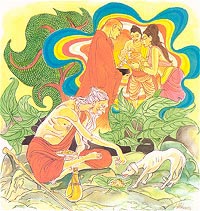
|
Verse 32. The Heedful
Advances To Nibbana
The
bhikkhu liking heedfulness,
seeing fear in heedlessness,
never will he fall away,
near is he to Nibbana.
Explanation:
The monk as the seeker after the truth, see fear in lack of mindfulness. He
will certainly not fall back from any spiritual heights he has already
reached. He is invariably in the proximity of Nibbana.
Dhammapada
Verse 32
Nigamavasitissatthera Vatthu
Appamadarato bhikkhu
pamade bhayadassi va
abhabbo parihanaya1
nibbanasseva santike.
Verse
32: A bhikkhu who takes delight in mindfulness and sees danger in negligence
will not fall away; he is, indeed, very close to Nibbana.
1. abhabbo
parihanaya: Unable to fall away; here it means, unable to fall away from
the practice of Tranquillity and Insight Development and the benefits
thereof, i.e., Magga and Phala. (The Commentary)
The
Story of Thera Nigamavasitissa
While
residing at the Jetavana monastery, the Buddha uttered Verse (32) of this
book, with reference to Thera Nigamavasitissa.
Nigamavasitissa
was born and brought up in a small market town near Savatthi. After becoming
a bhikkhu he lived a very simple life, with very few wants. For alms-food, he
used to go to the village where his relatives were staying and took whatever
was offered to him. He kept away from big occasions. Even when Anathapindika
and King Pasenadi of Kosala made offerings on a grand scale, the thera did not
go.
Some
bhikkhus then started talking about the thera that he kept close to his
relatives and that he did not care to go even when people like Anathapindika
and King Pasenadi were making offerings on a grand scale, etc. When the
Buddha was told about this, he sent for the thera and asked him. The thera
respectfully explained to the Buddha that it was true he frequently went to
his village, but it was only to get alms-food, that when he had received
enough food, he did not go any further, and that he never cared whether the
food was delicious or not. Whereupon, instead of blaming him, the Buddha
praised him for his conduct in the presence of the other bhikkhus. He also
told them that to live contentedly with only a few wants is in conformity
with the practice of the Buddha and the Noble Ones (Ariyas), and that all
bhikkhus should, indeed, be like Thera Tissa from the small market town. In
this connection, he further related the story of the king of the parrots.
Once
upon a time, the king of the parrots lived in a grove of fig trees on the
banks of the Ganges river, with a large number of his followers. When the
fruits were eaten, all the parrots left the grove, except the parrot king,
who was well contented with whatever was left in the tree where he dwelt, be
it shoot or leaf or bark. Sakka, knowing this and wanting to test the virtue
of the parrot king, withered up the tree by his supernormal power. Then,
assuming the form of geese, Sakka and his queen, Sujata, came to where the
parrot king was and asked him why he did not leave the old withered tree as
the others had done and why he did not go to other trees which were still
bearing fruits. The parrot king replied, “Because of a feeling of
gratitude towards the tree I did not leave and as long as I could get just
enough food to sustain myself I shall not forsake it. It would be ungrateful
for me to desert this tree even though it be inanimate.”
Much
impressed by this reply, Sakka revealed himself. He took water from the
Ganges and poured it over the withered fig tree and instantly, it was
rejuvenated; it stood with branches lush and green, and fully decked with
fruits. Thus, the wise even as animals are not greedy; they are contented
with whatever is available.
The
parrot king in the story was the Buddha himself; Sakka was Anuruddha.
Then the Buddha spoke in verse as follows:
|
Verse 32: A bhikkhu who takes delight in mindfulness and
sees danger in negligence will not fall away*, he is, indeed, very close to
Nibbana.
|
At
the end of the discourse, Thera Tissa attained arahatship.
*
will not fall away: It means, will not fall away from Tranquillity and
Insight Development Practice and is assured of attaining Magga and Phalla.
(The Commentary)
End
of Chapter Two: Mindfulness (Appamdavagga)
§ 61. {Iti 3.12; Iti 52}
This was said by the
Blessed One, said by the Arahant, so I have heard: “There are these three eyes. Which three? The eye of
flesh, the divine eye [clairvoyance], & the eye of discernment. These are
the three eyes.”
The eye of flesh, the eye divine, the eye of
discernment unsurpassed: these three eyes were taught by the Superlative
Person. The arising of the eye of flesh is the path to the eye divine. When
knowledge arises, the eye of discernment unsurpassed: whoever gains this eye
is — from all suffering & stress — set free.
|
|
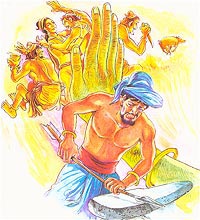
|
Verse 33. The Wise Person Straightens The Mind
Mind agitated, wavering,
hard to guard and hard to check,
one of wisdom renders straight
as arrow-maker a shaft.
Explanation: In the
Dhammapada there are several references to the craftsmanship of the fletcher.
The Buddha seems to have observed the process through which a fletcher
transforms an ordinary stick into an efficient arrow-shaft. The disciplining
of the mind is seen as being a parallel process. In this stanza the Buddha
says that the wise one straightens and steadies the vacillating mind that is
difficult to guard, like a fletcher straightening an arrow-shaft.
|
|
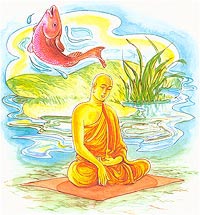
|
Verse 34. The Fluttering Mind
As fish from watery
home
is drawn and cast upon the land,
even so flounders this mind
while Mara’s Realm abandoning.
Explanation: When
making an effort to abandon the realm of Mara (evil), the mind begins to
quiver like a fish taken out of the water and thrown on land.
Dhammapada Verses 33
and 34
Meghiyatthera Vatthu
Phandanam capalam
cittam
durakkham1 dunnivarayam2
ujum karoti3 medhavi
usukarova tejanam.
Varijova thale
khitto
okamokata ubbhato
pariphandatidam cittam
maradheyyam pahatave.
Verse 33: The mind
is excitable and unsteady; it is difficult to control and to restrain. The
wise one trains his mind to be upright as a fletcher straightens an arrow.
Verse 34: As a fish
quivers when taken out of its watery home and thrown on to dry ground, so
does the mind quiver when it is taken out of the sensual world to escape from
the realm of Mara (i.e., kilesa vatta, round of moral defilements).
1. durakkham: difficult
to keep the mind fixed on a single object when meditating.
2. dunnivarayam: difficult
to restrain the mind from drifting towards sensual pleasures.
3. ujum karoti:
straightens:
(a) the fletcher straightens the arrow,
(b) the wise man trains his sensuous, unruly mind by
means of Tranquillity and Insight Development Practice (Samatha and
Vipassana). (The Commentary)
The Story of Thera
Meghiya
While residing on
the Calika Mountain, the Buddha uttered Verses (33) and (34) of this book,
with reference to Thera Meghiya.
At that time, Thera
Meghiya was attending upon the Buddha. On one occasion, on his return from alms-round,
the thera noticed a pleasant and beautiful mango grove, which he thought was
an ideal spot for meditation. He asked the Buddha’s permission to let him go
there, but as the Buddha was alone at that time, he was told to wait for
awhile until the arrival of some other bhikkhus. The thera was in a hurry to
go and so he repeated his request again and again, until finally the Buddha
told him to do as he wished.
Thus, Thera Meghiya
set out for the mango grove, sat at the foot of a tree and practised meditation.
He stayed there the whole day, but his mind kept wandering and he made no
progress. He returned in the evening and reported to the Buddha how all the
time he was assailed by thoughts associated with the senses, ill will and
cruelty (kama vitakka, byapada vitakka and vihimsa vitakka).
So, the Buddha told
him that as the mind is easily excitable and fickle, one should control one’s
mind.
Then the Buddha spoke in verse as follows:
|
Verse 33: The mind is excitable and
unsteady; it is difficult to control and to restrain. The wise one trains
his mind to be upright as a fletcher straightens an arrow.
|
|
|
|
Verse 34: As a fish quivers when taken out
of its watery home and thrown on to dry ground, so does the mind quiver
when it is taken out of the sensual world to escape from the realm of Mara
(i.e., kilesa vatta, round of moral defilements).
|
At the end of the
discourse, Thera Meghiya attained Sotapatti Fruition.
§ 62. {Iti 3.13; Iti 52}
This was said by the
Blessed One, said by the Arahant, so I have heard: “There are these three faculties. Which three? The
faculty of ‘I am about to know what is not yet finally known,’ the faculty of
final knowledge, the faculty of one who has finally known.[1] These are the three
faculties.”
For a learner in
training along the straight path: first, the knowledge of ending; then,
immediately, gnosis; then, from the ending of the fetter — becoming — there’s
the knowledge, the gnosis of one released who is Such:[2] One consummate in these
faculties, peaceful, enjoying the peaceful state, bears his last body, having
conquered Mara along with his mount.
Notes
1.
According to the Commentary, the first of these faculties
corresponds to the first noble attainment, the path to stream-entry; the
second, to the next six attainments, ranging from the fruition of
stream-entry to the path to arahantship; and the third, to the highest
attainment, the fruition of arahantship.
2.
Such (tadi): see the note to §44.
§ 63. {Iti 3.14; Iti 53}
This was said by the
Blessed One, said by the Arahant, so I have heard: “There are these three times. Which three? Past time,
future time, & present time. These are the three times.”
Perceiving in terms
of signs, beings take a stand on signs. Not fully comprehending signs, they
come into the bonds of death. But fully comprehending signs, one doesn’t
construe a signifier. Touching liberation with the heart, the state of peace
unsurpassed, consummate in terms of signs, peaceful, enjoying the peaceful
state, judicious, an attainer-of wisdom makes use of classifications but
can’t be classified.[1]
Note
1.
At first glance, the verses here do not bear much relationship
to the prose introduction. However, if they are viewed in the context of MN 2 (see the note to §16), their
relationship becomes clear: the person who applies appropriate attention to
the notion of past, present, and future time does not define him or herself
in those terms, and so does not cling to any sense of self in those terms.
Without clinging, one is liberated from birth and death.
|














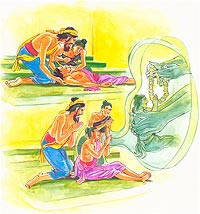
e’s father,












 a on the outskirts of New Delhi on Tuesday
a on the outskirts of New Delhi on Tuesday














 of BSP!
of BSP!







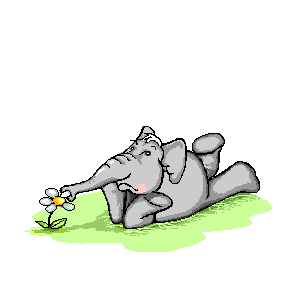








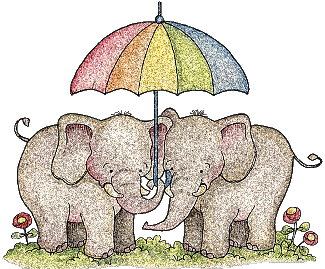


























































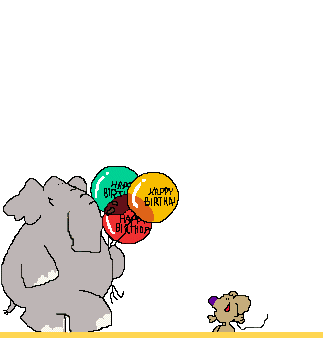



























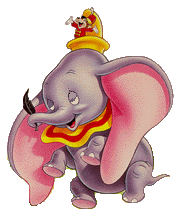








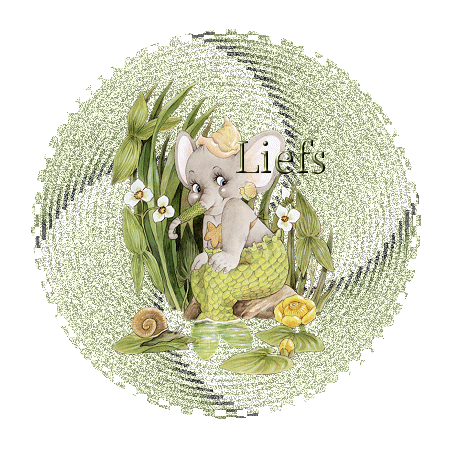





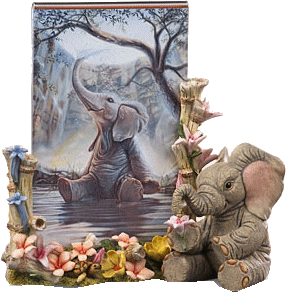




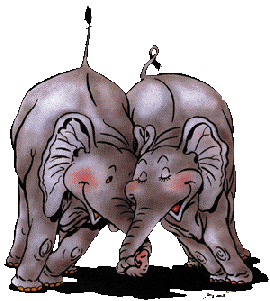








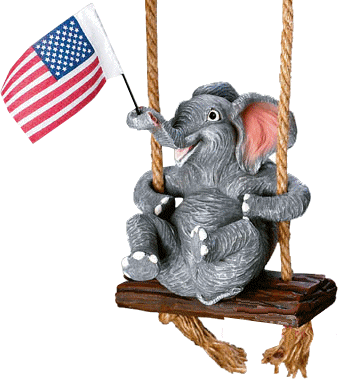



















































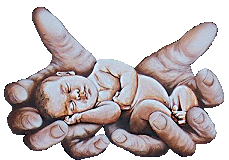













































































 , is a direction of the Shastras. The Mandal therefore knows from whom a
, is a direction of the Shastras. The Mandal therefore knows from whom a  .
.








 is an injunction issued to the
is an injunction issued to the  ].
].






